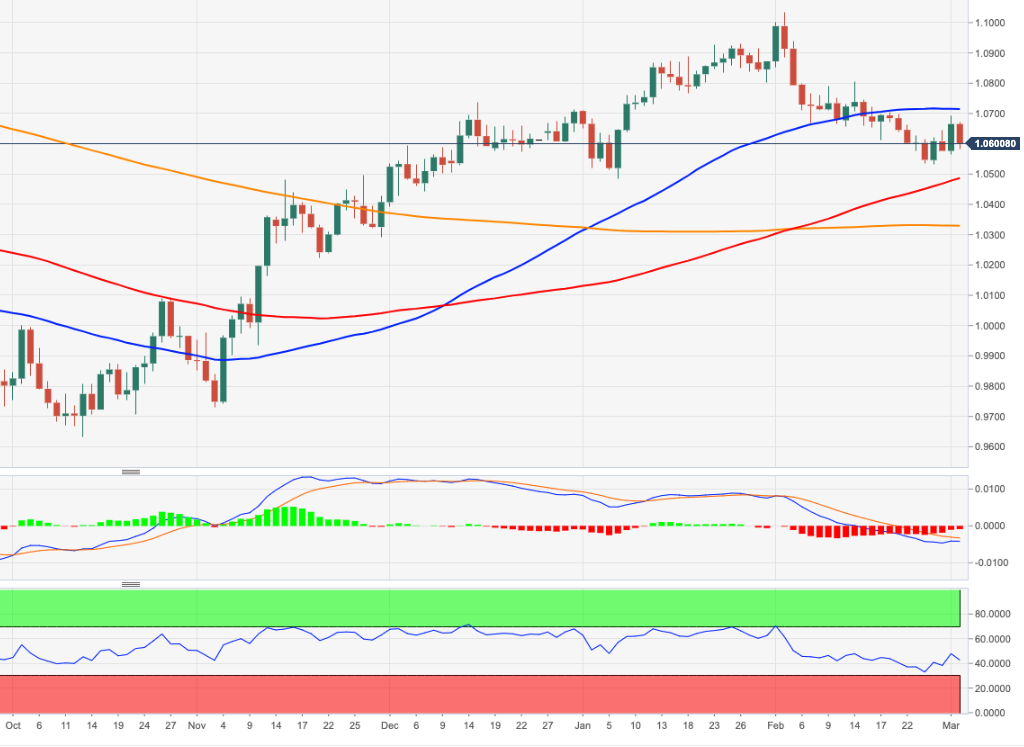- Analytics
- News and Tools
- Market News
CFD Markets News and Forecasts — 02-03-2023
- AUD/JPY remains sidelined after reversing from the key SMA earlier in the week, retreats of late.
- Clear downside break of bullish triangle, looming bear cross on the MACD.
- Bulls need validation from 93.10 for conviction, sellers may eye two-month-old support past 200-SMA break.
AUD/JPY bulls run out of steam around 96.00, even as the weekly performance appears mildly bid during early Friday. In doing so, the cross-currency pair signals the bear’s return, following a failure to defend the bounce off the 200-SMA, as well as amid downbeat oscillators and a clear break of the six-week-old bullish triangle.
That said, the quote drops toward the 200-bar Simple Moving Average (SMA) support near 91.60. However, the double bottoms marked during early February near 90.20-25 by the press time, could challenge the pair sellers.
Adding to the downside filter is the ascending support line from early January, close to 89.95 by the press time.
It should be observed that a successful break of the multi-day-old support line won’t hesitate to challenge the year 2023 low surrounding 87.40.
On the flip side, the lower line of the aforementioned bullish triangle, close to 92.65 at the latest, will precede the stated chart formation’s top line, around 93.10, to challenge the AUD/JPY buyers.
Should the quote remains firmer past 93.10, the mid-December 2022 swing high of 93.35 may act as the last defense of the AUD/JPY bears.
Overall, AUD/JPY remains on the bear’s radar even if the 200-SMA restricts immediate downside.
AUD/JPY: Four-hour chart

Trend: Further downside expected
- AUD/USD has rebounded after sensing a cushion around 0.6700 amid a recovery in investors’ risk appetite.
- Hopes for a bullish reversal will be fueled further in case AUD/USD delivers a break above the 50-EMA.
- A 40.00-60.00 range oscillation by the RSI (14) indicates indecisiveness among the market participants.
The AUD/USD pair has shown a recovery move after defending the round-level support of 0.6700 in the early Asian session. A loss in the downside momentum is exhausted, however, the Aussie asset would get a sense of confidence only after a confident break above the immediate resistance of 0.6740.
S&P500 futures are displaying nominal losses after a meaningful recovery, portraying a caution in the overall risk appetite theme. The struggle from the US Dollar Index (DXY) for recapturing the 105.00 resistance continues amid a recovery in the risk-on market mood. Meanwhile, the 10-year US Treasury yields are looking to continue their upside momentum above 4.06%.
A double bottom chart formation on a two-hour scale by AUD/USD around March 01 low at 0.6700 has triggered the case of a bullish reversal. The Australian Dollar tested March 01 low at 0.6700 with less selling pressure, which propelled the responsive buying from the market participants. The downward-sloping trendline plotted from February 14 high at 0.7030 has acted as a major barricade for the Australian Dollar.
Hopes for a bullish reversal will be fueled further in case the AUD/USD pair delivers a break above the 50-period Exponential Moving Average (EMA) at 0.6750.
The Relative Strength Index (RSI) (14) is still oscillating in the 40.00-60.00, indicating indecisiveness among the market participants.
A confident break above March 01 high at 0.6784 will send the asset toward the round-level resistance at 0.6800 followed by February 06 low at 0.6855.
In an alternate scenario, a slippage below March 01 low around 0.6700 will drag the Aussie toward December 07 low at 0.6669 and December 20 low at 0.6629.
AUD/USD two-hour chart
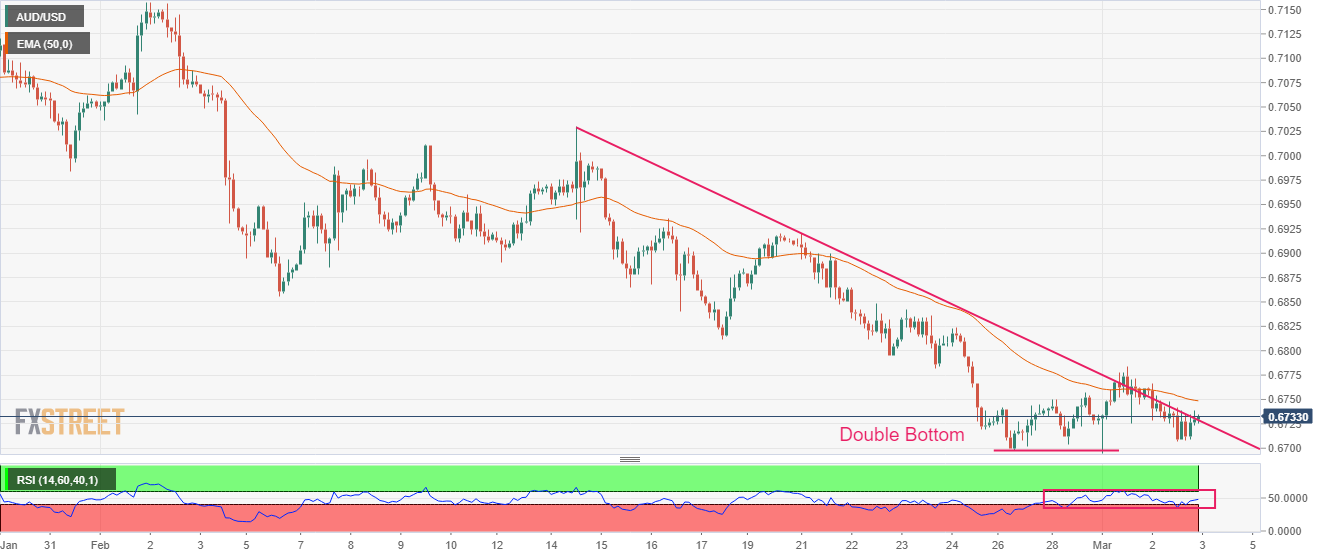
- Western Texas Intermediate advanced 0.21%, despite overall US dollar demand.
- WTI was bolstered by China’s re-opening and dovish remarks from Fed’s Bostic.
- Overall US Dollar strength due to elevated US Treasury bond yields capped WTI’s rally.
Western Texas Intermediate (WTI) clings to minuscule gains after rallying for three consecutive days, up 0.21%. The US crude oil benchmark is almost flat due to US jobs data that lifted UST bond yields above the 4% threshold that underpinned the greenback. However, upbeat data from China kept the black gold from printing losses. At the time of writing, WTI exchanges hands at $77.86 pb.
WTI’s advances on China’s demand and dovish remarks from Fed’s Bostic
China’s activity improved, as shown by Caixin Manufacturing, which rose for the first time in seven months. In the meantime, China’s imports of Russian oil are set to hit a record high in March, as its re-opening increased oil demand, hence the jump in prices.
WTI’s rally was capped in the early morning as the US Bureau of Labor Statistics (BLS) showed that unemployment claims were lower than expected, spurring speculations that the Federal Reserve (Fed) would raise rates above 5.50%
But comments from Atlanta’s Fed President Raphael Bostic, opening the door for the Fed pausing rates sometime this summer, kept WTIs from entering negative territory.
Investors’ worries dented sentiment in the European session, as inflation data for the Eurozone (EU) easied but remained almost four times higher than the 2.00% target imposed on the European Central Bank (ECB).
Fed and ECB to raise rates above initial estimates
Traders’ focus has turned to how high-interest rates in the US and Europe will get. Swaps markets are pricing that the Federal Reserve would peak at 5.5% in September, while other traders expect rates to hit 6%. On the ECB front, rates are expected to go as high as 4% or above.
WTI Technical levels
“The European Central Bank (ECB) could consider raising its key interest rate as high as 4% if underlying inflation in the euro zone remains persistently high,” said ECB Governing Council member Pierre Wunsch early Friday in Asia per Reuters.
“If the core inflation would remain at the level we see today in Europe of above 5%, and if we don't get clear signals that core inflation is going down, we will have to do more,” added the Belgian national bank Governor Wunsch in a news conference at the bank said Reuters.
ECB’s Wunsch also said, “For me, looking at rates of 4% would not be excluded but I want to insist I won't make any judgment on where the rates would have to go without seeing the developments of core inflation.”
EUR/USD grinds lower
Given the early hours of trading, the EUR/USD pair fails to react to the news and grinds near the 1.0600 mark. However, the bears seem to have run out of fuel of late.
Also read: EUR/USD pares weekly gains around 1.0600 as ECB, Fed officials back higher rates to tame inflation
- USD/CHF retreats from multi-day top as US Dollar bulls run out of steam.
- US Treasury bond yields underpin bullish bias by refreshing multi-day high, before easing from the latest peak.
- Mixed Fed talks, US data probe pair buyers as the key PMI figures loom.
USD/CHF remains sidelined around 0.9420 during early Friday, after retreating from the Year-To-Date (YTD) high before a few hours. That said, the Swiss currency pair rose to the three-month high the previous day amid broad-based US Dollar run-up but mixed comments from the Fed officials joined unimpressive US data to challenge the bulls afterward. Also challenging the quote could be the cautious mood ahead of the key US ISM Services PMI for February.
The comments from Federal Reserve Bank of Atlanta President Raphael Bostic challenged the market’s hawkish Federal Reserve (Fed) bias as the policymaker said the central bank could be in position to pause the current tightening cycle by mid to late summer. On the other hand, Boston Fed President Susan Collins said on Thursday that more rate hikes are required to bring inflation back in control. She added that the extent of interest rate hikes will be determined by incoming data.
Talking about the US data, the US Jobless Claims dropped to 190K during the week ended on February 24 versus 195K market forecasts and 192K prior. Further, Nonfarm Productivity for the fourth quarter (Q4) eased to 1.7% from 3.0% prior and 2.6% market forecasts while the Unit Labor Costs jumped 3.6% versus 1.6% analysts’ estimations and 1.1% previous readings.
Elsewhere, the US-China tension at the Group of 20 Nations (G20) meeting, amid the former’s push for sanctions on countries having strong ties with Russia and aiding Moscow in war with Ukraine, previously probed the sentiment. However, the dovish Fed comments and chatters of the Sino-American trade talks seemed to have triggered a risk-on mood afterward.
Amid these plays, Wall Street closed on the positive side, after a downbeat start, whereas the S&P 500 Futures printed mild losses by the press time. Further, US 10-year Treasury bond yields rose to a fresh high since early November 2022 while piercing the 4.0% threshold whereas the two-year counterpart rallied to the highest levels since 2007 to 4.94%. However, the bond coupons have retreated from their multi-month high of late.
Moving on, USD/CHF traders should pay attention to the US ISM Services PMI for February, expected 54.5 versus 55.2.
Also read: ISM Services PMI Preview: Strong figure set to catapult US Dollar to new highs
Technical analysis
As the higher high of the USD/CHF price fails to gain support from the higher high of the RSI (14) line, the Swiss currency pair’s further upside appears doubtful. Further, the 100-DMA hurdle surrounding 0.9435 adds to the upside filters for the pair traders to watch.
- Gold is trapped between hourly support and resistance.
- The bulls are relying on a move above $1,837 while bears seek a break below $1,831.
Gold price is holding in a bullish territory after climbing from the start of the week's low near $1,823 and reaching a high of $1,844. However, the yellow metal finished with a loss on Thursday, following three three-day winning streak, as strength in the U.S. dollar weighed. The US Dollar Index, DXY,a measure of the greenback's strength against a basket of rivals, gained 0.6% to 105.102
The greenback and bond yields rose on expectations of higher interest rates due to a series of unexpectedly robust economic reports that have hit the screens in recent weeks that may prompt a more hawkish response from the central bank. The data has been promoted Fed member Kashkari (voter) to review his prior dovish stance who said he is open to a 50bps hike at the March meeting. Still, he emphasized that the terminal rate is more important than the size of rate hikes.
Analysts at ANZ Bank said that the data is likely to keep pressure on the Fed to raising rates. ''A stronger USD and higher yields were also headwinds for investor demand of the precious metal.'' Indeed, the US rate futures have priced in a peak fed funds rate of 5.4% hitting in September. The market has all but priced out Federal Reserve rate cuts this year. The Federal Reserve sentiment is keeping the greenback in the hands of the bulls as marked price in the notion that the central bank will have to raise interest rates more than initially expected.
Gold technical analysis
As per the prior Gold price analysis, Gold price rallied as follows:
Gold prior analysis
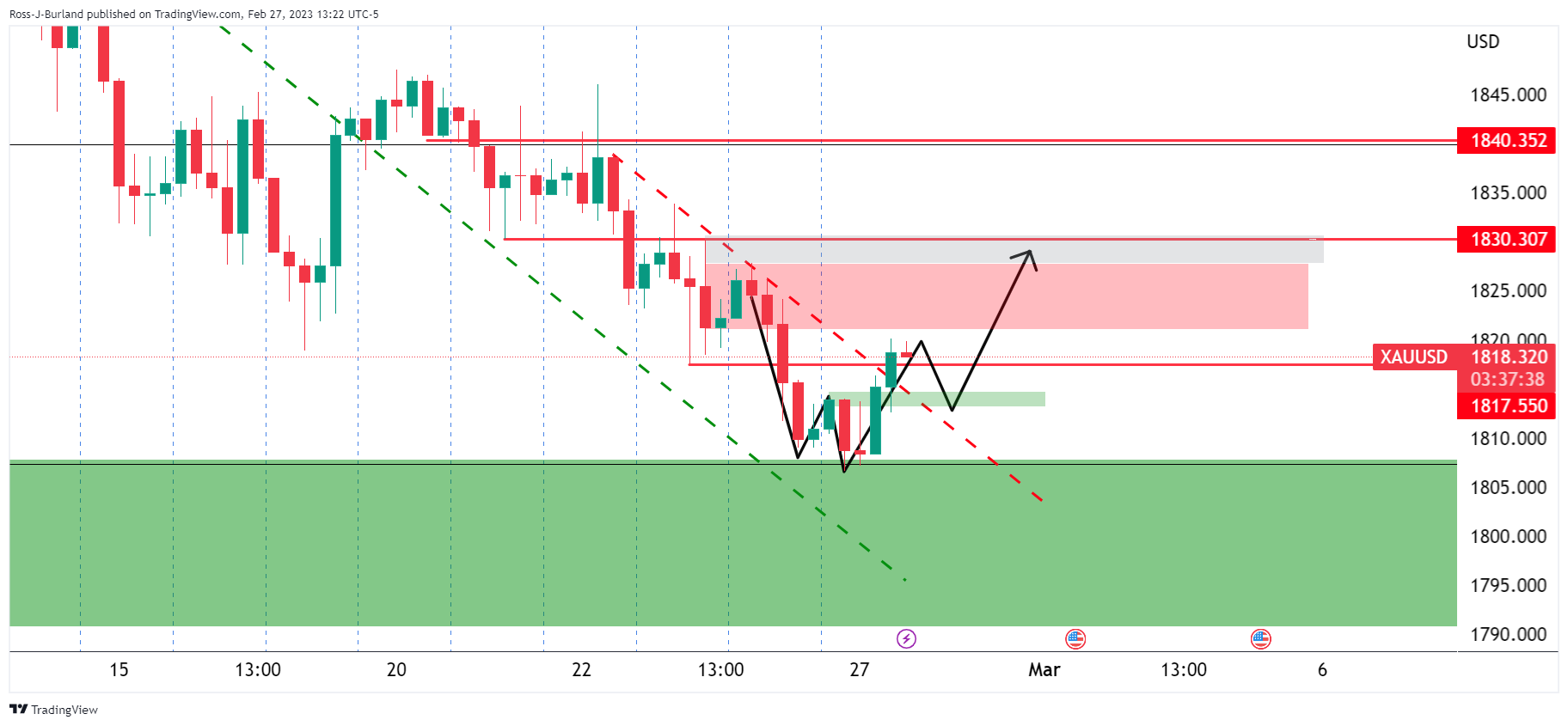
The prior Gold price analysis said ''the double bottom near the $1,800 psychological Gold price level is offering a compelling case for a move towards the $1,830s, a touch above the January opening lows. However, a retest of the W-formation's neckline could be on the cards first.''
Gold price update
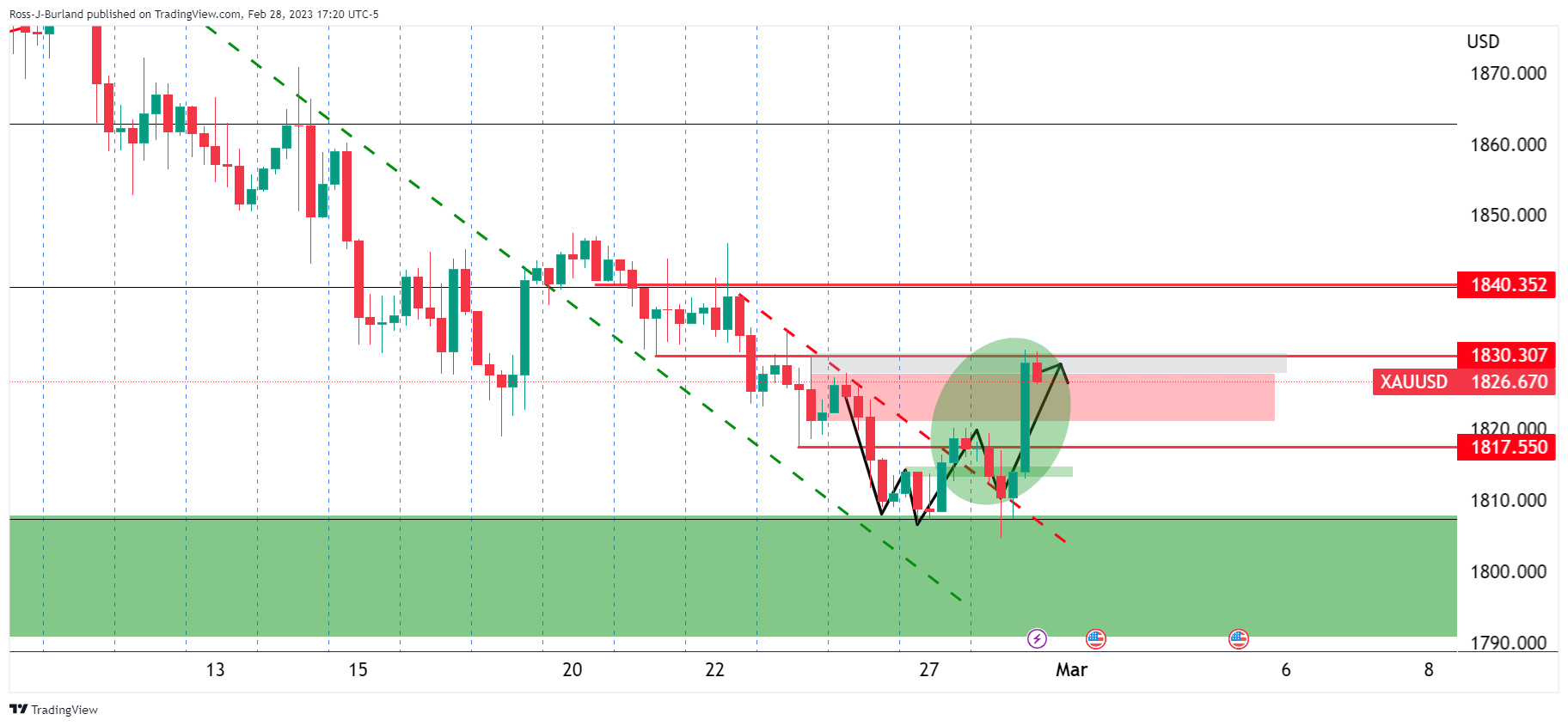
As illustrated, the Gold price burst higher after the correction and offered bulls an opportunity in late European and US markets to the target area. At this juncture, the correction has met prior resistance and is now trapped as follows:
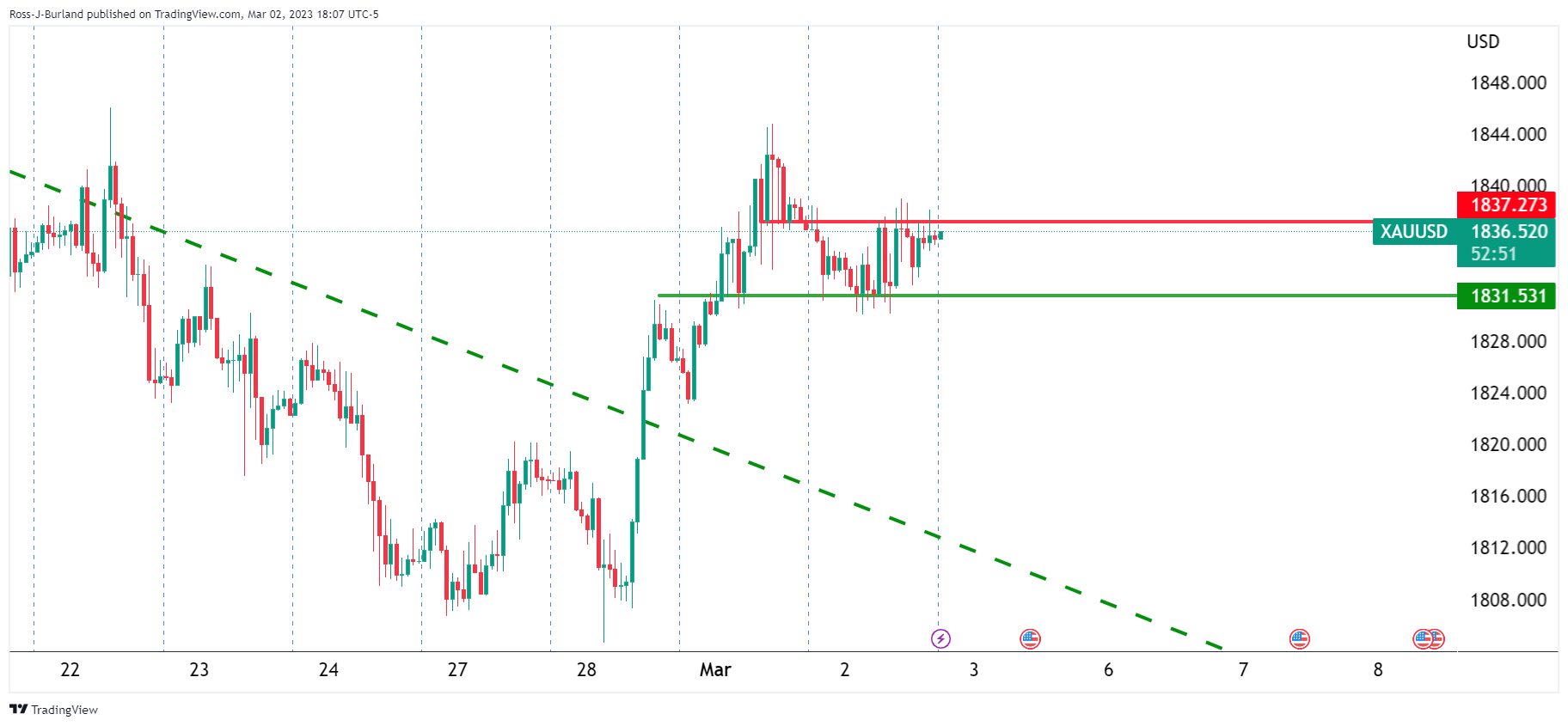
- EUR/JPY has sensed a pause in its gradual decline below 145.00 ahead of Tokyo's Inflation.
- A surprise rise in Eurozone inflation has bolstered the case of more rates from the ECB.
- ECB Lagarde reiterated that a 50 bps rate hike for March is on the table as inflation is still too high.
The EUR/JPY pair is displaying a sideways auction in a range below 145.00 in the early Tokyo session. The cross declined on Thursday after failing to sustain above Tuesday’s high at around 145.50. The downside pressure in the Euro came after the release of the Eurozone Harmonized Index of Consumer Prices (HICP) data.
The preliminary Eurozone HICP (Feb) landed at 8.5%, surpassing the consensus of 8.2% but remaining lower than the prior release of 8.6%. Earlier this week, nations like Germany, Spain, and France reported their HICP figures well above the estimates and the former releases. This indicates that the Eurozone inflation is getting stubborn after some declining moves and more rates from the European Central Bank (ECB) are highly required to cool down the stick inflation.
ECB President Christine Lagarde reiterated on Thursday “The case for a 50 bps rate hike this month is still on the table as inflation is still too high.” She further added, “We have to use all tools at our disposal to bring inflation down and we don’t know the peak for rates yet.”
Analysts at Danske Bank expect ECB’s deposit rate to peak at 4%, after a 50 basis points interest rate hike, in both March and May followed by a 25bp hike in both June and July.
On the Tokyo front, investors are awaiting the release of the Tokyo Consumer Price Index (CPI) for fresh impetus. Tokyo’s headline Consumer Price Index (CPI) (Feb) is expected to decline to 4.1% from the prior release of 4.4%. The Japanese economy is struggling to accelerate domestic demand despite immense initiatives from Bank of Japan (BoJ) policymakers and the administration and an escalation in the price pressures is coming from rising import prices.
- GBP/JPY is about to finish the week almost flat.
- A multi-month downslope resistance trendline has held the GBP/JPY from re-testing YTD highs.
- GBP/JPY Price Analysis: Failure to crack 164.00 can pave the way for further downside.
The GBP/JPY was rejected around 163.90s, dropping towards the mid 163.00-164.00 range as the Asian Pacific session is about to begin. A risk-off impulse in the FX space spurred a flight to safe-haven peers, like the Japanese Yen (JPY). At the time of typing, the GBP/JPY exchanges hands at 163.30.
GBP/JPY Price Action
After peaking in the week around 166.00, the GBP/JPY lost traction and extended its losses below 164.00, but the bias is still neutral to upwards. The 20-day Exponential Moving Average (EMA) at 162.00 is aiming north, 16 pips shy of the 100-day EMA. Once cleared, the GBP/JPY could continue to aim higher, but it is facing solid resistance at a five-month-old downslope resistance trendline at around 164.00.
The GBP/JPY needs to crack the trendline for a bullish continuation. Achievement of that, the GBP/JPY next resistance would be the psychological 165.00 figure, followed by the YTD high at 166.00.
Conversely, the GBP/JPY first support would be an upslope trendline drawn from mid-February. A breach of the latter will expose the 100-day Exponential Moving Average (EMA) at 162.16, followed by the 20-day EMA at 162.00.
GBP/JPY Daily chart
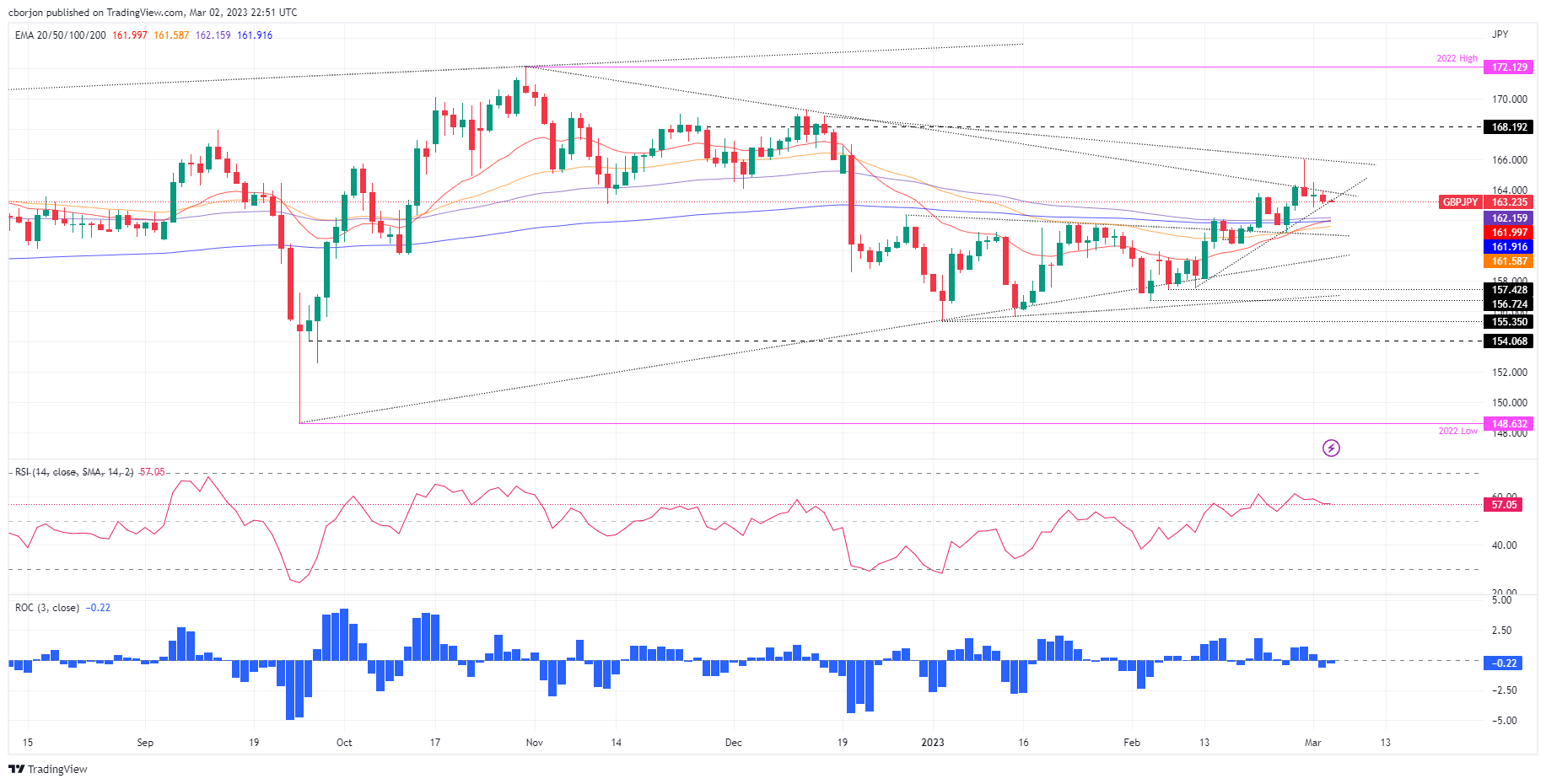
GBP/JPY Technical levels
- USD/CAD holds lower ground as sellers attack bullish chart pattern.
- Bearish MACD signals, downbeat RSI hints at rejection of pennant formation but 50-SMA can test the bears.
- Multiple hurdles to the north challenge Loonie pair buyers.
USD/CAD bears flex muscles around 1.3590 amid the early Asian session on Friday, poking the lower line of a one-week-old bullish pennant.
That said, the Loonie pair’s multiple failures to stay beyond 1.3600, as well as the recent grinding near the highest levels since early January, suggest that the bulls are running out of steam. Additionally, the bearish MACD signals and the RSI (14) conditions suggesting the continuation of the latest weakness by staying around the neutral 50 level also signal further declines of the quote.
However, the 50-bar Simple Moving Average (SMA) level surrounding 1.3570 could test the USD/CAD pair sellers ahead of the late February swing low near 1.3515 and the 1.3500 round figure.
In a case where the quote breaks the 1.3500 threshold, the odds of its slump to the 1.3440-35 support zone can’t be ruled out. It should be noted that the 200-SMA joins multiple levels marked since mid-February to highlight the stated support area.
Meanwhile, recovery moves remain unimpressive unless the quote stays inside the bullish pennant, currently between 1.3595 and 1.3635.
Following that, the highs marked during late February and early January, respectively near 1.3665 and 1.3685 will precede the December 2022 peak of 1.3705 to check the USD/CAD pair’s upside momentum.
USD/CAD: Daily chart

Trend: Further downside expected
- GBP/USD pair has dropped to near weekly low around 1.1922 despite easing risk-off mood.
- Consideration of policy slowdown or a pause in the policy tightening spell by the BoE could push Sterling on the back foot.
- The Cable is hovering near the horizontal support of the Descending Triangle plotted from 1.1920.
The GBP/USD pair has dropped to near weekly low around 1.1922 in the early Asian session. The Cable is expected to be dumped by the market participants as the street is anticipating a pause or a deceleration in the pace of interest rate hiking by the Bank of England (BoE) despite the fact that the United Kingdom inflation is still trending in the double-digit figure.
Analysts at Commerzbank are of the view that “Bailey is not really committing very firmly to further strong tightening measures. In view of an inflation rate in double-digits, I would have hoped for more commitment toward rate hikes. But obviously, the BoE is not willing to inflict (further) harm on the economy and the population to get a grip of inflation.”
Meanwhile, the market sentiment looks positive as risk-sensitive assets like S&P500 has shown a decent recovery on Thursday. The US Dollar Index (DXY) is struggling to recapture the 105.00 resistance as the risk aversion theme is fading gradually.
GBP/USD is auctioning near the horizontal support of the Descending Triangle chart pattern plotted from February 17 low around 1.1920 on a four-hour scale. The downward-sloping trendline of the aforementioned chart pattern is placed from the February high at 1.2402.
The 100-period Exponential Moving Average (EMA) at 1.2060 will act as a major barricade for the Pound Sterling.
Meanwhile, the Relative Strength Index (RSI) (14) has slipped below 40.00 from the 40.00-60.00 range, indicating that the bearish momentum could be triggered.
A confident break below February 17 low at 1.1915 will drag the Cable firmly towards January 5 low at 1.1875 followed by the round-level support at 1.1800.
On the contrary, a move above February 24 high at 1.2040 will drive the asset towards February 23 high around 1.2080. A breach of the latter will expose the asset to February 21 high of around 1.2140.
GBP/USD four-hour chart

- EUR/USD holds lower ground after falling the most on a day in one month.
- US data, ECB/Fed talks and EU figures all hint at higher rates to battle inflation woes.
- Light calendar, macro could restrict market moves ahead of US ISM Services PMI.
- Next week’s Fed Chair Powell’s testimony, US NFP are crucial.
EUR/USD treads water around 1.0600, after posting the biggest daily loss in a month, as traders await more clues amid the battle between the hawks of the European Central Bank (ECB) and the Federal Reserve (Fed). That said, the quote dropped heavily the previous day but couldn’t rule out the weekly gains amid the US Dollar’s limited capacity to win the bids, despite strong US Treasury bond yields and hawkish Fed commentary. With this, the Euro pair remains sidelined during the initial hour of Friday’s Asian session after pausing the bears around 1.0575 a few minutes back.
On Thursday, United States Treasury bond yields rallied multi-month high amid escalating fears of inflation and higher rates from major central banks, mainly from the Fed. The same allowed the US Dollar to post the biggest daily jump since early February. However, late Thursday’s comments from Federal Reserve Bank of Atlanta President Raphael Bostic joined the cautious mood ahead of the US ISM Services PMI for February to probe the greenback bulls afterward.
The benchmark US 10-year Treasury bond yields rose to a fresh high since early November 2022 while piercing the 4.0% threshold whereas the two-year counterpart rallied to the highest levels since 2007 to 4.94%. It should be noted that the strong yields initially weighed on the US equities but the comments from Fed’s Bostic allowed Wall Street to close on a positive side.
Fed’s Bostic said on Thursday that the central bank could be in position to pause the current tightening cycle by mid to late summer. On the other hand, Boston Fed President Susan Collins said on Thursday that more rate hikes are required to bring inflation back in control. She added that the extent of interest rate hikes will be determined by incoming data.
Other than the hawkish Fed, US data suggesting a tight labor market and higher wage costs also underpinned the inflation woes and helped the US Dollar to remain firm. On Thursday, US Jobless Claims dropped to 190K during the week ended on February 24 versus 195K market forecasts and 192K prior. Further, Nonfarm Productivity for the fourth quarter (Q4) eased to 1.7% from 3.0% prior and 2.6% market forecasts while the Unit Labor Costs jumped 3.6% versus 1.6% analysts’ estimations and 1.1% previous readings.
In the case of the Eurozone, the latest accounts of the ECB February policy meeting were published on Thursday and stated, “Governing Council members agreed that further increases in key rates are required for policy to enter restrictive territory,” reported Reuters.
On the same line, European Central Bank (ECB) President Christine Lagarde, said in an interview with Spanish TV on Thursday that the case for a 50 bps rate hike this month is still on the table as inflation is still too high.
Talking about the data, the annualized Eurozone Harmonised Index of Consumer Prices (HICP) came in a tad lower to 8.5% in February versus 8.6% prior and 8.2% market forecasts. However, the Core HICP grew 5.6% during the said month when compared to 5.3% analysts’ expectations and previous reading. The monthly figures were quite impressive as the headline HICP jumped by 0.8% in February vs. -0.3% expectations and -0.2% previous while the core HICP arrived at 0.8% last month as against the 0% expected and -0.8% registered in January.
Looking ahead, EUR/USD traders should pay attention to the second-readings of the Eurozone and German activity numbers ahead of the US ISM Services PMI for February, expected 54.5 versus 55.2. It’s worth noting that the stated PMI allowed the US Dollar to rally the previous month after it gained support from the strong US Nonfarm Payrolls (NFP), up for publication in the next week.
Also read: ISM Services PMI Preview: Strong figure set to catapult US Dollar to new highs
Technical analysis
EUR/USD wobbles within a 130 pip trading range comprising a convergence of the 50-day and 21-day Exponential Moving Average (EMA), around 1.0660-65, as well as the 200-day EMA support surrounding 1.0535.
- NZD/USD has rebounded firmly from 0.6200 as investors’ risk appetite has improved.
- Investors are playing with the ‘value-buying’ concept and channelizing funds into some risk-sensitive assets.
- A surprise rise in the US New Orders Index will clear that the overall forward demand is in an expansionary mode.
The NZD/USD pair has sensed a buying interest near the round-level support of 0.6200 in the early Asian session. The Kiwi asset is looking to stretch its recovery above the immediate resistance of 0.6230 as the US Dollar Index (DXY) has witnessed a loss in the upside momentum. The upside in the Kiwi asset looks favored as the risk appetite of the market participants is improving.
Investors are ignoring the fact that the Federal Reserve (Fed) has no other option than to stretch interest rates further to bring down the persistent inflation. Therefore, the market participants are playing with the ‘value-buying’ concept and channelizing funds into some risk-sensitive assets. S&P500 futures have some a significant recovery in Thursday’s session, portraying a risk-on mood.
The USD Index has corrected marginally after failing to hit the critical resistance of 105.20. Also, it is struggling to sustain itself above the round-level support of 105.00. Meanwhile, the demand for US government bonds remained vulnerable on Thursday as investors see interest rates above 5% by the Fed sooner. This fueled the 10-year US Treasury yields to 4.06%.
After the release of the mixed United States ISM Manufacturing PMI, which showed that the production sector is constantly contracting but assured a stellar forward demand, investors are shifting their focus towards the US ISM Services PMI (Feb).
The economic data is seen lower at 54.5 from the former release of 55.2. The New Orders Index, which conveys the forward demand is expected to decline to 58.5 from the prior figure of 60.4. A surprise rise in the New Orders Index will clear that the overall forward demand is in an expansionary mode and could propel the Consumer Price Index (CPI) ahead.
Meanwhile, the New Zealand Dollar will display an action move over the release of the Caixin Services PMI (Feb) data. The economic data is likely to drop to 50.5 vs. the prior figure of 52.9. It is worth noting that New Zealand is one of the leading trading partners of China and a decline in the Services PMI might impact the New Zealand Dollar ahead.
- Silver is pressed up against a daily dynamic trendline resistance.
- Bulls rely on hourly structure to push higher.
Silver is down some 0.4% and topping out in the final part of the US session after a move up from today's lows of $20.674. The precious metal made a high of $21.015 while traders balance the risks associated with the Federal Reserve's interest rate policy and sentiment.
Meanwhile, from a technical outlook, the white metal is up against major resistance as the following illustrates:
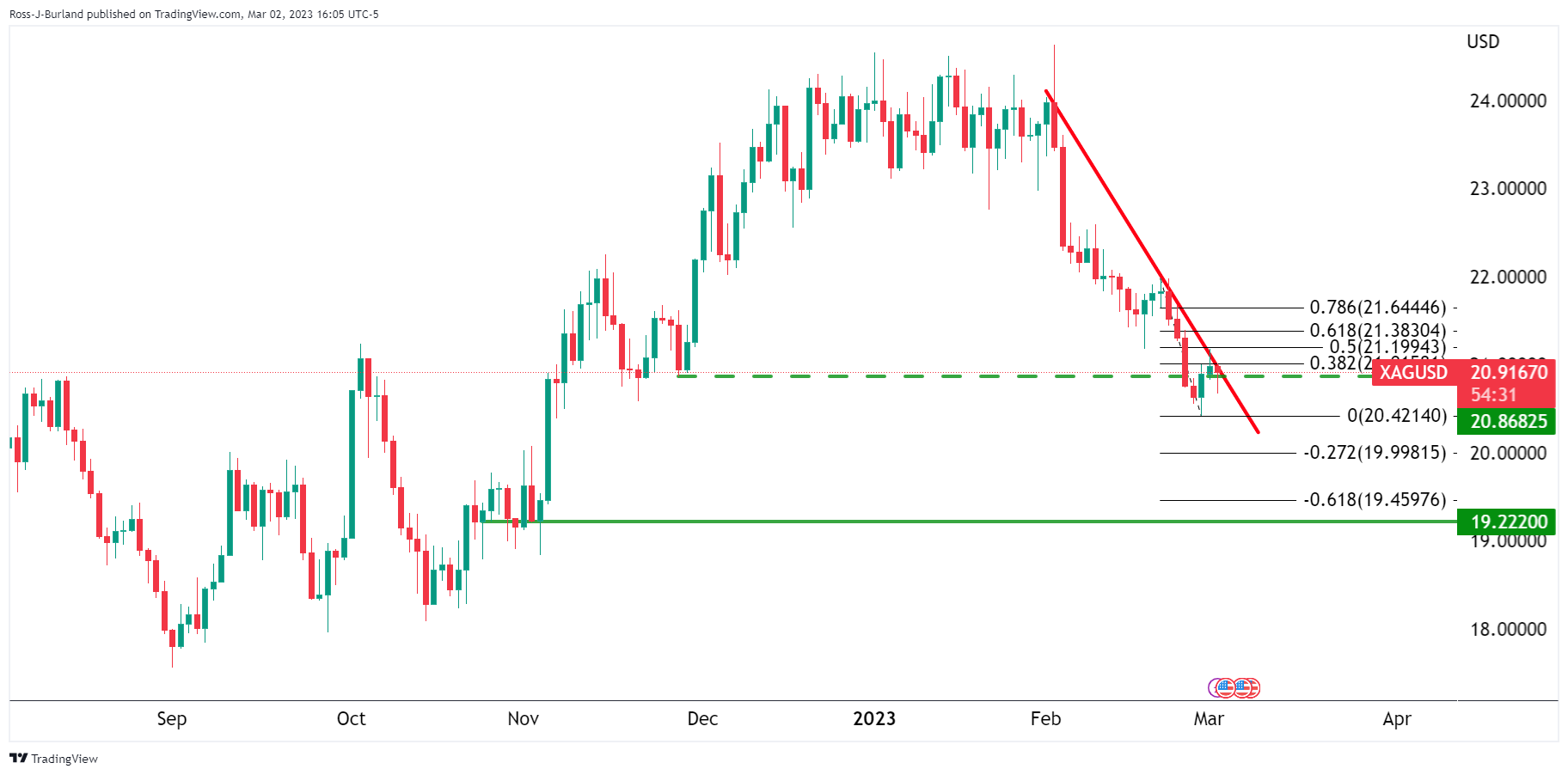
The daily charts see the metal pressed up against a daily dynamic trendline resistance as the price corrects after breaching the horizontal structure. If the bears commit around here, there will be prospects of a downside continuation:
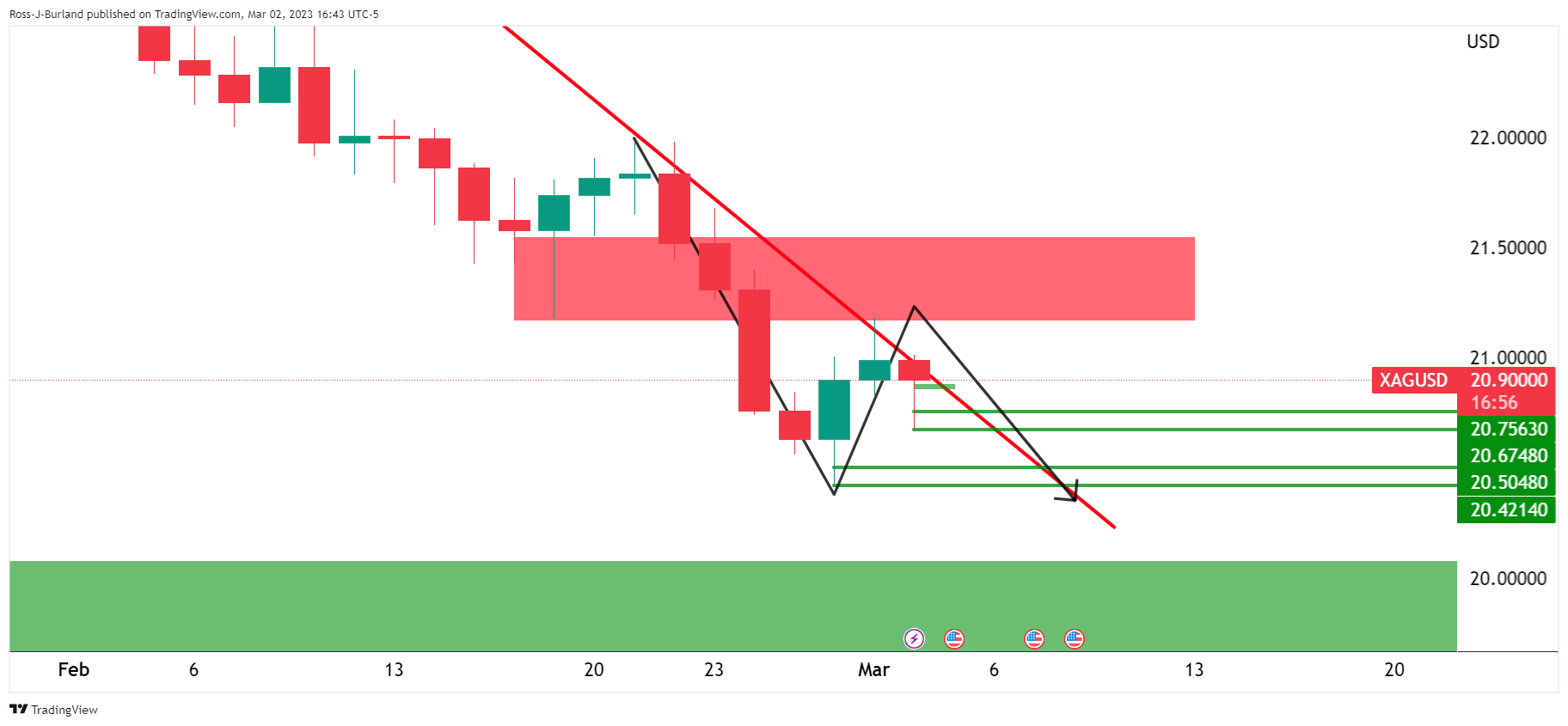
As per the hourly chart below, however, the price has broken up and there are prospects of a near term bullish continuation:
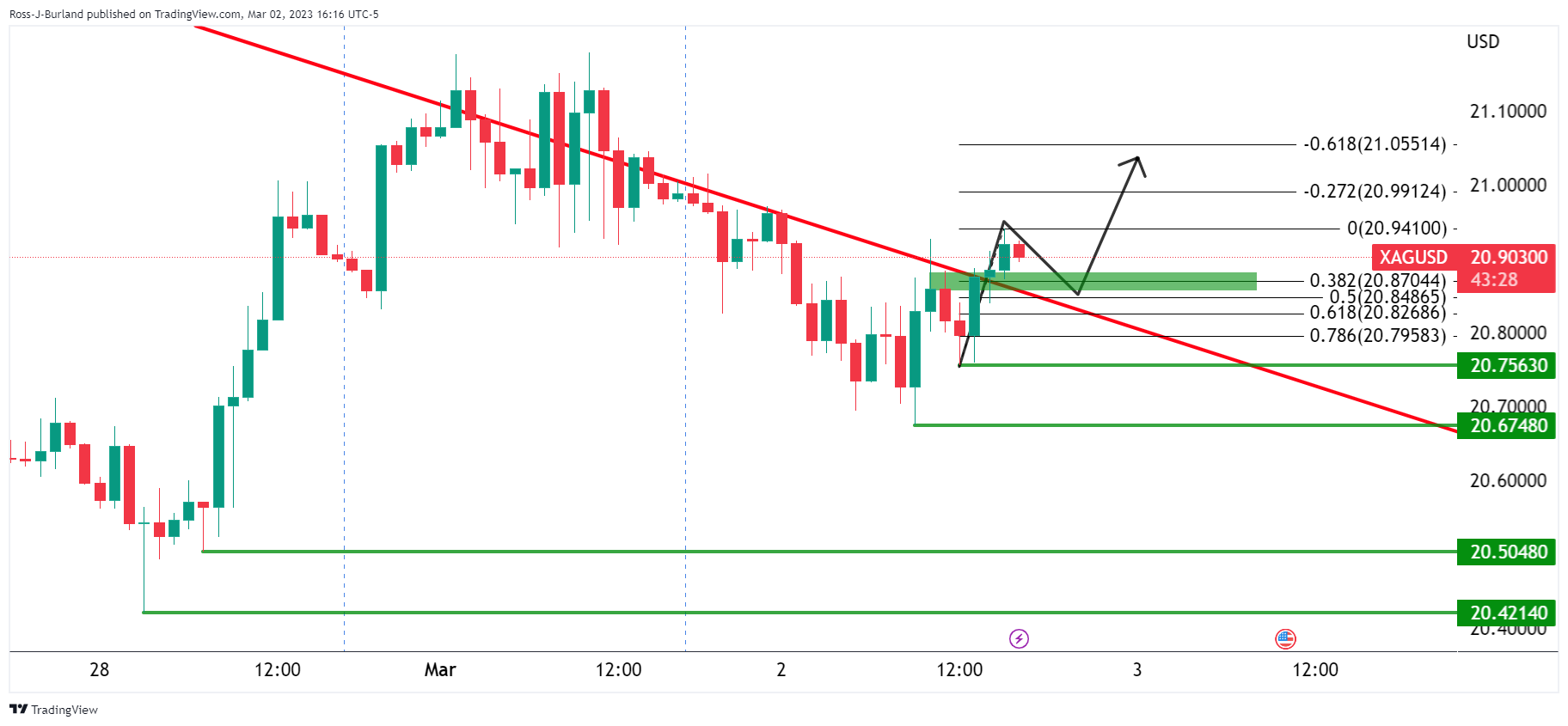
- AUD/USD fell from 0.6760s as US Treasury bond yields exploded.
- US jobless claims continued their downtrend, printing figures below estimates.
- What to watch? Australia’s PMIs, US Services PMIs, and Fed speakers.
AUD/USD found resistance at around 0.6760, dropping almost 0.40% on Thursday after solid economic data from the United States (US) was released. A tight labor market, and last week’s higher inflation figures in the US, suggest that the US Federal Reserve (Fed) still has ways to go to curb inflation. The AUD/USD exchanges hands at around 0.6730s.
AUD/USD to finish Thursday’s session with losses
Wall Street Is set to close with solid gains in Thursday’s session. Nevertheless, in the FX space, risk-perceived currencies, like the Australian Dollar (AUD), took their toll on higher US Treasury bond yields, with 2s, 5s, and 10s, staying above the 4.08% threshold. Consequently, the US Dollar rose, as shown by the US Dollar Index (DXY), up 0.57%, at 104.965.
The US docket revealed that Initial Jobless Claims for the week ending February 25 came at 190,000 below the 195,000 estimated by analysts. Following the release, US Treasury bond yields skyrocketed above the 4% mark, with 2s reaching as high as 4.90%, while the DXY hit a daily high of 105.180.
The AUD/USD edged lower and hit a daily low of 0.6706; sellers failed to extend its fall below the R1 daily pivot point at around 0.6707. nevertheless, the AUD/USD recovered some ground, on Atlanta’s Fed President Raphael Bostic saying that the Fed could be in a position to pause by mid-late summer.
Bostic added that he foresees the Federal Funds Rate (FFR) to peak at around 5.00% - 5.25% and reiterated that it will stay there “well into 2024.”
What to Watch?
The docket will feature the S&P Global Services PMI on the Australian front, while China’s data with the Caixin Services PMI will also influence the Aussie Dollar (AUD). On the US front, Fed speakers would cross newswires alongside the release of the ISM and S&P Global Services PMIs.

AUD/USD Technical levels
What you need to take care of on Friday, March 3:
The US Dollar erased recent losses and strengthened on the back of US economic data and higher US yields. The greenback held onto gains even amid a late rally in Wall Street. US yields hit fresh highs, with the 30-year rising above 4% and the 2-year at fresh multi-year highs above 4.90%. The DXY rose more than 0.50%, stabilizing around 105.00.
Initial Jobless Claims declined to 190K and Unit Labor Cost for Q4 were revised higher from 1.6% to 3.2%. The figures contribute to the expectation about a more restrictive monetary policy than previously thought by showing extended tightness in the labor market. On Friday, Service sector data is due.
US February ISM Services PMI Preview: Will it influence Fed rate hike bets?
US stocks finished higher after a late rally that started following comments from Federal Reserve’s Bostic mentioning that the central bank “could be in a position to pause by mid to late summer.” On Wednesday the currency market reflected more optimism than equities; that changed on Thursday with currencies reacting only marginally to the rally in Wall Street as majors remained in a small range.
The EUR/USD erased recent gains and pulled back to 1.0570 and EUR/GBP consolidated around 0.8670. Eurozone inflation figures confirmed previous data having no impact on the Euro.
USD/JPY hit levels above the critical 137.00 zone, reaching the highest level in two months, supported by higher yields but it then pulled back. Inflation data for Japan is due.
GBP/USD dropped to test weekly lows at 1.1920, a zone that has become a key short-term support; it then rebounded to 1.1950 after the US Dollar weakened on risk appetite.
The Kiwi pulled back on Thursday but still remains among the top performers of the week. NZD/USD found support at 0.6200 and remains on its way to end a four-week streak of weekly losses. On a quiet session, USD/CAD moved sideways around 1.3600 while AUD/USD lost ground modestly, approaching the 0.6700 critical support.
An unusual steady session for gold that finished flat below $1,840/oz. Bitcoin held above $23,100 and late in the American session rose above $23,500.
Like this article? Help us with some feedback by answering this survey:
The European Central Bank (ECB) will have its next board meeting on March 16. Analysts at Danske Bank expect the central bank’s deposit rate to peak at 4%, after a 50 basis points interest rate hike, in both March and May followed by a 25bp hike in both June and July.
FX reaction depends on the growth backdrop
“We adjust our expectations for the policy path from ECB and now expect a policy peak rate of 4% (deposit rate), with hikes of 50bp in March, 50bp in May, 25bp in June and 25bp in July. We naturally remain data dependent and may adjust the call at a later stage, but for now we see the risks around our baseline rate hike expectations as broadly balanced. Our revision comes on the back of more resilient economic activity and more ‘sticky’ underlying inflation developments.”
“To the extent markets begin to shift focus from an improved short-term outlook to the price of growth to be paid further out, then EUR/USD is likely to follow back sharply again. We maintain a 6M target on EUR/USD of 1.02 while we acknowledge some topside risk to our 1M projection of 1.06.”
Analysts at MUFG Bank see the Indian rupee starting a recovery during the second quarter. They forecast the USD/INR pair at 83.00 by the end of the first quarter and at 80.50 by the third quarter.
Key Quotes:
“The rupee tracked losses of Asian currencies amid a stronger US dollar fuelled by expectations of more Fed rate hikes, but its decline was milder compared to regional peers, thanks to improving macroeconomic numbers. India’s trade deficit narrowed (more than expected) to USD17.75 billion in January from a deficit of USD23.77 billion in December. Also, lower crude oil prices offered some support the INR as well.”
“Heading into March, we continue to expect a play of the theme of Fed policy in near term and so the headwinds remain for INR. On the fundamental basis, India’s GDP growth in the October-December quarter is expected to slow from 6.3%yoy in the prior quarter amid weakening demand, adding further selling pressure to the currency. We expect USD/INR to rise to 83.00 by end-Q1. INR will receive some boost in the period between Q2 and Q4 due to a weakening US dollar and India’s relative better economic performance.”
Federal Reserve Bank of Atlanta President Raphael Bostic said on Thursday that the central bank could be in position to pause the current tightening cycle by mid to late summer. He favors a 25 basis points rate hike in March but warned they are “watching” incoming data, that shows high inflation and a strong labor market. He will adjust the rate outlook if data comes in stronger.
According to him, risks are now roughly balanced. He added that a debate is underway at the Fed about how much influence is having the current tightening in the economy. Despite “some attenuation” of inflation, the Fed must remain resolute in controlling inflation. There is still a “long way to go”.
Bostic mentioned that businesses say they are expecting a slowdown in the pace of wage increases but they still plan to hire more workers.
Regarding chances to monetary policy, Bostic argued that slow and steady modifications should reduce the risk of “hard” outcomes. He said it is appropriate to be cautious so the Fed does enough to control inflation, doing no more than what they need to.
Market reaction
Stocks in the US moved higher following Bostic’s comments and the US Dollar pulled back modestly. The Dow Jones is up by 0.85% and the Nasdaq gains 0.32%. The DXY is off highs, hovering around 105.00, consolidating a daily gain of around 0.55%.
- EUR/USD tumbles below 1.0600 as US T-bond yields stay above 4%.
- US employment data reiterated the tightness of the labor market, warranting further Fed action.
- EUR/USD Price Analysis: Neutral biased, though approaches the 100 and 200-DMAs.
The EUR/USD loses traction in the mid-North American session and trades below its opening price by 0.83%, below the 1.0600 mark. Reasons like unemployment claims in the United States (US) easing triggered investors’ reaction, that perhaps their inflation view is wrong, sending US bond yield skyrocketing. Hence, the US Dollar (USD) strengthened to the Euro (EUR) detriment. At the time of writing, the EUR/USD trades at 1.0575.
The US Department of Labor (DoL), revealed that the number of people who filed for unemployment benefits for the first time in the week ending on February 25 was 190K, which was lower than the 195K predicted by experts. The market reacted negatively, sending US Treasury bond yields above the 4% threshold and underpinning the US Dollar.
The EUR/USD tumbled below 1.0600 on the initial reaction following US Initial Jobless Claims data, while the US Dollar rallied. At the time of typing, the US Dollar Index (DXY), a measure of the buck’s value vs. a basket of six currencies, advances 0.73%, at 105.141.
On the Euroarea inflationary figures were unveiled. The Harmonised Index of Consumer Prices (HICP), rose 8.5% YoY, above the previous month’s 8.6%. However, the reading missed the market expectations of 8.2%. Excluding volatile items, the so-called core inflation, on its annual reading, printed at 5.6%, higher than the previous and expected 5.3%.
Even though figures were higher than expected, investors had already priced in a 50 bps rate hike by the European Central Bank (ECB) as announced by its President Christine Lagarde in its last meeting presser. However, recent data have ECB policymakers split on what signal the bank should send to the markets.
Meanwhile, the Federal Reserve (Fed) and the ECB are expected to raise rates. The former would likely hike 25 bps, as shown by money market futures, but further data to be revealed ahead of March’s meeting could put into discussion a 50 bps rate hike. On the European side, the ECB is leaning toward 50 bps, though recent data could open the door for higher rates.
EUR/USD Technical analysis
After rallying toward the weekly high of 1.0691, the EUR/USD plunges, erasing almost its Wednesday gains. The EUR/USD clashed with the 20 and 50-day Exponential Moving Averages (EMAs) at 1.0664 and 1.0657, respectively, and has reached a daily low of 1.0576. Albeit the EUR/USD pair turned south, its bias remains neutral, but a daily close below 1.0600 could pave the way for further downside.
Therefore, the EUR/USD first support would be the March 2 daily low of 1.0576. Break below, and the 100-day EMA at 1.0550 would be tested by sellers ahead of falling to the 200-day EMA at 1.0533. Conversely, the EUR/USD first resistance would be the psychological 1.0600 figure. Once conquered, the Euro could appreciate toward the confluence of the 50/20-day EMA at 1.0657/1.0665, followed by a test of 1.0700.
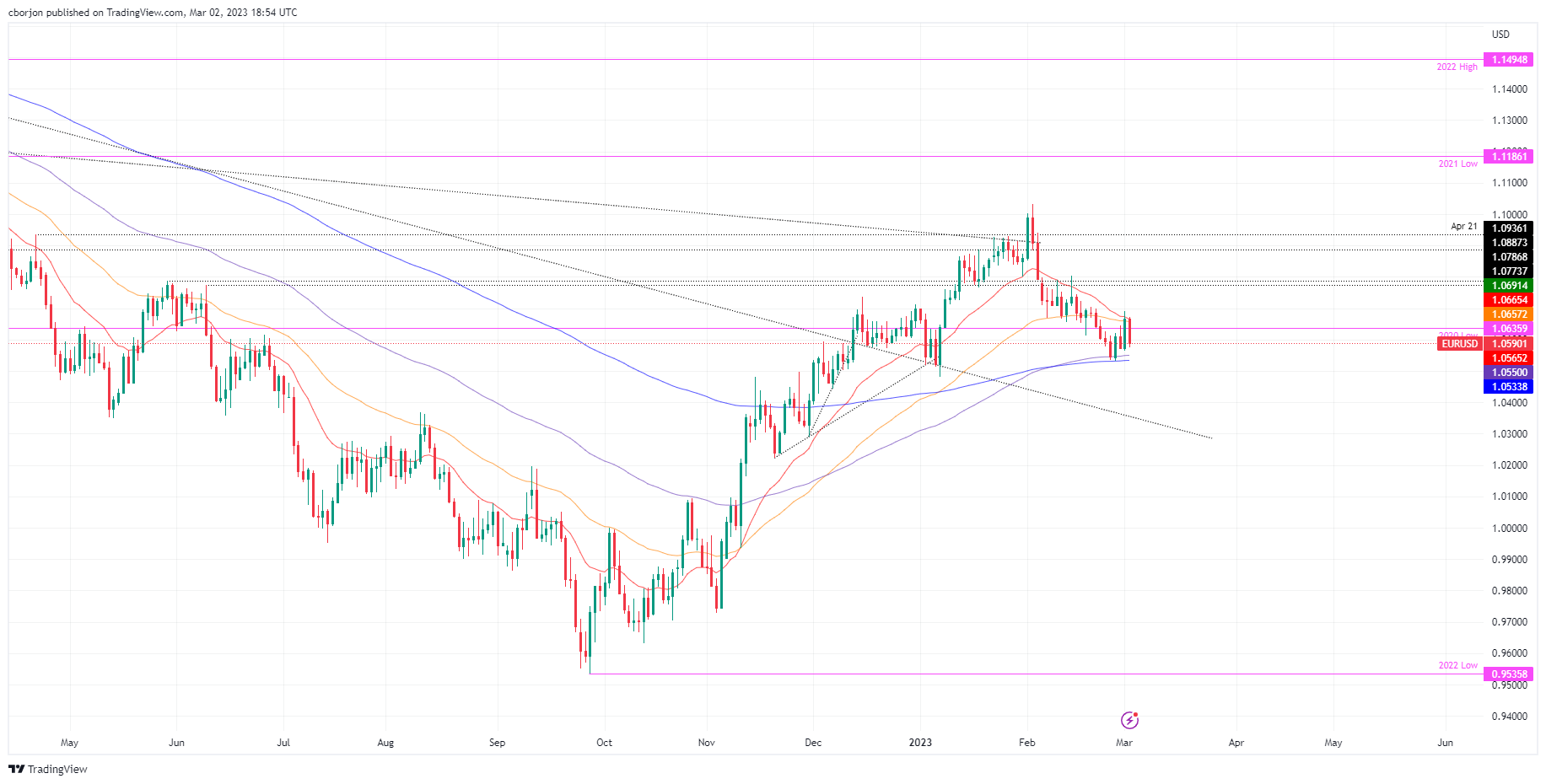
What to watch?
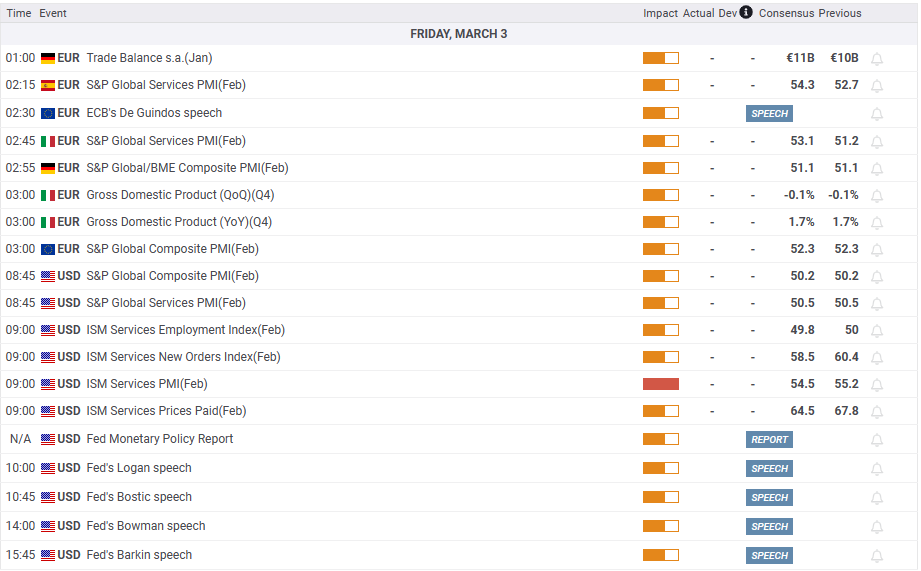
- USD/CHF advances due to higher US Treasury bond yields and a strong US Dollar.
- Bulls are eyeing a test of the 200-day EMA around 0.9452.
- USD/CHF Price Analysis: Neutral upwards and will be cemented by a daily close above 0.9400.
The USD/CHF staged ar recovery and reached a new year-to-date high at 0.9439 in the mid-North American session. A solid US jobs report triggered a US bond sell-off; consequently, UST bond yields are skyrocketing and are boosting the US Dollar (USD). The USD/CHF is trading at 0.9428, eyeing a break of a range above the February 27 daily high at 0.9429.
USD/CHF Price action
Technically speaking, the USD/CHF is neutral biased, though the break of the psychological 0.9400 could open the door for further gains. Above the current exchange rate sits the 200-day Exponential Moving Average (EMA) at 0.9452, seen as a reference to the bullish/bearishness of an asset. If the USD/CHF breaks the latter, the bias will shift to neutral-upwards. Unless the USD/CHF cracks the next resistance area at 0.9547, the November 30 high, the neutral-upwards tendency would be weak. Once the USD/CHAF pair snaps 0.9547, the major could rally toward the November 21 high at 0.9598.
Readings in oscillators support the bias change, with the Relative Strength Index (RSI) aiming higher and the Rate of Change (RoC). Therefore, the USD/CHF bias is neutral-upward.
On the other hand, failure to hold to gains above 0.9400 would exacerbate the USD/CHF fall to the 100-day EMA at 0.9386 before testing the January 24 high turned support at 0.9360.
USD/CHF Daily chart
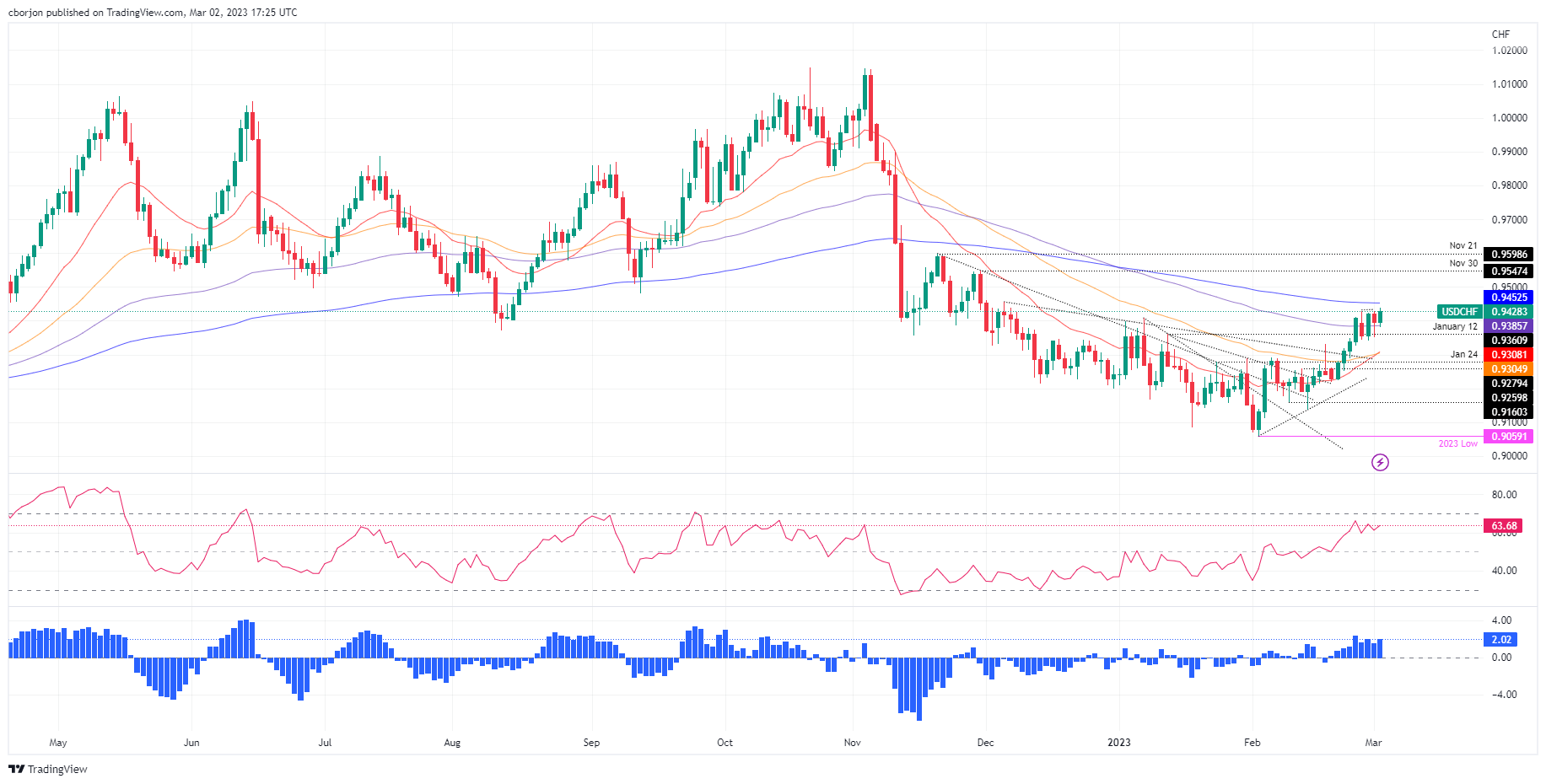
USD/CHF Technical levels
- GBP/USD falls courtesy of US Dollar strength, as UST bond yields pushed above 4%.
- US Initial Jobless Claims continued to trend lower, below expectations.
- GBP/USD Price Analysis: Downward biased, though facing solid support around the 1.1900-1.1915 area.
The GBP/USD retraces back below the 1.2000 figure after US economic data warranted further tightening by the US Federal Reserve (Fed), as reflected by the US Treasury bond yields reaction. At the time of typing, the GBP/USD exchanges hand at 1.1950, below its opening price by 0.66%.
GBP/USD tumbled below 1.2000 as UST bond yields skyrocketed, lifting the US Dollar
On Thursday, the US Department of Labor (DoL) announced that Initial Jobless Claims for the week ending on February 25 were lower than the 195K predicted by analysts, coming in at 190K. The 4-week moving average, which helps to even out fluctuations from week to week, was at 193K and showed a slight increase from the previous week’s average of 191K. The GBP/USD extended its losses on the headline and printed a fresh daily low of 1.1924 before reversing its course.
In the meantime, US Treasury bond yields begin to reflect higher rates, with investors lifting US Treasury bond yields, with 2s, 3s, 5s, and 10s, above the 4% threshold. Consequently, the US Dollar is rising 0.57%, as shown by the US Dollar Index, at 104.971.
The Fed parade continued with Minnesota’s Fed President Neil Kashkari commenting that rates need to be raised to around 5.4%. On the contrary, Atlanta’s Fed President Raphael Bostic added that he projects the Federal Fund Rates (FFR) to peak at the 5.0% - 5.25% range. And reiterated that it will stay there “well into 2024.”
The lack of UK economic data keeps the GBP/USD pair leaning on the dynamics of the US Dollar and the Bank of England (BoE) Chief economist Huw Pill. Pill commented that economic activity in the UK may be stronger than projected and that inflation risks are skewed to the upside.
GBP/USD Technical analysis
Even though the GBP/USD edged lower, it’s facing a critical support area, with a four-month-old support trendline and the February low at 1.1914. A decisive break of the latter would expose the 1.1900 figure, which, once broken, the GBP/USD could fall to the YTD low at 1.1841. As an alternate scenario, the GBP/USD reclaiming the 1.2000 figure would expose the 20-day Exponential Moving Average (EMA) at 1.2064.
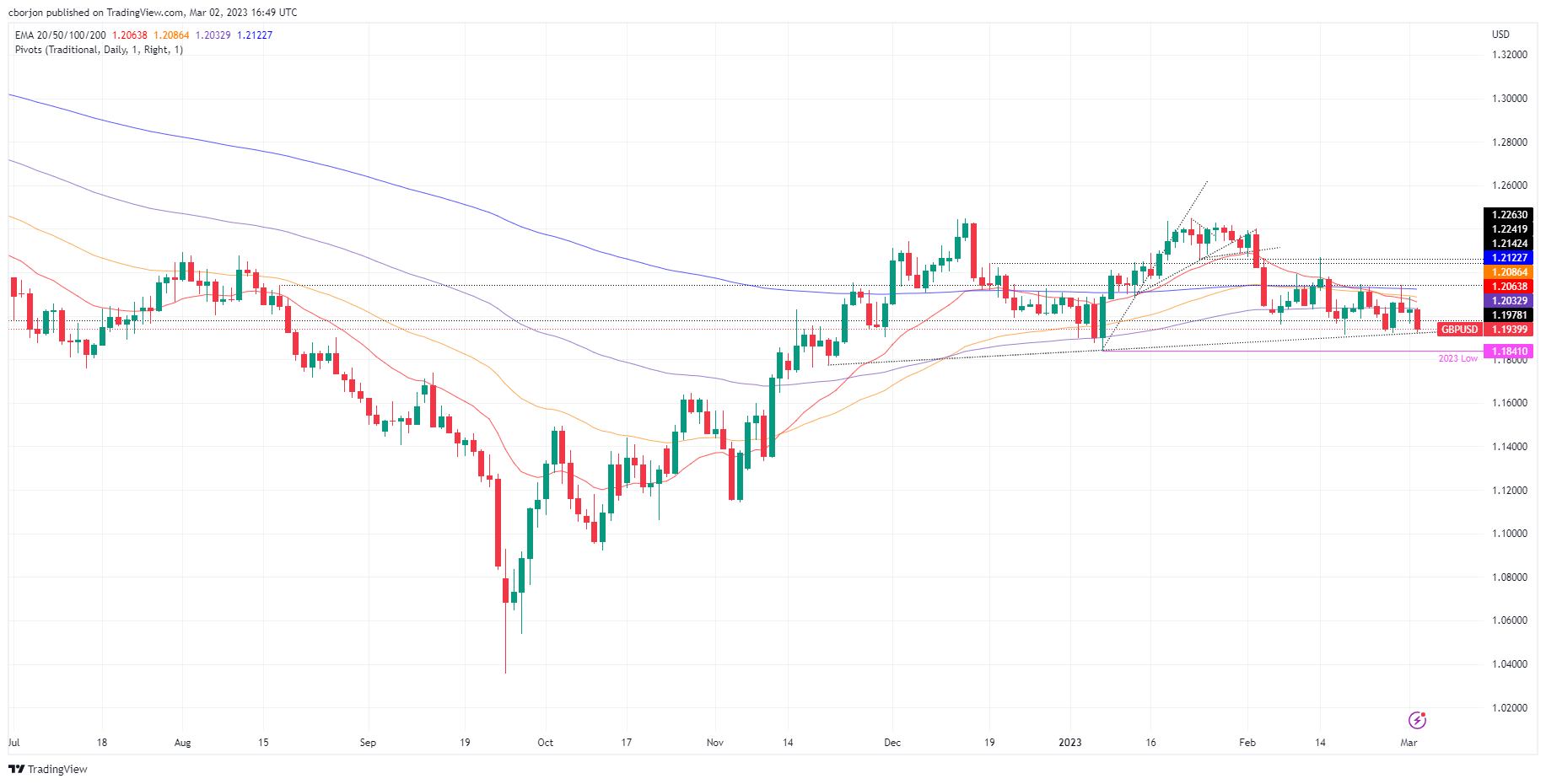
What to watch?

Federal Reserve Bank of Boston President Susan Collins said on Thursday that more rate hikes are required to bring inflation back in control. She added that the extent of interest rate hikes will be determined by incoming data.
Collins’ comments were no surprise as she repeated what has been saying in February. Later on Thursday, Fed Governor Christopher Waller will speak on the economic outlook and Minneapolis Fed President Neel Kashkari will participate in an event on “Race, Justice and the Economy".
2023 will be the beginning of the end for USD strength. Thus, strategists at Société Générale believe that Gold exposure is set to provide great returns.
Fixed income to do better than equities
“Gold can offer protection against systemic risk.”
“Continue rebalancing away from the USD. Gold will be a powerful protection against a falling USD.”
“2023 will be the year of several pivots, and overall, we expect higher returns than in 2022.”
“We see fixed income (both sovereign and credit) doing better than equities.”
After a positive January, the Australian Dollar turned lower in February and wiped out all the gains for the year. Economists at MUFG Bank expect the AUD/USD pair to recover in the second half of the year.
Further downside for AUD/USD over the short-term
“With the Fed rhetoric so hawkish we suspect over the short-term, we can see further downside for AUD/USD.”
“China data will be important in March covering Jan/Feb and we may well see evidence of pent-up demand post re-opening that may help limit AUD downside.”
“China commodity-related demand and the scope for the Fed to pause at some point in Q2 should add to a renewed upturn in demand for AUD in H2 this year.”
"Survey indicators that have become available since the publication of the forecast have surprised to the upside, suggesting that the current momentum in economic activity may be slightly stronger than anticipated," Bank of England Chief Economist Huw Pill said on Thursday, per Reuters.
Pill further noted that some high-frequency indicators of wages have fallen quite sharply recently but acknowledged that the latest data for private sector regular pay growth surprised slightly to the upside.
Market reaction
These comments failed to help Pound Sterling find demand. As of writing, GBP/USD was down 0.9% on the day at 1.1925.
- Upbeat labor market data boosted the US Dollar.
- The Federal Reserve pressured to deliver after solid US data warrants further tightening.
- USD/CAD headed upwards due to interest rate differentials between the Fed and the BoC.
The USD/CAD stages a comeback after losing 0.41% on Wednesday and rises above 1.3600 courtesy of broad US Dollar (USD) strength, sponsored by higher UST bond yields. Data from the United States (US) reinforced the economy is solid, particularly the labor market. Therefore, the USD/CAD advances 0.24% and trades at around 1.3600s after hitting a low of 1.3582.
USD/CAD pierces 1.3600 as US jobless claims edge down
On Thursday, the US Department of Labor (DoL) revealed that Initial Jobless Claims for the week ending February 25 came at 190K below the 195K foreseen by analysts. The 4-week moving average, which smooths volatile movement from week to week, stood at 193K and climbed from last week’s 191K. The USD/CAD rose and printed a daily high of 1.3641 before settling at current levels.
Since then, the US !0-year Treasury bond yield skyrocketed above the 4% threshold, at the time of writing, stands at 4.056%, gains six basis points, and underpins the greenback. The US Dollar Index (DXY), a gauge of the buck’s value vs. a basket of six currencies, gains 0.55% at 104.944.
On Wednesday, Federal Reserve officials continued their hawkish rhetoric after last week’s data disappointed investors hopeful of witnessing lower inflation readings. Minnesota Fed President Neil Kashkari commented that he is inclined “to push up my policy path” and foresees the Federal Fund Rate (FFR) to peak at around 5.4%. Echoing some of his comments was Atlanta’s Fed President Raphael Bostic though he was moderate, projects the FFR to peak at 5.0% - 5.25% but emphasized that it will stay there “well into 2024.”
On the Canadian front, traders should be aware that the Bank of Canada (BoC) lifted rates 25 bps to 4.50% on January 25 and commented that it would pause hiking rates. Therefore, that would keep the Loone (CAD) pressured as interest rate differentials between the Fed and the BoC would increase flows to the US Dollar. Given the backdrop, the USD/CAD path of least resistance is upwards.
The USD/CAD rally was capped by high oil prices, as WTI extended its rally to three days, with investors assessing China’s oil demand once it completes its reopening.
USD/CAD Technical analysis
Technically speaking, the USD/CAD is still upward biased, but it has consolidated during the week. If the USD/CAD pair stays around 13600.1.3660, that could lead to desperate bulls, which need to reclaim the YTD high of 1.3685, on its way to 1.3700 and beyond. On the other hand, a break below 1.3600 could exacerbate a correction toward the 20-day Exponential Moving Average (EMA) at 1.3507.
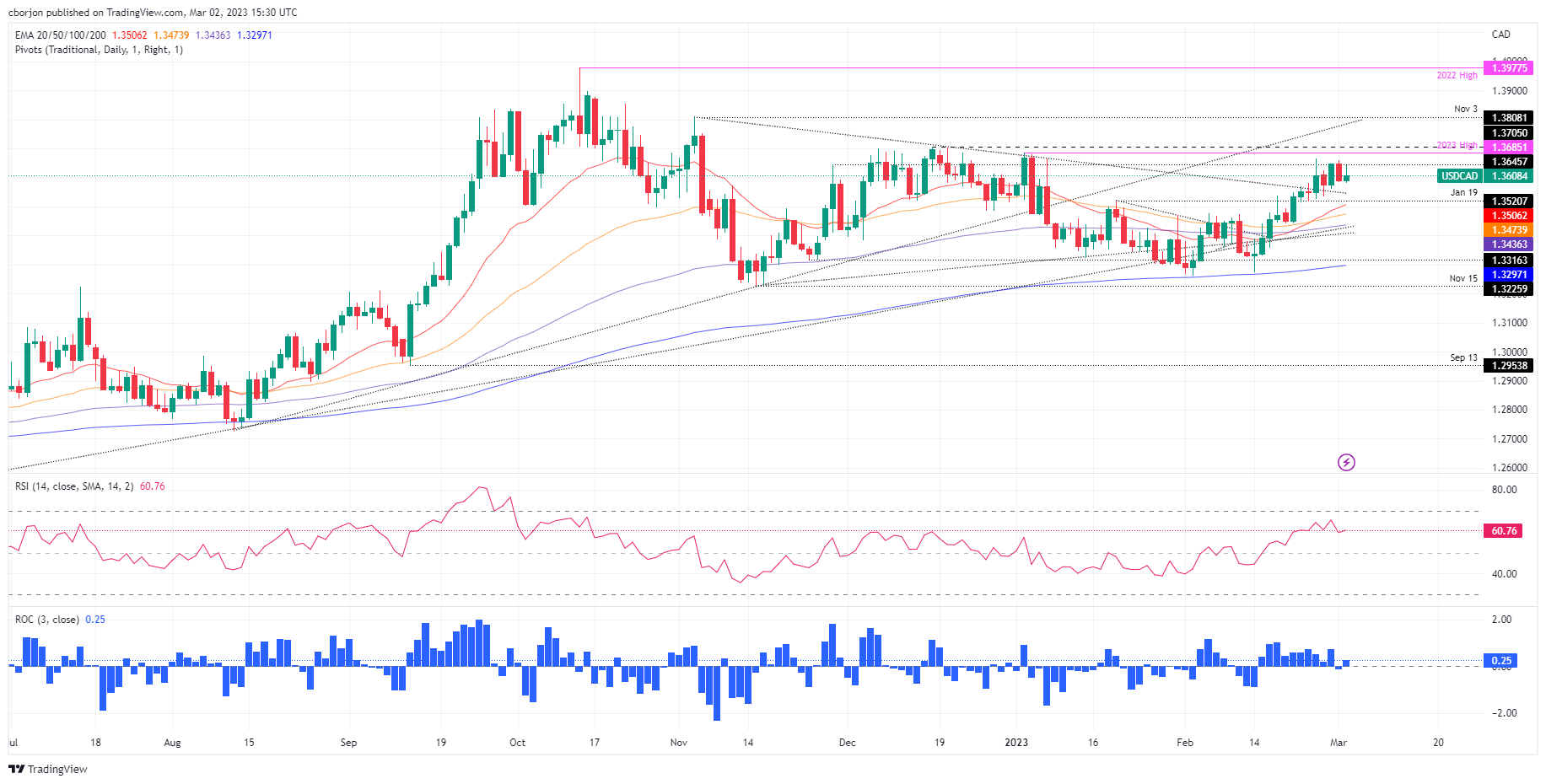
What to watch?
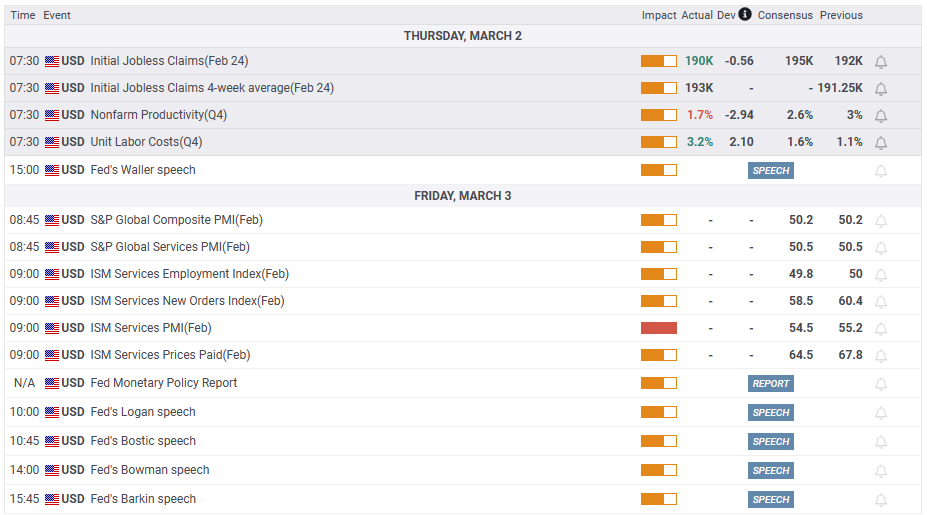
- US yields keep rising after a fresh round of US economic data.
- Japanese Yen continues to be among the weakest currencies.
- USD/JPY with a bullish bias, testing 100 and 200-day SMAs.
The USD/JPY jumped to 137.08 following the release of US economic data on Thursday, reaching the highest level since December 20. The pair failed to hold above 137.00 and is hovering around 136.60.
The same new story
Data released on Thursday showed Initial Jobless Claims for the week ended February 24 dropped to 190K, better than the 195K of market consensus. Non-farm productivity during the fourth quarter was revised lower from 3% to 1.7% while Unit Labor Costs were revised from 1.1% to 3.2%. Federal Reserve Governor Christopher Waller and Minneapolis Fed President Neel Kashkari will speak later on Thursday.
US economic figures add to the new scenario of a tight labor market and persistent inflation. The context adds pressure to the Fed and increases expectations of higher interest rates for longer. As a response, US yields moved further north. The 10-year US yield hit 4.08%, the highest since November, and the 2-year hit 4.93%, the highest since 2007.
The Japanese Yen is the worst performer over the last five days across the G10 space, followed closely by the Australian Dollar. Higher bond yields across the globe as inflation shows signs of persistence are weighing on the Yen. On Thursday is having a mixed performance amid a deterioration in market sentiment.
A critical area ahead for USD/JPY bulls
The USD/JPY faces a strong resistance area around 137.00, the confluence of a round number, and the 100 and 200-days Simple Moving Averages. A daily close above would open the doors to more gains toward the next relevant area at 138.00/10 (November highs).
The momentum favors the US Dollar, particularly after the quick rebound on Wednesday from 135.25. However, a failure to make a run above 137.00 over the next sessions would increase the odds of a bearish correction.
USD/JPY daily chart
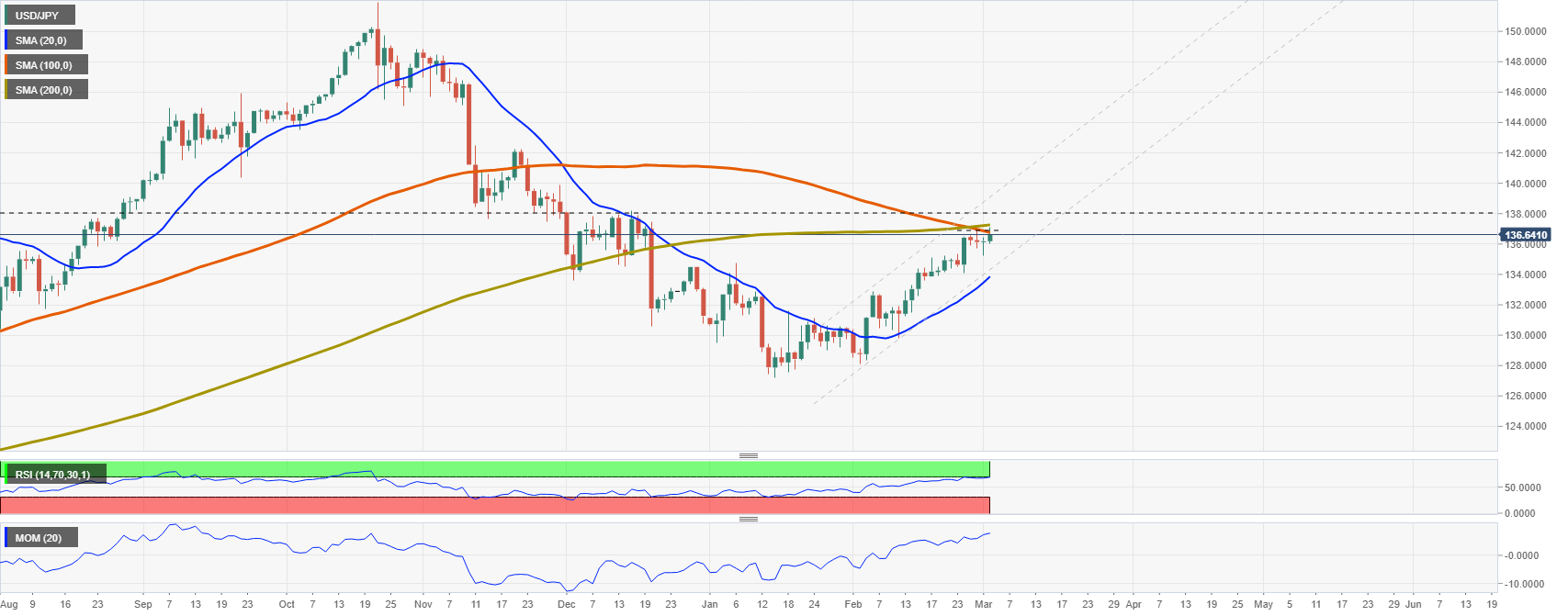
Technical levels
- EUR/USD comes under heavy pressure and breaches 1.0600.
- Extra losses seem in place while below the 55-day SMA at 1.0713.
EUR/USD quickly fades the Wednesday’s uptick and returns to the sub-1.0600 region on Thursday.
While below the temporary up barrier at the 55-day SMA, today at 1.0713, the pair remains vulnerable to further losses. Against that, another visit to the February low at 1.0532 (February 27) should not be ruled out.
Looking at the longer run, the constructive view remains unchanged while above the 200-day SMA, today at 1.0327.
EUR/USD daily chart
Signs of political instability and a correction in implied rates point towards a correction in recent GBP gains. Nonetheless, analysts at CIBC Capital Markets look for an appreciation in the medium-term.
Sterling under pressure in the near-term
“Beyond the improved macro dynamics, including signs of a moderation in inflationary influences, easing pressure on UK terminal rate expectations, underlying political uncertainty remains a residual GBP risk parameter.”
“Political uncertainties notwithstanding after a period of looking to sell GBP/USD rallies improving macro fundamentals, including a reduction in inflationary concerns, moderating fears of BoE overtightening, favours increasing consideration of GBP/USD looking to retest early 2023 highs, north of 1.24, into Q2.”
UOB Group’s Economist Ho Woei Chen assesses the latest release of the Chinese PMIs.
Key Takeaways
“China’s manufacturing and non-manufacturing PMIs jumped in Feb to suggest that the economic recovery momentum was more robust than expected. The corresponding rebound in the Caixin China manufacturing PMI to 51.6 (Bloomberg est: 50.7; Jan: 49.2) lends further credence to the positive outlook for the manufacturing sector.”
“The leading indicators temporarily dispel market’s worries that the rebound since China’s dismantling of its zero-Covid policy will not be able to sustain due to the downturn in global demand and persistent weak confidence in the domestic real estate market. There are also early indications that gains from the reopening of China’s economy are filtering down to employment and firms’ pricing powers.”
“We retain our cautiously optimistic outlook for China’s GDP growth at 5.2% this year and continue to watch for China’s consumption recovery, the domestic real estate market as well as the extent of slowdown in global demand. A stable Covid situation, stronger fiscal and monetary policy support at the upcoming National People’s Congress (NPC) will also boost the outlook for China this year.”
- DXY picks up strong pace and surpasses the 105.00 hurdle.
- Next on the upside comes the 2023 high near 105.30.
DXY resumes the weekly upside and reclaims the 105.00 mark and above, rapidly leaving behind Wednesday’s marked pullback.
Immediately to the upside for the dollar appears the February peak at 105.35 (February 27). The surpass of this level should pave the way for the continuation of the multi-week uptrend to challenge the 2023 top at 105.63 (January 6).
In the longer run, while below the 200-day SMA at 106.52, the outlook for the index remains negative.
DXY daily chart
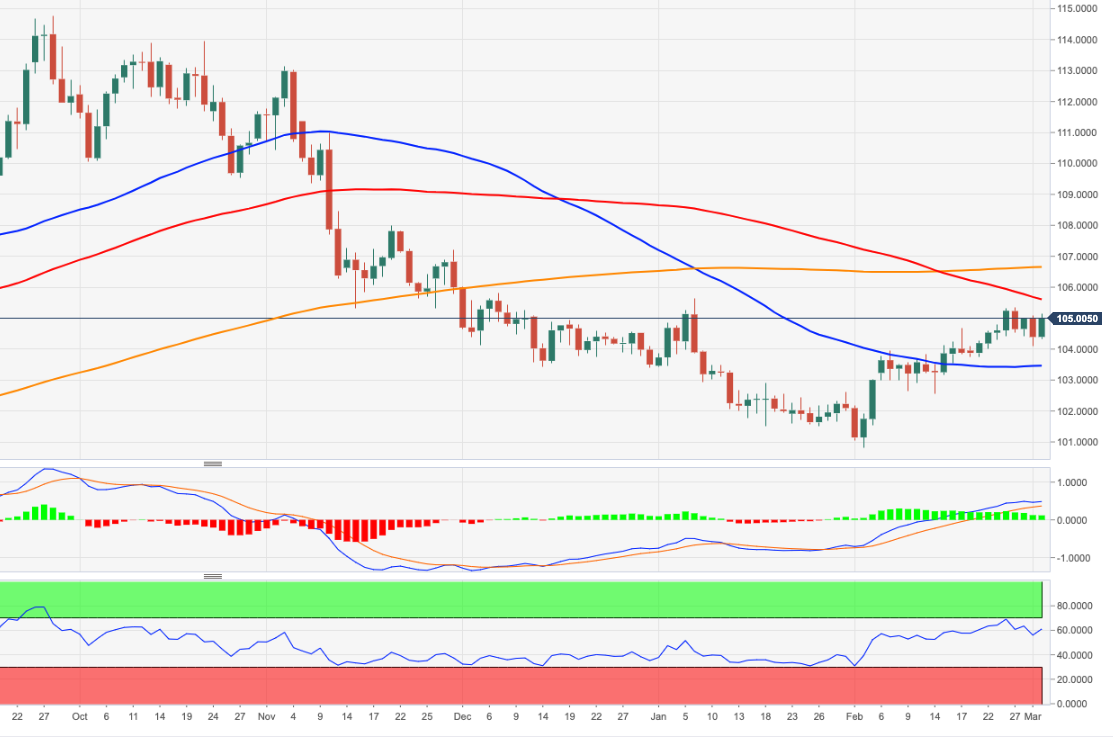
The dominant driver of the FX market has recently switched to interest rates from risk appetite. Against this backdrop, USD strength looks toppish over the near term, in the view of economists at HSBC.
Near-term asymmetric downside
“While we think that the USD is likely to be range-bound, we see the balance of risks as skewed to the downside over the next few weeks.”
“As the market focus now seems to be on interest rates, rather than risk appetite, any further upside US data surprises would see a stronger USD. The employment report will be on 10 March and CPI on 14 March (the latter during the Fed’s blackout period); however, given the recent USD rally and hawkish rate expectations, there is likely an asymmetric downside to any dovish surprise.”
The Brazilian Real has been steady against the Dollar. However, the USD/BRL is set to move higher as politicians may increase their pressure on the Brazilian central bank, economists at ING report.
When politics and central banking collide
“Politicians are keen for the central bank to start cutting interest rates. However, in its most recent update, the central bank has warned about long-run inflation expectations increasingly moving away from target – clearly at odds with calls for rate cuts.”
“With core rates so high, we doubt investors will have too much patience for this kind of friction and we would favour further under-performance of the Real.”
“Were the politicians to increase their pressure on the Brazilian central bank – then USD/BRL could trade up to 5.40.”
In February, the Euro weakened further versus the US Dollar moving from 1.0866 to 1.0612. Economists at MUFG Bank expect the world’s most popular currency pair to move back higher later in the year.
ECB is set to be on hold for longer than the Fed
“As we had expected, the US Dollar has rebounded and EUR/USD is set to fall modestly further from here as inflation risks turn higher again. However, despite the substantial jump in US yields, spreads with Europe have moved only modestly and in general, EUR/USD is trading at an appropriate level based on historic spreads.”
“The end of negative rates in the Eurozone and the scope for Eurozone equity outperformance relative to the US point to the potential for EUR/USD to grind higher later this year. The ECB is set to be on hold for longer than the Fed.”
“EUR/USD – Q1 2023 1.0500 Q2 2023 1.0800 Q3 2023 1.1000 Q4 2023 1.1200”
Economist at UOB Group Lee Sue Ann comments on the latest GDP and inflation results in Australia.
Key Takeaways
“The Australian economy grew 0.5% q/q in 4Q22, below expectations of 0.8% q/q, and below the revised 0.7% q/q print in 3Q22. From a year earlier, the economy expanded by 2.7% y/y, within expectations, but much lower from 3Q22’s reading of 5.9% y/y. The latest GDP prints is in line with our view of growth turning softer as high inflation and interest rates weigh on households alongside a slowdown in global growth. We see Australia’s GDP growth slowing this year to 1.7% from 3.7% in 2022.”
“Meanwhile, monthly CPI rose 7.4% y/y in Jan, down from 8.4% y/y in Dec. The latest reading, however, is the second highest annual increase since the start of the monthly CPI indicator series in Sep 2018, signifying ongoing high inflation. That said, inflation seems to have peaked in 4Q22, in line with our view. Our full-year 2023 inflation forecast of 4.8% remains unchanged.”
“All in all, the Reserve Bank of Australia (RBA) has raised the cash rate by 325bps since May 2022, and in Feb, stated that its priority is to return inflation to target, and that further increases in interest rates will be needed over the months ahead. We are keeping our view of two more 25bps hikes in Mar and Apr, which will take the OCR to 3.85%.”
- GBP/USD meets with aggressive supply on Thursday and dives back closer to the weekly low.
- The setup favours bears and supports prospects for an eventual break below the 200 DMA.
- A sustained move beyond the 50-day SMA is needed to negate the near-term bearish outlook.
The GBP/USD pair comes under intense selling pressure on Thursday and extends its intraday downward trajectory heading into the North American session. The pair is currently placed below the mid-1.1900s, down over 0.60% for the day, and remains well within the striking distance of the weekly low touched on Monday.
Looking at the broader picture, the GBP/USD pair is trading just above a technically significant 200-day Simple Moving Average (SMA) support, currently pegged around the 1.1920-1.1915 region. The said area coincides with the lower end of a short-term trading range witnessed over the past two weeks or so, which constitutes the formation of a rectangle on the daily chart.
Given that oscillators on the daily have just started gaining negative traction, a convincing break below a technically significant SMA will be seen as a fresh trigger for bearish traders. The GBP/USD could then slide towards retesting the YTD low, around the 1.1840 area set in January, which if broken will complete a bearish double-top pattern formed near the 1.2445-1.2450 region.
On the flip side, attempted recovery moves might now confront stiff resistance near the 1.2000 psychological mark ahead of the daily swing high, around the 1.2035 region and the 1.2065-1.2070 supply zone. Any subsequent move-up could attract fresh sellers near the 1.2100 mark and remain capped near the 50-day SMA strong barrier, currently around the 1.2135-1.2140 area.
Some follow-through buying has the potential to lift the GBP/USD pair towards the 1.2200 round-figure mark en route to the February 14 swing high, around the 1.2265-1.2270 region. A sustained strength beyond the latter will suggest that the slide from the 1.2445-1.2450 supply zone has run its course and shift the near-term bias back in favour of bullish traders.
GBP/USD daily chart

Key levels to watch
- EUR/JPY comes under pressure after hitting new yearly peaks.
- The continuation of the uptrend should revisit the December 2022 top.
EUR/JPY deflates from earlier YTD highs in the 145.50 region on Thursday.
The continuation of the current upside momentum faces the immediate hurdle at the 2023 high at 145.56 (March 2). Once this level is cleared, the par could then challenge the December 2022 top at 146.72 (December 15) ahead of the 2022 high at 148.40 (October 21 2022).
In the meantime, while above the 200-day SMA, today at 141.59, the outlook for the cross is expected to remain positive.
EUR/JPY daily chart
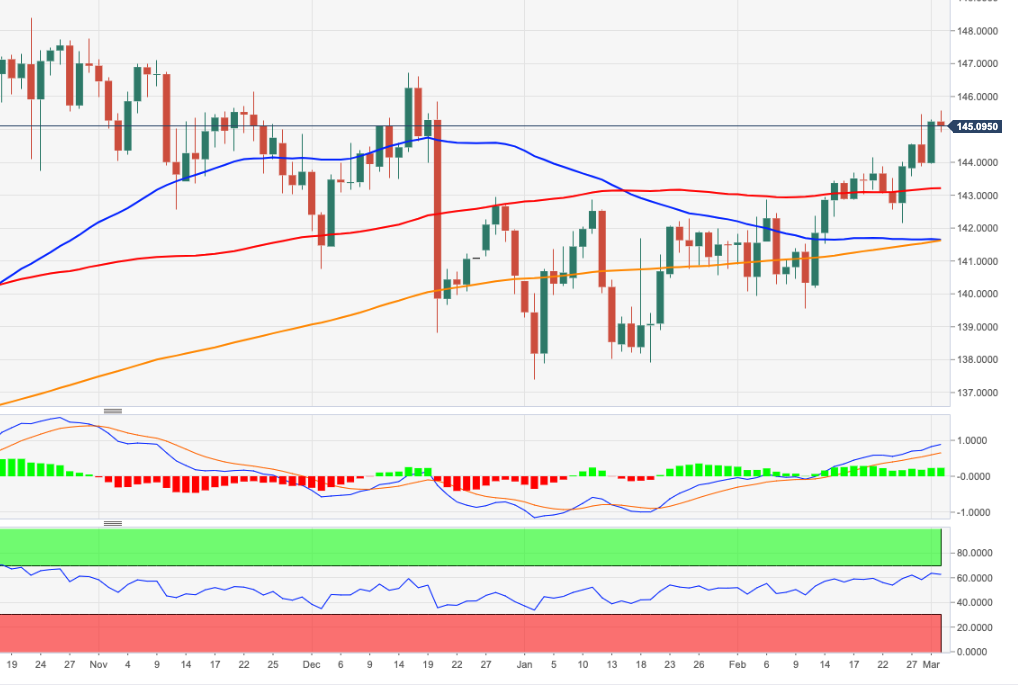
The Mexican Peso has seen a total return of 9.7% vs. the US Dollar this year. Economists at Société Générale believe that the USD/MXN pair could break below the 18.00 level.
50-DMA at 18.85/19.00 is expected to cap
“USD/MXN rallied yesterday to 18.07 and a test of 18.00 could follow for the first time since April 2018.”
“Daily MACD is within deep negative territory denoting an overstretched move. An initial rebound is not ruled out however 50-DMA at 18.85/19.00 is expected to cap. Holding below this hurdle, there is a risk of continuation in the decline.”
“Next potential support zone is at 17.90/17.60, the 50% retracement of the whole 2008-2020 uptrend.”
- Unit Labor Costs in the US increased at a stronger pace than expected in Q4.
- US Dollar Index posts strong daily gains above 105.00 after the data.
"Unit labor costs in the nonfarm business sector increased 3.2% in the fourth quarter of 2022, reflecting a 4.9% increase in hourly compensation and a 1.7% increase in productivity," the US Bureau of Labor Statistics (BLS) reported on Thursday. This reading came much higher than the market expectation for an increase of 1.6%.
"Unit labor costs increased 6.3% over the last four quarters," the BLS further noted in its publication and said that nonfarm business sector labor productivity increased 1.7% in the fourth quarter of 2022.
Market reaction
The US Dollar gathered strength after this data and the US Dollar Index was last seen rising 0.66% on the day at 105.07.
- Initial Jobless Claims in the US decreased by 2,000 in the week ending February 25.
- US Dollar Index clings to strong daily gains near 105.00.
There were 190,000 initial jobless claims in the week ending February 25, the weekly data published by the US Department of Labor (DOL) showed on Thursday. This print followed the previous week's print of 192,000 and came in slightly better than the market expectation of 195,000.
Further details of the publication revealed that the advance seasonally adjusted insured unemployment rate was 1.1% and the 4-week moving average was 193,000, an increase of 1,750 from the previous week's unrevised average.
"The advance number for seasonally adjusted insured unemployment during the week ending February 18 was 1,655,000, a decrease of 5,000 from the previous week's revised level," the DOL noted.
Market reaction
The US Dollar continues to outperform its major rivals after this report and the US Dollar Index was last seen rising 0.65% on the day at 105.05.
Economists at HSBC analyze the USD/JPY outlook. The pair is expected to move downward in the medium-term.
USD/JPY driven by US developments for now
“We remain bullish on the JPY over the medium-term, but suspect some patience will be needed for the currency to enjoy some independent strength courtesy of the Bank of Japan (BoJ).”
“For now, USD/JPY will likely remain driven by US developments where we see the balance of risks skewed to USD weakness.”
See: USD/JPY set to test the 120 level into year-end – CIBC
- NZD/USD meets with a fresh supply and snaps a three-day winning streak to a nearly two-week high.
- Hawkish Fed expectations continue to push the US bond yields higher and revive the USD demand.
- Looming recession risks further benefit the safe-haven buck and weigh on the risk-sensitive Kiwi.
The NZD/USD pair comes under some renewed selling pressure on Thursday and stalls this week's goodish rebound from the 0.6130 area, or its lowest level since November 23. The pair maintains its offered tone around the 0.6220-0.6215 region heading into the North American session and for now, seems to have snapped a three-day winning streak to a nearly two-week top set on Wednesday.
The US Dollar makes a solid comeback and reverses a major part of the previous day's sharp retracement slide from a multi-week high, which, in turn, is seen as a key factor weighing on the NZD/USD pair. The prospects for further policy tightening by the Federal Reserve remain supportive of the ongoing move up in the US Treasury bond yields. This, along with looming recession risks, provides an additional boost to the safe-haven Greenback.
The US CPI, PPI and the PCE Price Index data released recently indicated that inflation isn't coming down quite as fast as hoped. Adding to this, the incoming upbeat US macro data pointed to an economy that remains resilient despite rising borrowing costs. This reaffirmed market expectations that the Fed will stick to its hawkish stance for longer. Moreover,
Minneapolis Fed President Neel Kashkari suggests that a 50 bps lift-off at the March was still a possibility.
This, in turn, pushes the yield on the benchmark 10-year US government bond back above the 4.0% threshold, or its highest level since November, and continues to underpin the buck. Investors, meanwhile, remain worried about economic headwinds stemming from rapidly rising borrowing costs. This overshadows the optimism led by the Chinese PMI prints on Wednesday and favours the USD bulls, supporting prospects for additional losses for the NZD/USD pair.
Next on tap is the release of the Weekly Initial Jobless Claims data from the US, which, along with the US bond yields, will influence the USD price dynamics. Apart from this, traders will further take cues from the broader risk sentiment to grab short-term opportunities around the NZD/USD pair. The focus will then shift to the Reserve Bank of New Zealand (RBNZ) Governor Adrian Orr's scheduled speech during the Asian session on Friday.
Technical levels to watch
After four months of depreciation, the US Dollar rebounded in February. However, weaker USD view still holds, in the opinion of economists at MUFG Bank.
Further USD strength seems likely over the short-term
“Inflation still looks set to fall notably over the coming months and the US labour market is likely to slow.”
“Further US Dollar strength seems likely over the short-term but we have just corrected weaker from over-valued levels and hence we doubt this move will be sustained.”
“Spreads have only marginally moved in favour of the Dollar and remain consistent with USD depreciation.”
The accounts of the European Central Bank's (ECB) February policy meeting revealed on Thursday that Governing Council members agreed that further increases in key rates are required for policy to enter restrictive territory, per Reuters.
Additional takeaways
"Policy rates were, at present, barely consistent with the range of estimates for the neutral rate."
"The view was expressed that there continued to be value in frontloading rate hikes at the present stage."
"Reservations were expressed on the proposed communication of an intention for the March meeting."
"It was noted that the short-term momentum in core inflation had also started to decline somewhat."
"Markets were now paying more attention to core inflation than to headline inflation to gauge underlying inflationary pressures."
"Members agreed that there were no signs of a wage-price spiral."
"Wage pressures were broadening."
"A better than expected growth outlook would contribute to continued inflationary pressures."
Market reaction
EUR/USD showed no immediate reaction to these comments and was last seen losing 0.4% on the day at 1.0622.
Head of Research at UOB Group Suan Teck Kin, CFA, reviews the growth prospects for India.
Key Takeaways
“India’s real GDP growth slowed further to 4.4% y/y in the Oct-Dec quarter (3QFY22-23), against 6.3% y/y in the prior quarter (2QFY22-23) and 13.5% pace in the Apr-Jun quarter (1QFY22-23). The outcome fell short of our call of 4.5% and consensus view of 4.7%.”
“Private spending and investment were the two key growth drivers, accounting for more than 90% share of the 4.4% expansion and have increasingly been weighed down by the central bank’s aggressive rate hikes in the past year. On the supply side, manufacturing output shrank for the second quarter, but were offset by a robust services sector.”
“Outlook – With activities expected to moderate even further ahead, we project growth rate of 6.9% in FY22-23 (from 9.1% in FY21-22) and keep the FY23-24 GDP forecast at 6.5%. The next key event to watch will be RBI’s monetary policy decision on 6 Apr.”
A rise in US Treasury yields and a strengthening USD weighed on Gold. However, the macro backdrop remains supportive for the yellow metal, strategists at ANZ Bank report.
Expectations around the Fed’s stance to guide Gold in the short-term
“Gold prices came under pressure amid mounting expectations of US rates staying higher, which gave fresh support to the USD. Rising US yields weighed on the non-yielding yellow metal, as it increases the opportunity cost.”
“While market expectations around the Fed’s stance are likely to guide Gold in the short-term, we see the macro backdrop remaining supportive for Gold with the Fed pausing its hiking cycle and the USD resuming its downtrend.”
- Silver comes under some renewed selling pressure and snaps a two-day winning streak.
- The technical setup favours bearish traders and supports prospects for additional losses.
- Slightly oversold oscillators on the daily chart warrant caution before placing fresh bets.
Silver struggles to capitalize on this week's modest recovery gains recorded over the past two days and meets with a fresh supply on Thursday. The white metal remains depressed through the mid-European session and is currently placed near the lower end of its daily trading range, around the $20.80 region.
From a technical perspective, the XAG/USD, so far, has managed to hold its neck above the 61.8% Fibonacci retracement level of the recent rally from the October 2022 low. The said support is pegged near the $20.60 area, which is followed by the YTD low, around the $20.40 region touched earlier this week. A convincing break below the latter will be seen as a fresh trigger for bears and set the stage for an extension of the recent slide from the $24.65 zone, or a multi-month top set in February.
That said, oscillators on the daily chart are hovering near the oversold territory, making it prudent to wait for some near-term consolidation or a modest rebound before placing fresh bearish bets. Nevertheless, the lack of any meaningful buying suggests that the path of least resistance for the XAG/USD is to the downside. Hence, some follow-through weakness to the $20.00 psychological mark, en route to the next relevant support near the $19.75-$19.70 region, looks like a distinct possibility.
On the flip side, attempted recovery back above the $21.00 round figure now seems to confront some hurdle near the overnight swing high, around the $21.15-$21.20 area, ahead of the $21.35 region (50% Fibo. level). Any subsequent strength could be seen as a selling opportunity and runs the risk of fizzling out near the $22.00 confluence support breakpoint. The said handle comprises 100-day Simple Moving Average (SMA) and 38.2% Fibo. level, which if cleared could negate the bearish bias.
The XAG/USD could then witness a short-covering rally towards the $22.55-$22.60 supply zone, above which nulls might aim to reclaim the $23.00 round-figure mark, which coincides with the 23.6% Fibo. level.
Silver daily chart
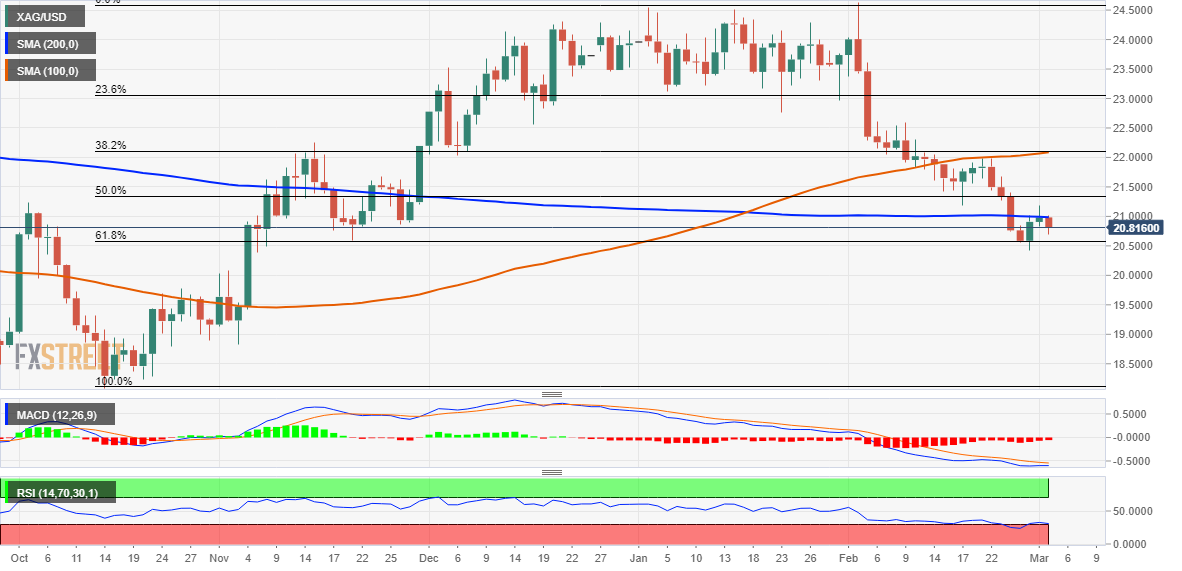
Key levels to watch
The US Dollar could appreciate further in the near-term. However, economists at Barclays Research expect the greenback to ease later in the year, lifting the EUR/USD pair to 1.12 by end-2023.
Scope for further USD strength in the near-term
“The disinflation narrative is under question and the market has increased the probability of a 50 bps hike in March. The market (and the Fed) remains data dependent, and will focus on the key employment report next week.”
“Although our views are for the Dollar to normalize to fair value by end-2023 (e.g. towards 1.12 vs EUR); in the near term, the risks are for further Dollar strength.”
Policy normalization and higher JGB yields leave bias for USD/JPY to test towards 120 into year-end, economists at CIBC Capital Markets report.
BoJ policy normalization to boost JPY valuations ahead
“While Kuroda was intimately associated with Abenomics we would not expect Ueda to be so tainted. Consequently, we would anticipate policy normalization should macro conditions warrant it.”
“Q2 2023: 125 | Q3 2023: 1.23 (USD/JPY)”
“Policy normalization and higher JGB yields, easing spreads versus UST, leave bias towards USD/JPY testing towards 120 into year-end.”
Preliminary calculations by Eurostat showed a significant increase in the core inflation rate. The inflation figures for February will therefore confirm the ECB's intention to raise interest rates further, economists at Commerzbank report.
Core inflation jumps to 5.6%
“Hopes for a strong decline in the inflation rate in February were not fulfilled. It eased only slightly from 8.6% to 8.5%. While energy prices fell, food prices rose and core inflation increased from 5.3% to 5.6%.”
“Given the renewed strengthening of underlying inflation, it seems almost certain that the ECB will raise its key rates by another 50 basis points at the mid-March meeting.”
Extra losses in USD/CNH are expected to meet a solid support at 6.8400 in the near term, suggest Economist Lee Sue Ann and Markets Strategist Quek Ser Leang at UOB Group.
Key Quotes
24-hour view: “We did not anticipate the outsized sell-off in USD yesterday (we were expecting USD to consolidate). After such a sharp drop, further sustained decline is unlikely. However, there is scope for the USD weakness to extend to 6.8550 before stabilization is likely. Resistance is at 6.8950, a break of 6.9100 would indicate that the weakness in USD has stabilized.”
Next 1-3 weeks: “We have held a positive USD view since the start of last month. In our update from yesterday (01 Mar, spot at 6.9560), we indicated that ‘to maintain the upward momentum, USD has to break above 7.0000 within the next few days or the chances of further gains will diminish rapidly’. That said, we were surprised by the outsized sell-off as USD plunged below our ‘strong support’ level of 6.9220 (low of 6.8642) before closing lower by a whopping 1.08% (6.8800). The breach of our ‘strong support’ level indicates that the month-long USD strength has ended. The outsized decline appears to be overdone and while there is room for further USD weakness, we expect 6.8400 to offer solid support. On the upside, a breach of 6.9350 would indicate that USD is unlikely to weaken further.”
Kit Juckes, Chief Global FX Strategist at Société Générale, analyzes FX market. Re-pricing peak Fed Funds keeps on supporting the Dollar, but by September, the greenback should ease.
EUR/USD is finding a base
“By the time rates peak – markets think in September, the Dollar should be lower. For now, they are busy revising that peak higher.”
“We think EUR/USD is finding a base here, partly because the US rates market has priced a lot in now, and partly because the European rates market has more to price in.”
“The USD/JPY 200-DMA is at 137.70 and if that were to break, it would trigger a spike down for the yen, at least temporarily.”
“As for Sterling, Andrew Bailey’s comments yesterday took the wind out of its sails. EUR/GBP is in a slow and erratic uptrend, but I could do with a Sterling pop higher before I head to the mountains at the weekend.”
Sterling eased following yesterday’s Central Bank Governor Andrew Bailey speech. He did not make any truly restrictive comments. Therefore, GBP is set to remain under pressure, Antje Praefcke, FX Analyst at Commerzbank reports.
Bailey is putting the brakes on Sterling
“Bailey is not really committing very firmly to further strong tightening measures. In view of an inflation rate in double-digits I would have hoped for more commitment towards rate hikes. But obviously the BoE is not willing to inflict (further) harm on the economy and the population to get a grip of inflation.”
“BoE continues to progress cautiously and is waiting for further data publications – probably in the hope that inflation really will fall quickly over the coming months as it expects so that it will not have to take much more action.”
“Based on Bailey’s comments it seems that any positive set of economic data will be used by the BoE to tighten rates less or to pause the cycle. And this impression cannot be positive for Sterling. The BoE meeting on 23rd March is likely to be of particular interest against this background.”
- EUR/GBP gains some positive traction for the second straight day, though lacks bullish conviction.
- A modest downtick in the Eurozone consumer inflation caps the upside for the Euro and the cross.
- The heavily offered tone surrounding the Sterling Pound supports prospects for additional gains.
The EUR/GBP cross builds on this week's bounce from the vicinity of the 100-day SMA support near the 0.8755-0.8750 region, or a one-month low, and edges higher for the second successive day on Thursday. The cross, however, retreats a few pips from a nearly two-week high touched during the first half of the European session and is currently placed around the 0.8875-0.8870 zone.
The common currency continues with its relative outperformance against its British counterpart amid rising bets for additional jumbo rate hikes by the European Central Bank (ECB), which, in turn, acts as a tailwind for the EUR/GBP cross. The expectations were lifted by hawkish commentary by European Central Bank (ECB) officials and stronger consumer inflation data released this week from France, Spain and Germany - the Eurozone's three biggest economies.
In fact, In fact, Bundesbank President Joachim Nagel said on Wednesday that the interest rate step announced by ECB for March will not be the last and further significant hikes might even be necessary afterwards too. Adding to this, French central bank Governor Francois Villeroy de Galhau said that the ECB remains committed to bringing inflation back to 2% by the end of 2024 and it is preferable to reach the terminal rate by summer, by September at the latest.
The EUR/GBP cross, however, struggles to capitalize on the intraday uptick and remains below the 0.8900 mark after the Eurostat reported that the annualized Eurozone HICP eased to 8.5% YoY rate in February from the 8.6% previous. This, along with a goodish pickup in the US Dollar demand, holds back the Euro bulls from placing aggressive bets. Meanwhile, the downside seems cushioned amid the heavily offered tone surrounding the British Pound.
The market anxiety over the new UK-UK Brexit deal on the Northern Ireland Protocol is seen weighing on the Sterling Pound. Moreover, the price action suggests that additional rate hike by the Bank of England (BoE) is already fully priced in the markets. This, along with some speculations the UK central bank would pause the current tightening cycle, favours the EUR/GBP bulls and supports prospects for a further near-term appreciating move.
Technical levels to watch
Economists at ANZ Bank expect the European Central Bank (ECB) to remain determined to get inflation down through both action and guidance.
EA rebound underpins cyclical inflation
“We have revised up our average euro area (EA) 2023 GDP forecast to 1.3% from 0.7%, reflecting the positive outturn for Q4 growth and recovery in activity and confidence in early 2023. Crucially, our forecasts assume the worst of the EA’s geopolitical/energy crisis has passed.”
“Cyclical inflation in the EA has not yet subsided. While base effects should help lower annual inflation from March, the ECB will focus on the sequential change in monthly inflation.”
“There is no evidence, in any of the iterations of core HICP, that underlying inflation is moderating. The ECB will need to keep pursuing price stability, and the risks skew towards more tightening.
“We have added 25 bps to our policy rate profile, and now expect the main refinancing operations (MRO) rate will reach 4.0% in June.”
- AUD/USD meets with a fresh supply on Thursday amid the emergence of fresh USD buying.
- Hawkish Fed expectations continue to push the US bond yields higher and underpin the buck.
- Looming recession risks further contribute to driving flow away from the risk-sensitive Aussie.
The AUD/USD pair comes under some renewed selling pressure on Thursday and maintains its offered tone through the first half of the European session. The pair is currently placed around the 0.6725-0.6720 region and remains well within the striking distance of its lowest level since early January touched the previous day.
The US Dollar regains positive traction and reverses a part of the previous day's sharp retracement slide from a multi-week top, which, in turn, is seen as a key factor weighing on the AUD/USD pair. Growing acceptance that the Fed will stick to its hawkish stance for longer continues to push the US Treasury bond yields higher. Apart from this, the prevalent cautious market mood - amid looming recession risks - further benefits the safe-haven Greenback and contributes to driving flows away from the risk-sensitive Aussie.
The markets seem convinced that the US central bank will continue to tighten its monetary policy in the wake of stubbornly high inflation. Moreover, the incoming US macro data pointed to an economy that remains resilient despite rising borrowing costs and should allow the Fed to keep interest rates higher. Adding to this, Minneapolis Fed President Neel Kashkari opened the door for a 50 bps hike at the next meeting in May and lifts the yield on the benchmark 10-year US government bond to its highest level since November.
Meanwhile, the overnight optimism led by the upbeat Chinese PMI prints for February fades rather quickly amid looming recession risk. This is evident from a generally softer tone around the equity markets, which lends additional support to the USD and suggests that the path of least resistance for the AUD/USD pair is to the downside. That said, it will still be prudent to wait for sustained weakness below the 0.6700 mark before placing fresh bearish bets and positioning for a further near-term depreciating move.
Market participants now look forward to the release of the Weekly Initial Jobless Claims data from the US, due later during the early North American session. This, along with the US bond yields and the broader risk sentiment, should influence the USD price dynamics and provide some impetus to the AUD/USD pair.
Technical levels to watch watch
- EUR/USD fades part of the recent strong uptick and returns below 1.0700.
- EMU Flash inflation figures surprised to the upside in February.
- Initial Claims, Fed’s Waller come next across the pond.
The European currency sees its recent upside momentum trimmed and forces EUR/USD to retreat to the 1.0630/25 band on Thursday.
EUR/USD appears offered following EMU data, ECB
EUR/USD recedes to the low-1.0600s on the back of the resumption of the buying interest in the greenback, particularly following the so far unabated rally in US yields and hawkish messages from Fed speakers (Kashkari on Wednesday).
Despite the weekly erratic performance, the pair manages well to keep the trade in the positive territory after bottoming out in the 1.0535/30 band last week.
No reaction in the FX universe after Chairwoman Lagarde reiterated that a 50 bps rate hike remains on the table at the March meeting, at the time when she added that decisions on the future rate path will be data dependent, although how far up rates could go remains uncertain. She also noted that inflation remains too high and that she does not see a recession in the region.
In the docket, advanced inflation figures in the Euroland now see the headline CPI rising 8.5% in the year to February and 5.6% when it comes to the Core CPI. Later in the session, the ECB will publish its Accounts of its February gathering.
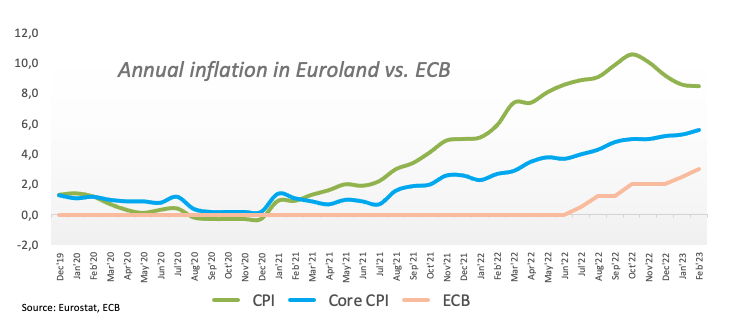
In the US, usual weekly Initial Claims are due along with the speech by FOMC C.Waller.
What to look for around EUR
EUR/USD faces some selling pressure and gives aways part of Wednesday’s advance to the vicinity of 1.0700 the figure.
In the meantime, price action around the European currency should continue to closely follow dollar dynamics, as well as the potential next moves from the ECB after the bank has already anticipated another 50 bps rate raise at the March event.
Back to the euro area, recession concerns now appear to have dwindled, which at the same time remain an important driver sustaining the ongoing recovery in the single currency as well as the hawkish narrative from the ECB.
Key events in the euro area this week: EMU Flash Inflation Rate, Unemployment Rate, ECB Accounts (Thursday) – Germany Balance of Trade, Final Services PMI, EMU Final Services PMI (Friday).
Eminent issues on the back boiler: Continuation of the ECB hiking cycle amidst dwindling bets for a recession in the region and still elevated inflation. Impact of the Russia-Ukraine war on the growth prospects and inflation outlook in the region. Risks of inflation becoming entrenched.
EUR/USD levels to watch
So far, the pair is losing 0.43% at 1.0620 and faces the immediate support at 1.0532 (monthly low February 27) seconded by 1.0481 (2023 low January 6) and finally 1.0327 (200-day SMA). On the upside, the breakout of 1.0714 (55-day SMA) would target 1.0804 (weekly high February 14) en route to 1.1032 (2023 high February 2).
The annualized Eurozone Harmonised Index of Consumer Prices (HICP) comes in a tad softer at 8.5% in February vs. January’s 8.6%, the latest data published by Eurostat showed on Thursday. The market expected the inflation gauge to ease to 8.2% in the reported period.
The core HICP climbs to 5.6% YoY in February when compared to 5.3% expected and 5.3% seen in the January reading.
On a monthly basis, the old continent’s HICP unexpectedly jumped by 0.8% in February vs. -0.3% expectations and -0.2% previous. The core HICP arrived at 0.8% last month as against the 0% expected and -0.8% registered in January.
The Euro area inflation data is featured a trading day after Germany’s annual HICP for February, which rose by 9.3%, beating 9.0% estimates while following a 9.2% increase seen in January.
The ECB inflation target is 2%.
The bloc’s HICP figures hold significance, as it would help investors reprice the European Central Bank’s (ECB) rate hike expectations. Market expectations currently attach a 65% probability to a 50bp hike in May, with a 50 bps March rate hike almost a done deal, as endorsed by several ECB policymakers.
Key details (via Eurostat)
“Looking at the main components of euro area inflation, food, alcohol & tobacco is expected to have the highest annual rate in February (15.0%, compared with 14.1% in January), followed by energy (13.7%, compared with 18.9% in January), non-energy industrial goods (6.8%, compared with 6.7% in January) and services (4.8%, compared with 4.4% in January).”
EUR/USD reaction
The shared currency is a little impressed by the hotter-than-expected Eurozone inflation data, as EUR/USD keeps its range near daily lows of 1.0618. The spot is shedding 0.36% so far.
NZD/USD is set to remain under downside pressure in the near-term. Nevertheless, the pair is set to recover toward 0.66 by the end of the year, economists at Bank of America Global Research report.
NZD to underperform AUD
“We expect a gradual recovery in NZD vs. USD in 2023 to 0.66 by year-end but expect it to underperform AUD, as the latter is better poised to benefit from China’s policy pivot.
“Near term risks are to the downside due to USD strength and potential dovish pivot from the RBNZ.”
The latest survey conducted by the Bank of England (BoE) decision maker panel (DMP) showed on Thursday that “businesses’ expectations for their own-price inflation declined in February,” per Reuters.
Key findings
Businesses expected their output prices to increase by an average 5.4% over the next year, down 0.4% from the previous month.
DMP members’ one-year ahead CPI inflation expectations decreased to 5.9%, down from 6.4% in January.
Three-year ahead cpi inflation expectations also declined to 3.4% in February, from 3.7% in January.
Expected year-ahead wage growth remained at 5.7% in February.
Businesses reported that unit costs had grown by 9.8% in the year to February, down from 9.9% in January.
Recruitment difficulties started to rise again in February, with 45% of firms were finding recruitment ‘much harder’ than usual.
Overall business uncertainty continued to decline in February.
Market reaction
The BoE DMP Survey fails to move a needle around the GBP/USD pair, leaving it in deep losses at around 1.1978. The pair hit daily lows at 1.1956 earlier in the session.
- USD/CAD gains some positive traction on Thursday, albeit lacks strong follow-through buying.
- An uptick in Crude Oil prices underpins the Loonie and keeps a lid on the intraday positive move.
- Hawkish Fed expectations, rising US bond yields boost the USD and continue to act as a tailwind.
The USD/CAD pair struggles to capitalize on its intraday positive move on Thursday and retreats to the 1.3600 round-figure mark during the first half of the European session.
Crude Oil prices reverse a modest dip and touch a nearly two-week high in the last hour, which, in turn, is seen underpinning the commodity-linked Loonie and acting as a headwind for the USD/CAD pair. The uptick in Oil prices, however, lacks bullish conviction amid worries that rapidly rising borrowing costs will dampen economic growth and dent fuel demand. Apart from this, resurgent US Dollar demand, bolstered by hawkish Fed expectations, supports prospects for some meaningful upside for the major.
The markets now seem convinced that the US central bank will keep interest rates higher for longer than expected in the wake of stubbornly high inflation. Furthermore, Minneapolis Fed President Neel Kashkari opened the door for a 50 bps hike at the next meeting in March, which continues to push the US Treasury bond yields higher. In fact, the yield on the benchmark 10-year US government bond climbs to its highest level since November, further beyond the 4.0% threshold, and acts as a tailwind for the Greenback.
Furthermore, the prevalent cautious market mood - amid looming recession risks - further benefits the safe-haven buck. Apart from this, speculations that the Bank of Canada (BoC) could pause the policy-tightening cycle, bolstered by a softer Canadian CPI report released last week, favours the USD/CAD bulls. This, in turn, suggests that the path of least resistance for spot prices is to the upside.
Market participants now look forward to the release of the US Weekly Initial Jobless Claims data, due later during the early North American session. This, along with the US bond yields and the broader risk sentiment, will drive the USD demand and provide some impetus to the USD/CAD pair. Traders will further take cues from Oil price dynamics to grab short-term opportunities
Technical levels to watch
Today, the focus is on February Core Eurozone CPI. EUR/USD climbed to a fresh weekly high near 1.0700 on Wednesday. On Thursday, the pair is set to remain confined in a 1.0600-1.0700 range, economists at ING report.
Look for a new cycle high in Core Eurozone CPI
“The release of February's Core Eurozone CPI looks likely to exceed the 5.3% year-on-year consensus. We have had little push-back from the European Central Bank against the repricing of the cycle, which now seems to price the deposit rate above 4.00% early next year. That seems excessive, but let's see what today's release of the ECB minutes has to say.”
“Also important today will be comments from consistent hawk, Isabel Schnabel, speaking at the Money Market Contact Group in Frankfurt. Will she push back against this aggressive pricing of the ECB cycle?”
“EUR/USD may well be trapped in a 1.0600-1.0700 range today.”
See – Eurozone HICP Preview: Forecasts from six major banks, core inflation to reach new record high
Economists at ING expect the US Dollar to see high volatility in the coming weeks.
DXY could edge towards the lower end of a 104.00-105.00 range today
“Trade-weighted measures of the Dollar are consolidating near recent highs and we suspect further volatility – rather than a clean trend – will be the story for coming weeks.”
“For today, the Dollar will probably take a back seat to events in Europe (Core Eurozone CPI) and we doubt US initial claims are a market mover. This could see DXY edge towards the lower end of a 104.00-105.00 range today.”
According to Economist Lee Sue Ann and Markets Strategist Quek Ser Leang at UOB Group, USD/JPY could see its gains accelerated while above the 136.90 level.
Key Quotes
24-hour view: “Yesterday, we expected USD to trade sideways between 135.70 and 136.90. However, USD dropped to 135.24 before rebounding quickly to end the day little changed at 136.16 (-0.03%). The price actions offer not many clues and we expect USD to trade in a range today, likely between 135.40 and 136.60.”
Next 1-3 weeks: “Our update from yesterday (01 Mar, spot at 136.35) is still valid. As highlighted, USD must break and hold above 136.90 in the next 1-2 days or the chances of a move to 137.90 will rapidly diminish. Conversely, a break of the ‘strong support’ at 135.00 (no change in level) would indicate that the USD strength from two weeks ago has come to an end.”
CME Group’s flash data for natural gas futures markets noted traders added nearly 11K contracts to their open interest positions following three daily pullbacks in a row on Wednesday. In the same line, volume went up by around 6.7K contracts, extending at the same time the erratic performance for yet another session.
Natural Gas now looks at $3.00 and beyond
Prices of the natural gas extended the recovery above the $2.80 level on Wednesday. The uptick was on the back of rising open interest and volume, indicating that the continuation of this move appears favoured in the very near term. The next hurdle of note for the commodity now emerges at the $3.00 mark per MMBtu ahead of a Fibo retracement of the December-February drop near $3.20.
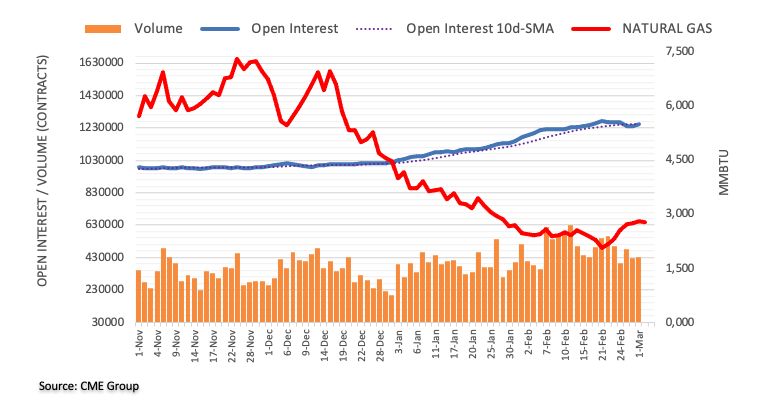
Economists at ING discuss GBP outlook for the day ahead. Risks are title to the downside, which could lift EUR/GBP to the 0.8930 mark.
Decision Maker Panel survey is key today
“We have a down arrow on GBP today, because of the release of the BoE's Decision Maker Panel survey. This has pointed to an easing in tight labour conditions including marginally weaker wage growth and less difficulty in recruitment. Assuming those trends continue, GBP interest rates can continue to fall behind those of the Eurozone and the US and see some modest Sterling downside.”
“EUR/GBP could make a run at the 0.8930 area.”
“Also today we have BoE speakers in the form of Silvana Tenreyro (super dove, not market moving) and Chief Economist, Huw Pill. He should follow Andrew Bailey's line and again probably presents a slightly negative event risk to Sterling.”
- GBP/USD meets with a fresh supply on Thursday amid a strong pickup in the USD demand.
- Hawkish Fed expectations continue to push the US bond yields higher and underpin the USD.
- A sustained break below the 200-day SMA is needed to support prospects for deeper losses.
The GBP/USD pair comes under some fresh selling pressure following the previous day's good two-way price swings and drifts lower through the first half of the European session. The downward trajectory drags spot prices back closer to mid-1.1900s in the last hour and well within the striking distance of a technically significant 200-day Simple Moving Average (SMA).
A combination of factors assists the US Dollar to regain strong positive traction, which, in turn, is seen exerting some downward pressure on the GBP/USD pair. The prospects for further policy tightening by the Fed continue to push the US Treasury bond yields higher. Apart from this, a softer risk tone - amid looming recession risks - lends additional support to the safe-haven Greenback.
Investors seem convinced that the Fed will stick to its hawkish stance in the wake of stubbornly high inflation. Furthermore, the incoming US macro data pointed to an economy that remains resilient despite rising borrowing costs and should allow the Fed to keep rates higher for longer. Moreover, FOMC policymaker Neel Kashkari opened the door for a 50 bps hike at the next meeting in March.
Kashkari noted that the risk of under-tightening is greater than the risk of over-tightening as inflation in the US is still very high. Separately, Atlanta Fed President Raphael Bostic maintained the view the policy rate needs to rise to the 5.00%-5.25% range and remain at that level well into 2024. This, in turn, remains supportive of elevated US bond yields and continues to underpin the Greenback.
In fact, the yield on the benchmark 10-year US government bond climbs further beyond the 4.0% threshold, to its highest level since November 2022, further fueling worries about economic headwinds stemming from rising borrowing costs. Apart from this, anxiety over the new UK-UK Brexit deal on the Northern Ireland Protocol weighs on the British Pound and drags the GBP/USD pair lower.
The price action, meanwhile, indicates that additional rate hike by the Bank of England (BoE) is already fully priced in the markets. Moreover, some analysts still hope that the UK central bank would pause the current tightening cycle, suggesting that the path of least resistance for the GBP/USD pair is to the downside. Spot prices, however, might still find some support near the 200-day SMA.
Nevertheless, the fundamental backdrop now seems tilted firmly in favour of bearish traders. Hence, any attempted recovery could be seen as a selling opportunity and runs the risk of fizzling out rather quickly. Traders now look to the release of the usual US Weekly Initial Jobless Claims, which, along with the US bond yields, will drive the USD and provide some impetus to the GBP/USD pair.
Technical levels to watch
China’s Vice Commerce Minister said in a statement on Thursday, “China is willing to conduct candid consultations with the US to reduce restrictions on bilateral trade and investment.”
Additional comments
“China-US trade has been highly complementary, resilient.”
“Need to create a stable and predictable economic and trade environment between China and US to enhance confidence of business cooperation.”
“The risk of a global economic recession is growing, the external environment poses serious challenges, and there is a greater risk of weakening external demand.”
Market reaction
AUD/USD popped roughly 10-pips higher on the upbeat Chinese headlines. The pair bounced off daily lows of 0.6726 to test 0.6740, where it now wavers. The spot is still down 0.35% on the day amidst unrelenting US Dollar demand.
Economist Lee Sue Ann and Markets Strategist Quek Ser Leang at UOB Group see further rebound could motivate NZD/USD to revisit the 0.6300 zone in the next few weeks.
Key Quotes
24-hour view: “The strong bounce in NZD to 0.6275 and the strong daily at 0.6257 (+1.16%) came as a surprise (we were expecting NZD to trade in a range. The strong rebound has scope to extend but in view of the overbought conditions, a clear break of the major resistance at 0.6300 is unlikely. On the downside, a breach of 0.6215 (minor support is at 0.6235) would indicate that the current upward pressure has eased.”
Next 1-3 weeks: “We have held a negative NZD view since two weeks ago. Yesterday (01 Mar, spot at 0.6180), we noted that downward momentum has decreased and we indicated that ‘the chance of 0.6100 coming into view has diminished’. NZD subsequently soared above our ‘strong resistance’ level at 0.6225. The breach of the ‘strong resistance’ level indicates that NZD weakness has ended. We view the current price actions as part of a rebound and not the start of a sustained advance. The rebound could extend to 0.6300. All in all, only a breach of 0.6180 (‘strong support’ level) would indicate that NZD is not rebounding further.”
European Central Bank (ECB) President Christine Lagarde, in an interview with Spanish TV on Thursday, is touching upon topics such as the economic impact of the war in Ukraine and rising prices and interest rates hikes.
Key quotes
“Inflation has lowered in the last three months though has risen a bit in February, so price decline is not stable.“
“We are sure prices will go down but inflation is still too high.”
“Bringing down inflation will however still take some time.”
“The base effects are likely to slow March inflation.”
more to come ...
Market reaction
EUR/USD is holding lower near 1.0630 on Lagarde’s comments, losing 0.30% so far.
Considering advanced prints from CME Group for crude oil futures markets, open interest rose by around 5.8K contracts after four consecutive daily pullbacks. Volume followed suit and rose for the second straight session, this time by around 56.2K contracts.
WTI targets $80.00 and above
Prices of the WTI look to extend the weekly recovery amidst Wednesday’s rising open interest and volume, suggesting that further gains lie ahead in the very near term. Against that, the next target of note aligns at the February high near $80.60 (February 13).
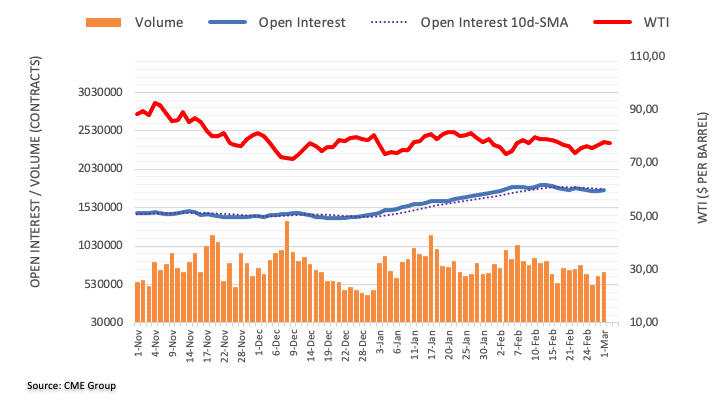
The Euro might finally steal the Follar’s thunder today, as the inflation rate for February will be published. The shared currency might receive considerable support, depending on how high the February rate will be in the end, economists at Commerzbank report.
The hour of the Euro?
“Market expects a slight decrease to 8,3% for the headline inflation and stable core inflation at 5.3%. If the numbers surprise significantly to the upside, the market might expect the ECB to go even higher, or at least stay higher for longer, which could lift the Euro above the 1.07 mark.”
“We urge caution though: the market always looks ahead and, as a result, focus will soon be back on the US labour market report next week. So despite the fact that today is likely to be the hour of the euro, focus might soon be back on USD.”
See – Eurozone HICP Preview: Forecasts from six major banks, core inflation to reach new record high
European Central Bank (ECB) President Christine Lagarde, in an interview with Spanish TV on Thursday, is touching upon topics such as the economic impact of the war in Ukraine and rising prices and interest rates hikes.
Key quotes
“The case for a 50 bps rate hike this month is still on the table as inflation is still too high.”
“We have to use all tools at our disposal to bring inflation down.”
“The future rate path will be data-dependent.”
“We will do what is needed to bring inflation down to our 2% target.”
“It would be a mistake to compare price situation in Europe with the US.”
“We still have to pursue higher interest rates, we don't know the peak yet.”
“We will have to stay at higher levels for a period of time.”
“It does not lie in the hands of the ECB to decide on mortgage conditions.”
Market reaction
EUR/USD is a little impressed by the comments from ECB President Lagarde, trading 0.33% lower on the day at 1.0628, as of writing.
Economists at the Bank of America Global Research expect the Australian Dollar to strengthen later in the year and target AUD/USD at 0.74 by end-2023.
AUD/USD seen at .069 by end-1Q
“We are bullish AUD/USD in the medium term due to the lagged impact of China property easing and reopening, alongside the Fed ending its tightening cycle in 2023.”
“We forecast 0.74 by year-end but more neutral near term (0.69 end-1Q) especially given the ongoing repricing of US rates and US Dollar strength.”
- Gold price edges lower on Thursday and snaps a three-day winning streak to a one-week high.
- Resurgent US Dollar demand, rising US bond yields and hawkish Federal Reserve exerts pressure.
- Looming recession risks could lend some support to the XAU/USD and help limit further losses.
Gold price comes under some selling pressure on Thursday and stalls this week's recovery move from the $1,805-$1,804 region, or its lowest level since December 23. The XAU/USD remains depressed around the $1,830 area through the early European session and for now, seems to have snapped a three-day winning streak to a one-week high touched on Wednesday.
Reviving US Dollar demand weighs on Gold price
The US Dollar (USD) regains positive traction and reverses a part of the previous day's sharp retracement slide from a multi-week high. This, in turn, is seen as a key factor exerting some downward pressure on the US Dollar-denominated Gold price. The markets seem convinced that the Federal Reserve (Fed) will keep interest rates higher for longer in the wake of stubbornly high inflation in the United States (US). The bets were reaffirmed by the overnight hawkish remarks by Fed officials., which continue to underpin the Greenback.
Rising US Treasury bond yields also undermine XAU/USD
In fact, Atlanta Fed President Raphael Bostic maintained the view the policy rate needs to rise to the 5.00%-5.25% range and remain at that level well into 2024. Adding to this, Minneapolis Fed President Neel Kashkari reiterated that inflation in the US is still very high and that their job is to bring it down. Karikari also noted that the risk of under-tightening is greater than the risk of over-tightening. This remains supportive of the ongoing move up in the US Treasury bond yields higher and contributes to driving flows away from the non-yielding Gold price.
Recession risks could lend support to Gold price
Investors, meanwhile, remain worried about economic headwinds stemming from rapidly rising borrowing costs. This, in turn, keeps a lid on the overnight optimism led by the upbeat Chinese PMI prints and could offer some support to the safe-haven Gold price. Hence, it will be prudent to wait for strong follow-through selling before positioning for the resumption of the recent downfall witnessed over the past month or so. Traders now look to the release of the US Weekly Initial Jobless Claims data for some impetus later during the early North American session.
Gold price technical outlook
From a technical perspective, the overnight swing high, around the $1,844 area, now seems to act as an immediate hurdle. Some follow-through buying has the potential to lift Gold price further towards the 50-day Simple Moving Average (SMA), currently pegged around the $1,866 region. The latter should act as a pivotal point, which if cleared decisively will set the stage for a further near-term appreciating move.
On the flip side, any subsequent decline might now find some support near the $1.822-$1,821 region ahead of the $1,810 level and the weekly low, around the $1,805-$1,804 zone. This is closely followed by the $1,800 round-figure mark and the 100-day SMA, currently around the $1,795 area. A convincing break below the said support levels will be seen as a fresh trigger for bearish traders and make Gold prices vulnerable to slide further.
Key levels to watch
Economists at CIBC Capital Markets expect further ECB activism and a building recovery story to maintain a constructive medium-run EUR outlook.
Looking for a 3.50% ECB terminal rate
“The presumption of price pressures remaining elevated amidst an improved macro backdrop leaves us comfortable in terms of looking for a 3.50% ECB terminal rate.”
“While the market may have overreacted in terms of recent implied policy presumptions, we expect further ECB activism and/or a building recovery story to maintain a constructive medium-run EUR outlook.”
“Q2 2023: 1.10 | Q3 2023: 1.11 (EUR/USD)”
- The index leaves behind part of Wednesday’s marked pullback.
- US 2-year yields approach the key 5% level, nearly 6-year tops.
- Weekly Claims, FOMC Waller take centre stage later in the US docket.
The greenback, in terms of the USD Index (DXY), manages to regain some balance and advances to the 104.80 region on Thursday.
USD Index looks to yields, data
The index keeps the choppy performance well in place so far this week and now looks to revisit the 105.00 neighbourhood on the back of the knee-jerk in the risk-associated universe and the unabated march north in US yields.
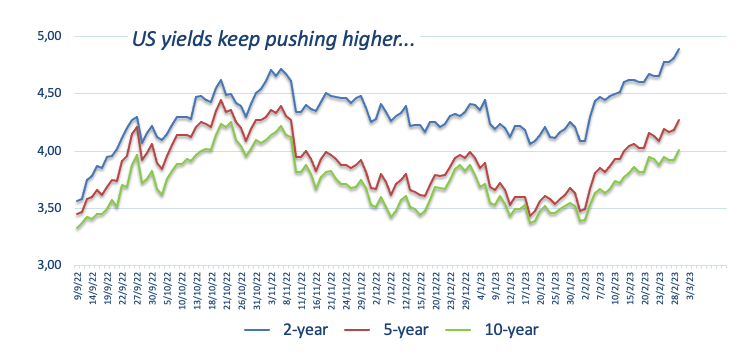
On the latter the short end of the curve gradually approaches the key 5% threshold for the first time since early July 2007 along with persistent hawkish Fedspeak and dwindling probability of a 25 bps rate hike at the Fed’s March 22 gathering.
In the docket, weekly Initial Claims will be in the limelight seconded by the speech by FOMC C.Waller.
What to look for around USD
The index regains traction after Wednesday’s strong drops to the vicinity of the 104.00 region.
The probable pivot/impasse in the Fed’s normalization process narrative is expected to remain in the centre of the debate along with the hawkish message from Fed speakers, all after US inflation figures for the month of January showed consumer prices are still elevated, the labour market remains tight and the economy maintains its resilience.
The loss of traction in wage inflation – as per the latest US jobs report - however, seems to lend some support to the view that the Fed’s tightening cycle have started to impact on the still robust US labour markets somewhat.
Key events in the US this week: Initial Jobless Claims (Thursday) – Final Services PMI, ISM Non-Manufacturing (Friday).
Eminent issues on the back boiler: Rising conviction of a soft landing of the US economy. Persistent narrative for a Fed’s tighter-for-longer stance. Terminal rates near 5.5%? Fed’s pivot. Geopolitical effervescence vs. Russia and China. US-China trade conflict.
USD Index relevant levels
Now, the index is gaining 0.36% at 104.75 and faces the next resistance at 105.35 (monthly high February 27) seconded by 105.63 (2023 high January 6) and then 106.52 (200-day SMA). On the downside, the breakdown of 103.45 (55-day SMA) would open the door to 102.58 (weekly low February 14) and finally 100.82 (2023 low February 2).
Here is what you need to know on Thursday, March 2:
Markets seem to have turned cautious early Thursday with investors refraining from taking large positions. Eurostat will release the Harmonized Index of Consumer Price (HICP) data for February and the European Central Bank (ECB) will publish the Policy Meeting Accounts. In the second half of the day, Initial Jobless Claims and fourth-quarter Unit Labor Costs figures will be featured in the US economic docket.
The US Dollar Index declined sharply during the European trading hours on Wednesday amid improving risk mood. In the second half of the day, the USD managed to stay resilient against its major rivals after the ISM Manufacturing PMI survey revealed that the Prices Paid component climbed above 50. The benchmark 10-year US Treasury bond yield climbed above 4% for the first time since early November after this data and provided additional support to the USD. Meanwhile, Wall Street's main indexes ended up closing the day mixed as investors readjusted their positions on the first trading day of the month. US stock index futures also trade mixed early Thursday, reflecting the indecisive market stance, but the 10-year US T-bond yield holds above 4%.
EUR/USD climbed to a fresh weekly high near 1.0700 on Wednesday but came under renewed bearish pressure in the Asian session on Thursday. Annual HICP in the euro area is forecast to decline to 8.2% in February from 8.6% in January. ECB President Christine Lagarde will be speaking on the policy outlook in an interview with a Spanish TV in the European session.
Eurozone Inflation Preview: Eyes on monthly HICP amid heightened hawkish ECB bets.
GBP/USD failed to capitalize on the broad-based US Dollar weakness on Wednesday and closed the day flat. The pair stays on the back foot early Thursday and trades below 1.2000. Bank of England (BoE) Chief Economist Huw Pill is scheduled to deliver a speech later in the day.
Gold price edged higher and closed the third straight day in positive territory on Wednesday. Rising US Treasury bond yields, however, started to weigh on XAU/USD on Thursday and the pair was last seen trading in negative territory near $1,830.
USD/JPY regained its traction and climbed above 136.50 on Thursday after having struggled to find direction on Wednesday. Bank of Japan (BoJ) monetary policy board member Hajime Takata said earlier in the day that he does not see the need to take additional policy steps now to improve the market function. Meanwhile, the data from Japan revealed that Capital Spending rose by 7.7% in the fourth quarter, surpassing the market expectation of 2.8% by a wide margin.
Bitcoin gained 2% on Wednesday but lost its traction early Thursday. At the time of press, BTC/USD was down more than 1%, trading at around $23,350. Ethereum rose nearly 4% on Wednesday before turning south during the Asian trading hours on Thursday. ETH/USD trades in negative territory near $1,650.
GBP/USD is likely to maintain the ongoing consolidation within 1.1970-1.2150 range in the next weeks, note Economist Lee Sue Ann and Markets Strategist Quek Ser Leang at UOB Group.
Key Quotes
24-hour view: “We highlighted yesterday that ‘the sharp pullback has scope to extend but any decline is viewed as part of a lower trading range of 1.1970/1.2090’. We added, ‘a sustained drop below 1.1970 is unlikely’. GBP subsequently traded between 1.1965 and 1.2088 before closing little changed at 1.2025 (+0.06%). The price actions are likely part of a consolidation phase and today, we expect GBP to trade sideways between 1.1970 and 1.2085.”
Next 1-3 weeks: “Our update from two days ago (28 Feb, spot at 1.2065) is still valid. As highlighted, GBP is likely to consolidate and trade in a broad range of 1.1970 and 1.2150 for the time being.”
- USD/JPY catches fresh bids and climbs back closer to the YTD peak amid resurgent USD demand.
- Hawkish Fed expectations push the US bond yields higher and provide a fresh lift to the Greenback.
- The divergent Fed-BoJ policy outlook favours bullish traders and supports prospects for further gains.
The USD/JPY pair is seen building on the overnight late rebound from the 135.25 area and steadily climbs back closer to the YTD peak during the early European session on Thursday. The pair currently trades around the 136.70 region, with bulls now awaiting a sustained strength beyond the 100-day Simple Moving Average (SMA) before placing fresh bets.
The US Dollar regains positive traction and reverses a part of the previous day's sharp retracement slide from a multi-week high amid a further rise in the US Treasury bond yields. In fact, the yield on the benchmark 10-year US government bond climbs further beyond the 4.0% threshold, hitting its highest level since November 2022, and remains well supported by expectations for further policy tightening by the Fed. The markets seem convinced that the US central bank will keep interest rates higher for longer than previously estimated in the wake of stubbornly high inflation.
The bets were lifted by the overnight hawkish remarks by Atlanta Fed President Raphael Bostic, reiterating the view that the policy rate needs to rise to the 5.00%-5.25% range and remain at that level well into 2024. Adding to this, Minneapolis Fed President Neel Kashkari reiterated that inflation in the US is still very high and that their job is to bring it down. Karikari also noted that the risk of under-tightening is greater than the risk of over-tightening. Furthermore, the US ISM Manufacturing Index showed that the Prices Paid sub-component accelerated to 51.3 in February from 44.5.
The Japanese Yen (JPY), on the other hand, is undermined by the recent dovish remarks by the incoming BoJ Governor Kazuo Ueda and Deputy Governor nominee Shinichi Uchida, stressing the need to maintain the ultra-loose monetary policy. That said, the cautious market mood - amid looming recession risks - could benefit the JPY's safe-haven status and cap the upside for the USD/JPY pair. Hence, it will be prudent to wait for a convincing breakout through the 100-day SMA barrier before positioning for an extension of the recent appreciating move witnessed over the past month or so.
Market participants now look forward to the release of the usual Weekly Initial Jobless Claims data from the US, due later during the early North American session. This, along with the US bond yields, will drive the USD demand and provide some impetus to the USD/JPY pair. Traders will further take cues from the broader risk sentiment to grab short-term opportunities ahead of speeches by influential FOMC members during the Asian session on Friday.
Technical levels to watch
Open interest in gold futures markets increased for the second session in a row on Wednesday, this time by around 4.7K contracts according to preliminary readings from CME Group. Volume, instead, resumed the downtrend and shrank by nearly 5K contracts.
Gold: Interim hurdle comes at $1860
Gold prices extended the rebound on Wednesday amidst increasing open interest, leaving the door open to the continuation of this move in the very near term. That said, the immediate up barrier now emerges at the 55-day SMA at $1860 per ounce troy.
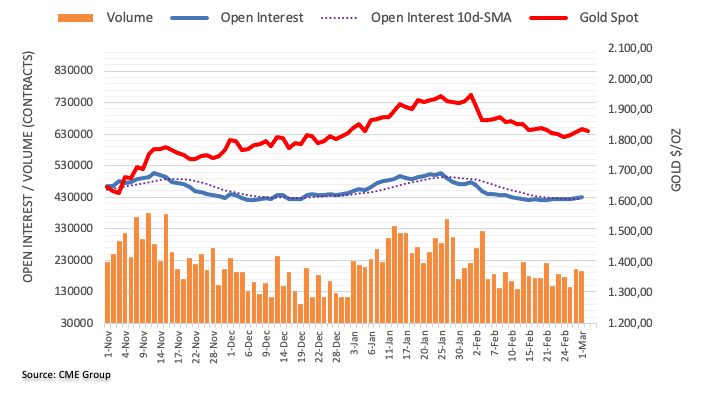
Gold price is back in the red for the first time in four trading days. XAU/USD sellers could extend control after rejection near 21-Daily Moving Average (DMA), FXStreet’s Dhwani Mehta reports.
XAU/USD turns south after rejection below the 21-DMA hurdle
“The extension of the upside break from a falling wedge lost legs just below the descending 21-DMA, now at $1,847.”
“The Gold price retracement could test the previous day’s low at $1,823 on a sustained move below the $1,830 immediate support. Deeper declines could threaten the confluence support at around $1,795, where the falling wedge resistance-turned-support and the bullish 100-DMA merge.”
“On the flip side, the previous day’s high at $1,845 could act as the immediate upside barrier. Recapturing the bearish 21-DMA is critical for the recovery to regain its momentum. The next critical resistance is envisioned at the mildly bullish 50-DMA at $1,857.”
See – Gold Price Forecast: XAU/USD to find a floor above its 200-DMA at $1,775 – Credit Suisse
- EUR/USD extends pullback from one-week high, pares the biggest daily gains in a month.
- Strong US Treasury bond yields join risk-negative headlines to renew US Dollar demand.
- Upbeat German inflation, hawkish ECB rhetoric puts a floor under the Euro price.
- Flash readings of Eurozone HICP and CPI will precede ECB President Lagarde’s speech to entertain EUR/USD traders.
EUR/USD prints mild losses around intraday low of 1.0635 as it pares the biggest daily gain in a month while reversing from the one-week high during early Thursday. In doing so, the major currency pair justifies the broad US Dollar strength ahead of the key Eurozone inflation numbers and a speech from the European Central Bank (ECB) President Christine Lagarde.
That said, US Dollar Index (DXY) extends the bounce off a one-week low to 104.70 at the latest, up 0.27% intraday, as the hawkish bias of the major central bank officials joins inflation fears to propel the yields.
Also adding strength to the US Dollar could be the upbeat details of the US ISM Manufacturing PMI for February. On the contrary, Germany’s Inflation number, per the Consumer Price Index (CPI), stayed unchanged at 8.7% YoY for February versus 8.5% expected. However, the annual Harmonised Index of Consumer Prices (HICP), the ECB's preferred gauge of inflation, edged higher to 9.3% from 9.2% in January, compared to analysts' estimate of 9%.
On Wednesday, Minneapolis Federal Reserve (Fed) President Neel Kashkari reiterated his previous calls for higher interest rates while citing the fears emanating from the services inflation. On the same line, ECB Governing Council member Madis Muller said, “Rate hikes are having an effect but inflation is still too high.” Further, ECB policymakers Joachim Nagel and Francois Villeroy de Galhau also highlighted the inflation fears to suggest the need for higher rates.
It should be noted that the fading optimism over China’s economic growth recently joined the fears of the Sino-American tussles and exerted additional downside pressure on the EUR/USD prices.
Against this backdrop, the US 10-year Treasury bond yields rose to the highest levels since early November 2022 by piercing the 4.0% mark, around 4.02% at the latest, whereas the two-year counterpart rallied to the highest levels since June 2007 by flashing the 4.92% mark by the press time. The jump in the US Treasury bond yields portrays the market’s fears, which in turn probed bulls on Wall Street and weigh on S&P 500 Futures as of late.
Looking ahead, the first readings of February’s Eurozone Consumer Price Index (CPI) and the ECB’s preferred inflation gauge, namely HICP, will be crucial for the EUR/USD traders to watch for clear directions. Additionally, ECB President Lagarde’s speech also appears crucial for the near-term guide.
Also read: Eurozone Inflation Preview: Eyes on monthly HICP amid heightened hawkish ECB bets
Technical analysis
Failure to provide a daily closing beyond the 50-day Exponential Moving Average (EMA), currently around 1.0660, triggers EUR/USD pullback towards the 200-day EMA retest, close to 1.0535 at the latest.
FX option expiries for Mar 2 NY cut at 10:00 Eastern Time, via DTCC, can be found below.
- EUR/USD: EUR amounts
- 1.0545 583m
- 1.0595 2.0b
- 1.0625 1.8b
- 1.0660 797m
- 1.0800 847m
- USD/JPY: USD amounts
- 134.90 350m
- 136.00 770m
- 136.65 855m
- 138.00 400m
- EUR/GBP: EUR amounts
- 0.8900 300m
In the opinion of Economist Lee Sue Ann and Markets Strategist Quek Ser Leang at UOB Group, the probability that EUR/USD could convincingly break above 1.0750 appears to be losing traction.
Key Quotes
24-hour view: “Our view for EUR to ‘edge lower’ was incorrect as it surged to 1.0691 before closing on a strong note at 1.0665 (+0.84%). Upward momentum has improved, albeit not much. Today, EUR could advance further to 1.0705. The major resistance at 1.0750 is unlikely to come into view. Support is at 1.0645, followed by 1.0620.”
Next 1-3 weeks: “We indicated yesterday (01 Mar, spot at 1.0580) that the recent weakness in EUR has ended and we were of the view that EUR is likely to consolidate between 1.0530 and 1.0670 before heading lower at a later stage. We did not anticipate the strong rise in EUR to 1.0691. While the strong rise suggests there is scope for EUR to strengthen further, any advance is likely part of a corrective rebound. At this stage, the chance of a sustained rise above 1.0750 is not high. Overall, only a breach of the ‘strong support’ level, currently at 1.0590, would indicate that EUR is not rebounding further.”
- AUD/USD takes offers to extend pullback from late February.
- Previous resistance line, weekly horizontal support can challenge Aussie pair bears amid descending RSI towards oversold territory.
- U-turn from immediate upside hurdle, bearish MACD signals keep sellers hopeful; bulls need validation from 200-HMA.
AUD/USD holds lower grounds near the intraday bottom surrounding 0.6730, reversing the previous day’s gains heading into Thursday’s European session.
In doing so, the Aussie pair extends the previous day’s pullback from the February 23 swing low amid bearish MACD signals.
Adding strength to the downside bias is the lower-high formation since late Wednesday, as well as the quote’s sustained trading below the 200-Hour Moving Average (HMA).
Amid these plays, the AUD/USD pair is all set for further downside.
However, a convergence of the previous resistance line from February 20 and a horizontal area comprising the lows marked so far during the current week, around the 0.6700 round figure, appears a tough nut to crack for the sellers.
Not only the stated support confluence but the RSI (14) line also challenges the Aussie pair’s further downside by speedily dropping towards the oversold territory.
In a case where the AUD/USD remains bearish past 0.6700, a quick fall toward December 2022 low surrounding 0.6630 can’t be ruled out.
On the flip side, a successful break of the aforementioned horizontal resistance near 0.6785 guards the AUD/USD pair’s immediate upside. Following that, the 200-HMA level of near 0.6800 may act as the last defense of the bears.
AUD/USD: Hourly chart

Trend: Limited downside expected
- NZD/USD has printed a fresh day low at 0.6222 amid the risk-off mood.
- A mean reversion to near 50-EMA is offering a bargain buy to investors.
- The RSI (14) is expected to find a cushion around 40.00.
The NZD/USD pair has refreshed its day low at 0.6222 in the early European session. The Kiwi asset has sensed pressure and soaring US yields have dampened the market mood. The 10-year US Treasury yields have jumped to near 4.03% and are showing no signs of exhaustion yet.
S&P500 futures have tumbled in the Asian session as investors are worried about the recession situation in the United States economy, considering the fact that the Federal Reserve (Fed) will push rates above 5% and will keep them steady beyond 2023. The US Dollar Index (DXY) has refreshed its day high above 104.70 amid the risk-off market mood.
NZD/USD has corrected to near the 50-period Exponential Moving Average (EMA) at around 0.6223 after failing to extend its bullish reversal above the horizontal resistance placed from February 21 high at 0.6263 on an hourly scale.
A scrutiny of the Relative Strength Index (RSI) (14) indicates that the momentum oscillator has already delivered a bullish reversal. The oscillation range of the RSI (14) has already shifted to 40.00-80.00. Therefore, the momentum indicator is expected to find a cushion at 40.00.
The Kiwi asset is offering a buying opportunity near the 50-EMA at 0.6223, which could push the major toward March 1 high at 0.6276 followed by the round-level resistance at 0.6300.
In an alternate scenario, a breakdown of January 6 low at 0.6193 will drag the asset toward November 28 low at 0.6155. A slippage below the latter will expose the asset for more downside toward the round-level support at 0.6100.
NZD/USD hourly chart
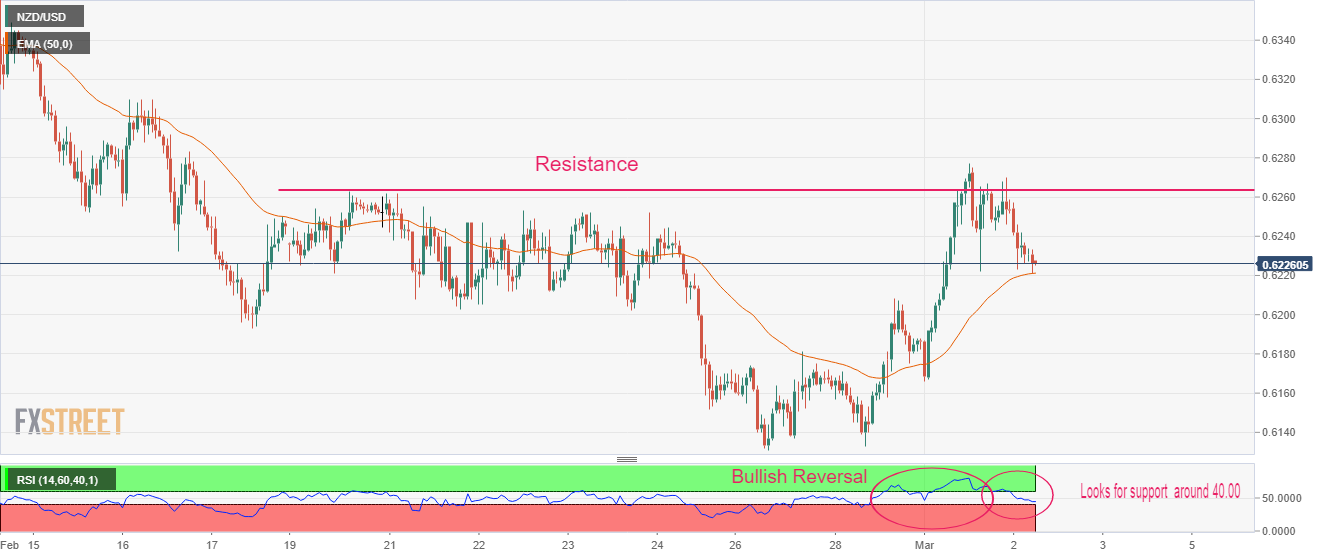
“China may aim for higher 2023 GDP growth target than the 4.5-5.5% proposed in November,” Reuters reported on Thursday, citing sources involved in policy discussions.
Additional takeaways
“China's GDP growth target could range between 5%-5.5%, and be as high as 6%.”
“China to stick to a long-standing inflation target of around 3%.”
Market reaction
Amidst risk aversion, the AUD/USD pair is failing to capitalize on the report suggesting optimistic Chinese growth prospects. The pair is trading 0.41% lower at daily lows near 0.6730.
Bank of Japan (BoJ) monetary policy board member Hajime Takata is back on wires in early Europe this Thursday, expressing his take on the monetary policy outlook.
Key quotes
Will need some time to gauge impact of Dec steps on market function.
Don't see need now to take additional steps to improve market function.
Impact of overseas economic slowdown already showing in Japan’s factory output.
There is still uncertainty on whether wages will rise enough especially among small, regional firms.
Want to look comprehensively at various data in gauging Japan's trend inflation.
Not just price indicators, but whether Japan achieving positive wage-inflation cycle, also key to gauging Japan's trend inflation.
Market reaction
USD/JPY is extending the upside toward 137.00 amid a broad-based US Dollar rebound, firmer US Treasury bond yields and dovish BoJ commentary. The spot is trading at 136.65, adding 0.35% on the day, as of writing.
- USD/TRY keeps poking the all-time high marked in February, grinds higher of late.
- US Dollar traces US Treasury bond yields to reverse week-start losses.
- Downbeat Turkish data, geopolitical tension and CBRT’s hesitance to raise rates keep buyers hopeful.
- Friday’s Turkish CPI, US ISM Services PMI appear crucial for clear directions.
USD/TRY tests bullish commitments around 18.90 amid a sluggish session during early Thursday. In doing so, the Turkish Lira (TRY) pair takes clues from the firmer US Treasury bond yields while also portraying the cautious mood ahead of Turkish inflation data for February, up for publishing on Friday.
Hawkish comments from the key central bankers join fears surrounding China and Russia to renew the market’s economic pessimism, which in turn drowns the US Treasury bonds amid a lack of major data/events. The same joins mostly firmer US data, versus downbeat Turkish statistics, to favor the USD/TRY bulls.
Against this backdrop, the US 10-year Treasury bond yields rose to the highest levels since early November 2022 by piercing the 4.0% mark whereas the two-year counterpart rallied to the highest levels since June 2007 by flashing the 4.92% mark at the latest. The jump in the US Treasury bond yields portrays the market’s fears, which in turn probed bulls on Wall Street and weigh on S&P 500 Futures as of late.
It should be noted that the US ISM Manufacturing PMI flashed upbeat details and allowed Minneapolis Federal Reserve (Fed) President Neel Kashkari to reiterate his hawkish bias. However, the Turkish Gross Domestic Product (GDP), trade numbers and economic confidence have all been softer in their latest readings and propelled the USD/TRY prices.
Apart from the data imbalance and hawkish Fed concerns, as well as the yields, the Central Bank of the Republic of Turkiye’s (CBRT) hesitance in lifting the benchmark interest rates joins the latest earthquake in the nation to keep the pair buyers hopeful.
Moving on, USD/TRY may keep grinding higher amid a lack of major data/events scheduled for release on Thursday. However, tomorrow’s Turkish Consumer Price Index (CPI) for February and the US ISM Services PMI for the said month will be crucial for the pair traders to watch for clear directions.
Technical analysis
Unless breaking the year 2021’s high surrounding 18.40, the USD/TRY bulls seem gradually rushing toward the 20.00 psychological magnet.
- Investors are showing caution for Asian stocks amid soaring US Yields.
- Chinese equities have failed to capitalize on upbeat Caixin Manufacturing PMI data.
- Upbeat Caixin PMI and lower-than-expected US oil inventory report have infused fresh blood into the oil bulls.
Markets in the Asian domain have turned cautious as US Treasury yields are soaring like there is no tomorrow. The alpha offered on the 10-year US government bonds has refreshed its three-month high at 4.03%. The demand for US government bonds has dropped dramatically as investors are expecting the United States recession a reality as the Federal Reserve (Fed) looks set to push rates above 5% sooner. S&P500 futures have stretched their downside, portraying a negative market sentiment.
At the press time, Japan’s Nikkei225 remained flat, SZSE Component eased 0.26%, Hang Seng dropped 0.40%, and Nifty50 tumbled 0.56%.
Chinese equities have failed to capitalize on upbeat Caixin Manufacturing PMI data. The Chinese economy looks set on a path of economic recovery as the administration and the People’s Bank of China (PBoC) are pumping stimulus to spur the growth rate. Dismantling of the pandemic controls is allowing firms to operate at their full capacity.
Meanwhile, Bank of Japan (BoJ) policymakers are constantly chanting dovish stances on monetary policy guidance. After dovish commentaries from BoJ Governor Nominee Kazuo Ueda and BoJ Deputy Governor Ryozo Himino, the current monetary policy has also been considered as appropriate by board member Junko Nakagawa. He cited “An expansionary policy is highly essential for supporting the economy and fueling wages.”
On the oil front, oil prices are looking to extend their recovery to $78.00 in hopes of recovery in China post the release of the Caixin Manufacturing PMI, which overshadowed the risk of a global recession. Also, the less-than-anticipated build-up of oil inventories reported by the United States Energy Information Administration (EIA) has infused fresh blood into oil bulls. The US EIA reported a build-up of oil stockpiles by 1.165 million barrels for the week ending February 24.
- USD/CAD clings to mild gains after defying a bullish chart formation.
- Upbeat oscillators, sustained trading beyond previous resistance line keep buyers hopeful.
- 100-DMA appears the key support, Loonie buyers have multiple hurdles on the north.
USD/CAD bulls struggle to keep the reins around the 1.3600 threshold during early Thursday in Europe.
The Loonie pair’s latest grinds could be linked to the mixed technical signals witnessed on the Daily chart, as well as the market’s inaction.
That said, the USD/CAD pair slipped beneath a two-week-old bullish channel’s lower line the previous day, which in turn suggested the quote’s declines towards the resistance-turned-support from mid-December 2022, close to 1.3550 by the press time.
However, the 100-DMA level surrounding the 1.3500 threshold and multiple tops marked during late January, as well as early February, near 1.3470, could challenge the USD/CAD bears past 1.3550.
Alternatively, the bullish MACD signals and upbeat RSI (14), not oversold, keeps USD/CAD buyers hopeful of bouncing back beyond the previous support line of the stated channel, near 1.3620.
Following that, the tops marked in February and January, respectively around 1.3665 and 1.3685 will precede the December 16, 2022 swing high of 1.3705 to challenge the USD/CAD buyers.
To sum up, USD/CAD is likely to remain sidelined between the previous support line surrounding 1.3550 and the immediate channel’s lower line of near 1.3620.
USD/CAD: Daily chart
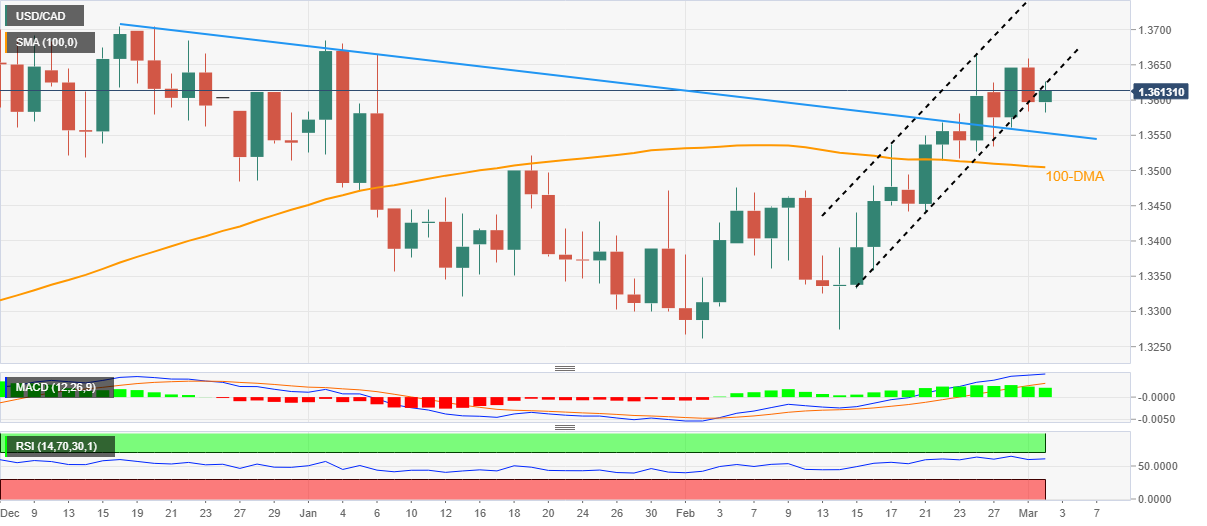
Trend: Limited upside expected
- GBP/USD extends pullback from one-month-old descending resistance line to print three-day downtrend.
- DUP dislikes mismatch between Brexit deal and UK PM Sunak’s promises, British businesses fear economic slowdown due to the terms.
- BoE’s Bailey appeared neutral and probed Cable buyers.
- Upbeat details of US ISM PMI, Fed talks underpin yields and the US Dollar amid sluggish day.
GBP/USD bears attack the 1.2000 psychological magnet during a three-day downtrend amid fresh challenges for the Brexit deal and a rally in the US Treasury bond yields. However, the market’s lack of action heading into Thursday’s London open appears to restrict the Cable pair’s immediate downside.
That said, The Telegraph came out with the downbeat updates surrounding the Brexit deal while citing the Democratic Unionist Party’s (DUP) dissatisfaction with the parts of the previously hailed EU-UK departure terms over the Northern Ireland Protocol (NIP). “Sammy Wilson, the Unionist party’s Brexit spokesman in the Commons, suggested that parts of the Windsor Framework do not tally with what the Prime Minister has said in public,” said the news.
Elsewhere, the Financial Times (FT) came out with a survey saying that about two-thirds of UK businesses believe that government plans to disentangle British and EU law will cause more uncertainty and will not increase economic growth, according to a poll conducted on behalf of an alliance of environmental and public safety organizations.
It should be noted that the neutral comments from Bank of England (BoE) Governor Andrew Bailey, versus the hawkish remarks from Minneapolis Federal Reserve (Fed) President Neel Kashkari, also weigh on the GBP/USD prices. On the same line are the downbeat prints of the UK S&P/CIPS Manufacturing PMI versus the upbeat details of the US ISM Manufacturing PMI.
On a different page, consistent inflation woes and fading optimism over China’s economic growth, recently joined by the fears of the Sino-American tussles, also exert downside pressure on the GBP/USD prices. Amid these plays, the US 10-year Treasury bond yields rose to the highest levels since early November 2022 by piercing the 4.0% mark whereas the two-year counterpart rallied to the highest levels since June 2007 by flashing the 4.91% mark at the latest. The jump in the US Treasury bond yields portrays the market’s fears, which in turn probed bulls on Wall Street and weigh on S&P 500 Futures as of late.
With the risk-off mood and firmer yields, the US Dollar Index (DXY) bounces off a one-week low to 104.60 at the latest, up 0.17% intraday.
Looking ahead, a light calendar can restrict GBP/USD moves and may keep it southwards ahead of Friday’s key US ISM Services PMI and final readings of the UK S&P Global/CIPS Services PMI for February.
Technical analysis
Unless providing a daily close beyond the one-month-old descending resistance line, around 1.2075 by the press time, the GBP/USD remains vulnerable to test an upward-sloping trend line from January 06, close to 1.1935 at the latest.
- USD/INR has displayed a sheer recovery to near 82.60 as hawkish Fed bets have fueled US yields.
- A formation of an Ascending Triangle indicates volatility contraction with a bullish bias.
- The 50-period EMA at 82.30 is likely to provide a cushion to the US Dollar bulls.
The USD/INR pair has picked strength after gauging significant buying interest around 82.35 in the Asian session. The asset has scaled sharply to 82.60 and is aiming to extend gains further as US Treasury yields are skyrocketing on expectations that the Federal Reserve (Fed) will push borrowing rates above 5% by summer.
The US Dollar Index (DXY) is gathering strength to deliver a break above the immediate resistance of 104.30. The 10-year US Treasury yields have printed a fresh three-month high at 4.03%. Meanwhile, S&P500 futures have extended their losses further, portraying a risk-aversion theme.
USD/INR is forming an Ascending Triangle chart pattern on a daily scale that indicates volatility contraction with a bullish bias. The upward-sloping trendline of the chart pattern is placed from November 14 low at 80.48 while the horizontal resistance is plotted from October 19 high at 83.10.
The 50-period Exponential Moving Average (EMA) at 82.30 is likely to provide a cushion to the US Dollar bulls.
Meanwhile, the Relative Strength Index (RSI) (14) has slipped into the 40.00-60.00 range from the bullish range of 60.00-80.00, indicating a lackluster performance ahead.
A decisive break above March 01 high at around 82.62 will drive the asset toward February 28 high around 82.75 followed by February 27 high around 82.95.
On the flip side, a confident break below March 1 low at 82.34 will drag the major toward the round-level support of 82.00 and January 17 high at 81.89.
USD/INR daily chart

- Gold price holds lower ground after reversing from one-week high, snaps three-day winning streak.
- US Treasury bond yields refresh multi-month highs amid inflation, rate hike fears.
- China-linked optimism fades ahead of G20; US data, Fed talks also weigh on sentiment and XAU/USD price.
Gold price (XAU/USD) seesaws around the intraday low of $1,831 during the first loss-making day in four heading into the European session. In doing so, the precious metal justifies the firmer US Dollar and risk-off mood in the market amid a sluggish Thursday.
US Dollar Index (DXY) bounces off a one-week low to 104.60 at the latest, up 0.17% intraday as the greenback bulls trace strong US Treasury bond yields, as well as cheer the sour sentiment amid hawkish Federal Reserve (Fed) talks.
That said, the US 10-year Treasury bond yields rose to the highest levels since early November 2022 by piercing the 4.0% mark whereas the two-year counterpart rallied to the highest levels since June 2007 by flashing the 4.91% mark at the latest. The jump in the US Treasury bond yields portrays the market’s fears, which in turn probed bulls on Wall Street and weigh on S&P 500 Futures as of late.
While tracing the key catalysts upbeat details of the US ISM Manufacturing PMI for February and headlines from the New York Times (NYT) suggesting the US-China likely tension the Group of 20 (G20) meeting seems to gain major attention. On the same line could be the hawkish Minneapolis Federal Reserve (Fed) President Neel Kashkari, as well as the policymakers of the Bank of England (BoE) and the European Central Bank (ECB).
On the contrary, the recent pick-up in China activity data and upbeat comments from the policymakers of the dragon nation keeps the Gold buyers hopeful. Recently, China’s Human Resource Minister said, “China's employment will continue to improve this year, and remains stable overall.” On Wednesday, China Finance Minister Liu He showed readiness to bolster the nation’s fiscal spending while also mentioning that the foundation of China's economic recovery is still not stable.
Moving on, updates from the G20 could join central bankers’ comments and the second-tier data from the US to entertain the XAU/USD traders.
Gold price technical analysis
Gold price stays depressed after reversing from a three-week-old horizontal resistance area, around $1,844-48. The pullback moves also coincide with the RSI (14) retreat from the overbought territory and bearish MACD signals to keep XAU/USD sellers hopeful.
However, a convergence of the 200 and 50 Simple Moving Averages (SMAs), near $1,827 by the press time, appears the key support to challenge the metal’s further downside.
Even if the quote drops below the $1,827 SMA confluence, the previous resistance line from February 09, close to $1,817 can act as the last defense of the Gold buyers.
Alternatively, recovery moves need to cross the $1,848 hurdle to convince XAU/USD bulls to aim for the early February tops surrounding $1,870. Following that, $1,890 and $1,900 could test the upside momentum ahead of directing the Gold price toward the previous monthly peak of $1,960.
Overall, the Gold price remains on the back foot even if the downside seems to have little room.
Gold price: Hourly chart
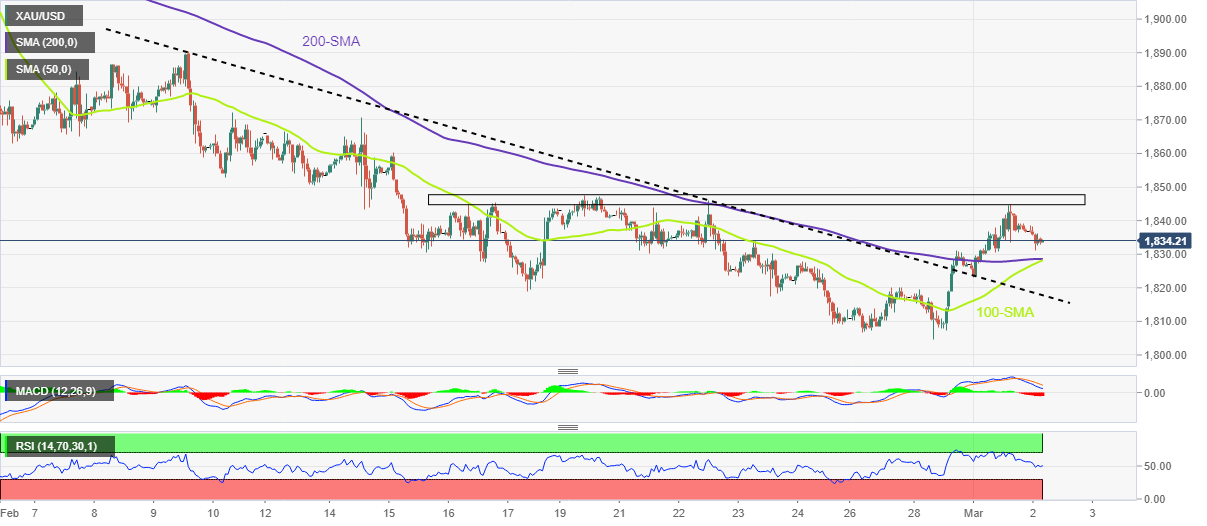
Trend: Limited downside expected
- EUR/USD is prone to more downside as it has surrendered the critical support of 1.0660 amid the risk-off mood.
- Escalating odds of a revival in US inflation have fueled US Treasury yields.
- The ECB is expected to continue its 50 bps policy tightening spree till the May policy meeting.
The EUR/USD pair is on the verge of delivering a sheer downside move as it is looking vulnerable below the critical support of 1.0660 in the Asian session. The downside bias in the major currency pair is backed by soaring US Treasury yields, which is demonstrating a significant decline in the risk appetite of the market participants.
S&P500 futures have carry-forwarded Wednesday’s bearish trading session amid a fourth consecutive contraction in the United States ISM Manufacturing PMI. The Manufacturing PMI has been contracting for the past four months. The US Dollar Index (DXY) is aiming to deliver a break above the immediate resistance of 104.30 amid the risk aversion theme. The return offered on 10-year US Treasury bonds has scaled to near 4.03%.
A scrutiny of US ISM Manufacturing PMI data is delivering cues pointing to a recovery in the Consumer Price Index (CPI). A strong jump in the New Orders Index data to 47.0 from the expectations of 43.7 and the former release of 42.5 is portraying a bright outlook.
Apart from that, Manufacturing Prices Paid jumped to 51.3 from the expectations of 45.0. Producers might look for passing the impact of higher prices paid to the ultimate consumers, which will trigger the inflation spiral again. Therefore, the Federal Reserve (Fed) believes that halting more rates announcement would be premature at the current stage.
On the Eurozone front, a rebound in the German Harmonized Index of Consumer Prices (HICP) has cleared that inflation is exceptionally stubborn. Therefore, more rate hikes from the European Central Bank (ECB) cannot be ruled out.
Analysts at Goldman Sachs have revised their guidance on interest rates for the ECB higher. The ECB to raise its rate by 50 basis points (bps) in May, compared to the 25 bps rate. A rate hike of 50 bps for March monetary policy has already been announced by ECB President Christine Lagarde. The investment banking firm forecasts a peak for the ECB rates at 3.75% by June versus the previous forecast of 3.50%.
Former Bank of Japan (BoJ) Governor Masaaki Shirakawa urges the policymakers to reconsider central banks' monetary framework based on inflation targets, in a column published by the International Monetary Fund (IMF) on Wednesday.
Key takeaways
“Before the recent spike in inflation, many central banks in advanced economies were "overwhelmingly" concerned about low inflation, and failed to restrain rapid price gains by judging them as transitory.”
“By allowing inflation to overshoot their targets, central banks forgot the difficulty of taking away the monetary punch bowl and failed to tighten policy soon enough.”
"Inflation targeting itself was an innovation that came about in response to the severe stagflation of the 1970s and early 1980s. There is no reason to believe it is set in stone.”
"Now that we know its limitations, the time is ripe to reconsider the intellectual foundation on which we have relied for the past 30 years and renew our framework for monetary policy.”
- AUD/USD is putting efforts into defending the 0.6730 support despite a dismal market mood.
- The 10-year US Treasury yields have printed a fresh three-month high of 4.02%.
- Upbeat US Manufacturing New Orders Index data is fueling US Treasury yields.
The AUD/USD pair has demonstrated a buying interest after dropping to near 0.6730 in the Asian session. The Aussie asset is expected to turn sideways as wild movements are generally followed by volatility contraction. Also, the capped upside in the US Dollar Index (DXY) is restricting range extension in the Aussie asset.
Market mood is displaying caution as investors are worried that more rates from the Federal Reserve (Fed) will push the United States economy into a recession. S&P500 futures have incurred more losses, carry-forwarding weak Wednesday’s session. Investor shave underpinned the risk aversion theme whose impact is clearly visible on the US government bonds. The 10-year US Treasury yields are constantly refreshing their three-month high as the Fed is set to push interest rates by 5% by summer.
At the press time, the 10-year US Treasury yields have printed a high of 4.02%. However, the USD Index is struggling to find direction after weak US Manufacturing PMI data.
On Wednesday, the US ISM reported a surprise decline in the Manufacturing PMI figures. The economic data contracted consecutively for the fourth time, landed at 47.7, lower than the consensus of 48.0 but higher than the former release of 47.4.
The catalyst that is supporting yields is the Manufacturing New Orders Index data, which indicates robust forward demand and could fuel inflationary pressures. The economic data jumped strongly to 47.0 from the expectations of 43.7 and the former release of 42.5, portraying a bright outlook.
Meanwhile, a sheer decline in the monthly Australian monthly Consumer Price Index (CPI) is expected to restrict the Australian Dollar to the downside. The monthly CPI (Jan) dropped significantly to 7.4% from the expectations of 8.0% and the prior release of 8.4%. A mammoth decline in the inflation data mush has provided a big relief to Reserve Bank of Australia (RBA) policymakers. Also, a decline in the Gross Domestic Product (GDP) (Q4) was a cherry on the cake.
- USD/JPY grinds near intraday top after lackluster moves in the last two days.
- Sustained trading beyond key SMA, short-term important horizontal support keeps buyers hopeful.
- One-month-old ascending resistance line can challenge the latest run-up.
USD/JPY struggles to overcome the previous two-day inaction as bulls keep the reins around 136.30 during early Thursday. In doing so, the Yen pair prints mild gains after bouncing off the 50-bar Simple Moving Average (SMA) and a two-week-old horizontal support zone.
Not only a sustained recovery from the key technical levels but the easing bearish bias of the MACD signals also favor the USD/JPY pair buyers.
With this, the risk-barometer pair is well-set to poke an upward-sloping resistance line from early February, close to 137.30 by the press time,
It’s worth noting that the weekly top surrounding 136.90 and the 137.00 round figure could act as immediate resistances for the USD/JPY bulls to watch.
In a case where USD/JPY remains firmer past 137.30, the late 2022 peak surrounding 138.20 should return to the charts.
On the flip side, the 50-SMA level of near 135.40 acts as an adjacent support for the Yen pair. Following that, the aforementioned two-week-long horizontal support zone puts a floor under the USD/JPY price of around 135.05-25.
It should be noted that the 100-SMA level of 134.00 and the February 20 swing low of around 133.95 could act as the last defense of the USD/JPY buyers.
To sum up, USD/JPY is likely to remain firmer and can once again poke the key resistance line stretched from February.
USD/JPY: Four-hour chart

Trend: Limited upside expected
- WTI crude oil remains sidelined near two-week high after rising in the last two days.
- China data, policymakers’ comments suggest more energy demand from the world’s biggest commodity user.
- Fears of inflation, geopolitical concerns propel yields and challenge risk profile, as well as the Oil price.
- Downbeat inventories, US SPR issues keep sellers hopeful.
WTI crude oil price grinds near $77.80-90 during early Thursday, following a two-day uptrend that poked the highest levels in a fortnight.
The black gold’s latest struggles could be linked to the mixed clues surrounding China, as well as the Oil stocks. However, sour sentiment and the US Dollar’s rebound appear the major upside hurdles for the quote.
That said, higher-than-expected US inventories also weigh on the energy benchmark as the Weekly data from the US Energy Information Administration (EIA) signals a 1.165M build in the Oil stocks versus 0.457M expected and 7.648M prior.
Elsewhere, US President Joe Biden’s readiness to keep pumping the markets with the Strategic Petroleum Reserve (SPR), as well as the lack of bids for Russian Oil, also exert downside pressure on the WTI crude oil price.
On the same line are the latest headlines from the New York Times (NYT) which suggest a possible rift between the US and China at the key event. “China is urging the start of peace talks, and some Group of 20 nations could support that idea when they gather in India, but U.S. officials argue Russia would not negotiate in good faith,” said the news.
It should be noted, however, that the recent pick-up in China activity data and upbeat comments from the policymakers of the dragon nation keeps the black gold buyers hopeful. Recently, China’s Human Resource Minister said, “China's employment will continue to improve this year, and remains stable overall.” On Wednesday, China Finance Minister Liu He showed readiness to bolster the nation’s fiscal spending while also mentioning that the foundation of China's economic recovery is still not stable.
That said, hawkish comments from the policymakers of the US Federal Reserve (Fed), the Bank of England (BoE) and the European Central Bank (ECB) also highlighted the need for further rate lifts to battle the inflation woes, which in turn exert downside pressure on the Oil price.
Amid these plays, the US 10-year Treasury bond yields rose to the highest levels since early November 2022 by piercing the 4.0% mark whereas the two-year counterpart rallied to the highest levels since June 2007 by flashing the 4.91% mark at the latest. The jump in the US Treasury bond yields portrays the market’s fears, which in turn probed bulls on Wall Street and weigh on S&P 500 Futures, as well as WTI bulls, as of late. As a result, the S&P 500 Futures dropped half a percent by the press time despite the mixed closing of the Wall Street benchmarks.
Moving on, updates from the G20 could join central bankers’ comments and the second-tier data from the US to entertain the Oil traders.
Technical analysis
WTI crude oil buyers need to cross a five-week-old resistance line, around $78.70 by the press time, to push back bears.
| Raw materials | Closed | Change, % |
|---|---|---|
| Silver | 20.984 | 0.45 |
| Gold | 1836.76 | 0.55 |
| Palladium | 1440.23 | 2.1 |
- USD/CHF picks up bids to reverse the previous day’s losses.
- Sustained trading above the key Fibonacci retracement, upbeat oscillators join bullish chart pattern to favor buyers.
- Sellers have a bumpy road to face on their return, 0.9345 appears short-term key support.
USD/CHF renews its intraday high around 0.9415 as bulls return to the table, after the previous day’s absence, during early Thursday. In doing so, the Swiss currency pair remains firmer past the 61.8% Fibonacci retracement level of its downturn from late November 2022 to early February 2023.
Not only the successful trading beyond the 61.8% Fibonacci retracement, also known as the golden Fibonacci ratio, but the bullish MACD signals and upbeat RSI (14), not overbought, also keeps the USD/CHF buyers hopeful of witnessing further advances.
However, the 100-DMA hurdle surrounding 0.9445 guards the pair’s immediate upside.
Following that, the stated channel’s top line and late November swing high could act as the last defenses of the USD/CHF bears around 0.9480 and 0.9550 respectively.
It’s worth observing that the November 21 high of around 0.9600 appears the key for the USD/CHF bulls to track afterward.
Meanwhile, pullback remains elusive till the quote stays inside the aforementioned bullish channel, established on February 10, currently between 0.9480 and 0.9345.
That said, the 61.8% Fibonacci retracement level of 0.9393 can act as immediate support.
Overall, USD/CHF is likely to remain firmer and can cross the 100-DMA immediate hurdle while its upside past 0.9480 appears doubtful.
USD/CHF: Daily chart
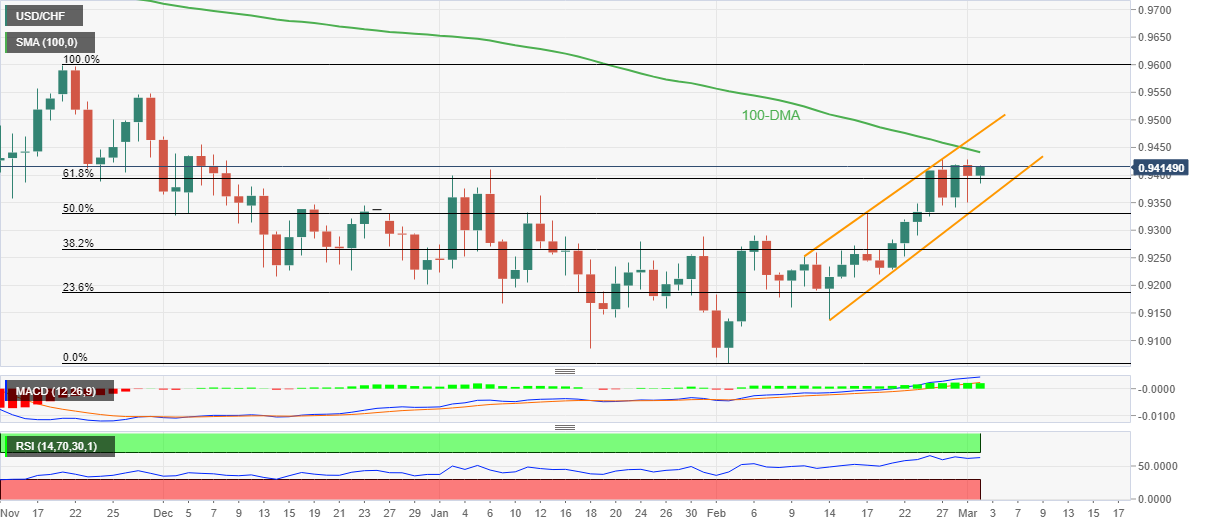
Trend: Further upside expected
- Market sentiment remains sour even despite mixed US data, China-linked optimism.
- Fears of likely tensions at the G20 talks, higher services inflation keep bears hopeful.
- US two-year Treasury bond yields rise to the highest level since June 2007, 10-year counterpart crosses the 4.0% threshold.
Risk profile deteriorates after an upbeat start of March as US Treasury bond yields rally to multi-month high and highlight the fears of higher inflation, as well as rates, during early Thursday. Adding strength to the risk-off mood could be the likely US-China tension at the Group of 20 (G20) meetings.
That said, the US 10-year Treasury bond yields rose to the highest levels since early November 2022 by piercing the 4.0% mark whereas the two-year counterpart rallied to the highest levels since June 2007 by flashing the 4.91% mark at the latest.
The jump in the US Treasury bond yields portrays the market’s fears, which in turn probed bulls on Wall Street and weigh on S&P 500 Futures of late. As a result, the S&P 500 Futures dropped half a percent by the press time despite the mixed closing of the Wall Street benchmarks.
While checking the roots, the US ISM Manufacturing PMI details for February gain major attention as the headline gauge rose to 47.7 during the said month from 47.4 prior, versus the 48.0 expected. However, the details of the stated key activity gauge suggest that the Prices Paid and New Orders marked the highest figures in five and four months respectively.
Ahead of the data, Minneapolis Federal Reserve (Fed) President Neel Kashkari said, "Wage growth is now too high to be consistent with 2% inflation." The policymaker also added and noted that it is concerning that the Federal Reserve's rate hikes so far have not brought down service inflation. Not only the Fed but policymakers from the Bank of England (BoE) and the European Central Bank (ECB) also highlighted the need for further rate lifts to battle the inflation woes.
Elsewhere, the market’s anxiety ahead of the Group of 20 (G20) meeting also weighs on the sentiment as the latest headlines from the New York Times (NYT) suggest a possible rift between the US and China at the key event. “China is urging the start of peace talks, and some Group of 20 nations could support that idea when they gather in India, but U.S. officials argue Russia would not negotiate in good faith,” said the news.
Amid these plays, the US Dollar Index (DXY) pare the previous day’s losses while bouncing off a one-week low whereas stocks in the Asia-Pacific zone trade mixed. Further, the Gold price joins the Oil to recall sellers after a few days of buyer’s dominance.
Moving on, updates from the G20 could join central bankers’ comments and the second-tier data from the US to entertain market players ahead of Friday’s US ISM Services PMI, which becomes the key amid fears of strong services inflation.
Analysts at Goldman Sachs now expect the European Central Bank (ECB) to raise its rate by 50 basis points (bps) in May, compared to the 25 bps rate hike projection in a research note earlier this week.
Also read: Eurozone Inflation Preview: Eyes on monthly HICP amid heightened hawkish ECB bets
Additional takeaways
“The bank now forecast peak by the European Central Bank to 3.75% by June (versus the previous forecast of 3.50%) citing,
higher than expected Spanish and French inflation numbers.
remarks from ECB chief economist Lane this week to the effect that rates will be held higher for longer.”
- EUR/GBP is looking to reclaim the 0.8900 resistance as ECB looks set to deliver one more 50 bps rate hike.
- Apart from the German economy, Spain and France have also reported higher-than-anticipated inflation figures.
- The street is not considering the novel UK-EU deal as a critical driver for the Pound Sterling.
The EUR/GBP pair is displaying a back-and-forth action around 0.8869 in the Tokyo session after a gradual correction from 0.8895. The cross is expected to resume its upside journey and reclaim the round-level resistance of 0.8900 as a surprise jump in the German Harmonized Index of Consumer Prices (HICP) has bolstered the case of a continuation of 50 basis points (bps) rate hike spree by the European Central Bank (ECB).
The preliminary German HICP (Feb) jumped to 9.3% from the estimates of 9.0% and the former release of 9.2%. The street was anticipating that lower energy prices and ease in supply chain bottlenecks will keep the Eurozone inflation in the declining territory. However, the Eurozone price index turns out stubborn and has triggered fears of more rates from the ECB ahead.
Apart from the German economy, February’s preliminary HICP numbers from Spain and France have also surprised the market participants with higher-than-anticipated figures. This shows an overall rebound in the price pressures, which indicates ECB President Christine Lagarde should be prepared for an exceptionally bumpy ride.
ECB policymaker Joachim Nagel reiterated on Wednesday that further significant rate hikes beyond March may be needed, as reported by Reuters. He further added, "Energy price drop has no essential bearing on ECB's medium-term inflation projections."
For further guidance, Eurozone HICP data will be in focus. Analysts at SocGen expect “February HICP to decelerate from 8.6% to 8.2% YoY, dragged down by energy inflation but core inflation should be up 0.2pp to 5.5% YoY and will likely stay above 3.5% this year.”
The speech from Bank of England (BoE) Governor Andrew Bailey failed to bring any action to the Pound Sterling as clear guidance on interest rates was absent.
Meanwhile, the street is not considering the novel UK-EU deal as a critical driver for the Pound Sterling. Economists at ING believe “The global risk environment and a potential narrowing in UK-Eurozone interest rate differentials are likely to prove more important drivers of Sterling than the new UK-EU deal.”
- GBP/USD is resisted by 1.2050 currently in a bearish bias on the charts.
- Bears seek a break of 1.2000 top open risks of significant downside in the coming sessions.
GBP/USD extended losses after remarks from Bank of England Governor Andrew Bailey. Speaking at a cost of living conference in London, Bailey said he would caution against suggesting the BOE is finished raising rates or that it will need to deliver more increases. Cable is techcniually coiled as well which the following technical analysis illustrates offering a bearish bias for the pair.
GBP/USD daily chart

Bears are looking for a break of the structure near 1.1900 to open a run towards 1.1650 as per the daily chart above while the price is at least below trendline resistance and capped by 1.2200 highs.
GBP/USD H1 chart
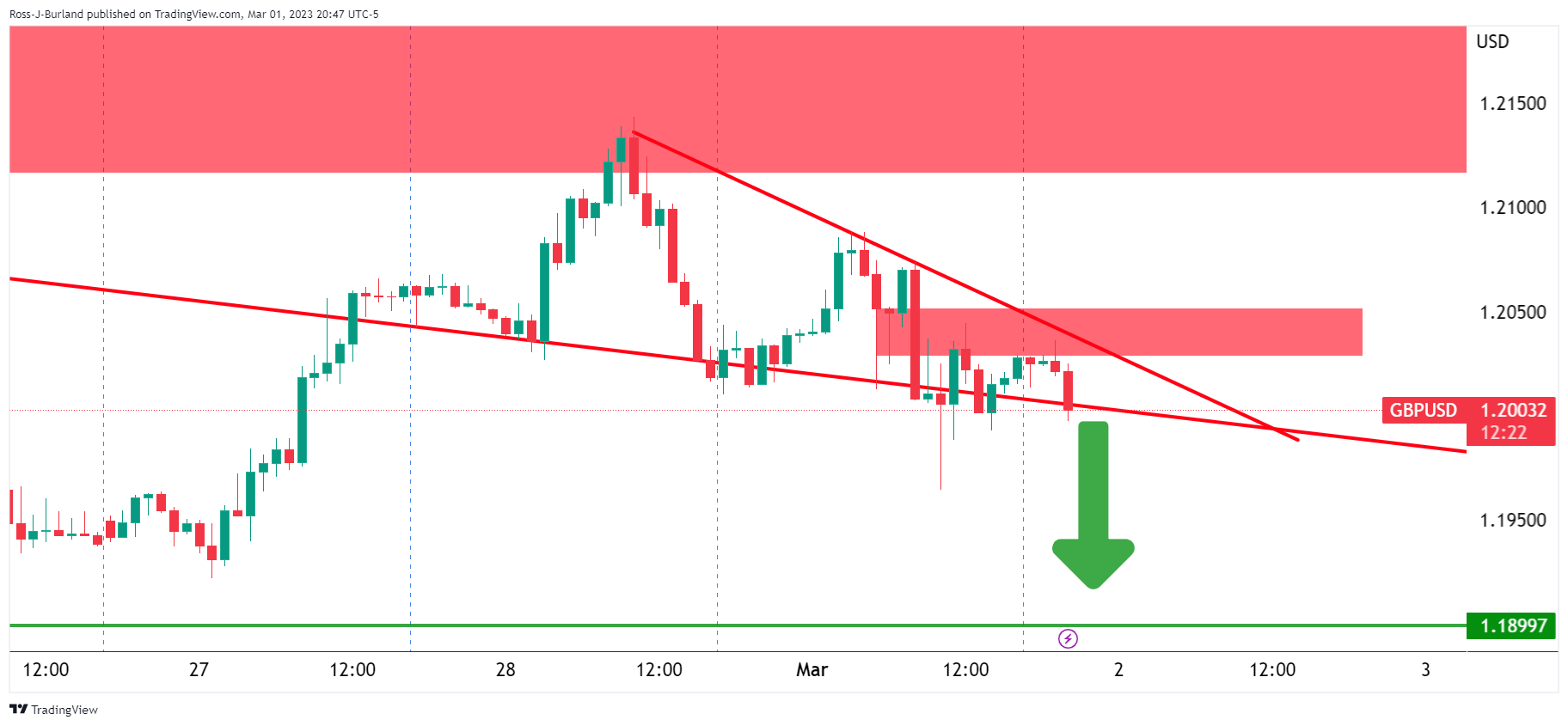
We have the resistance structure at 1.2050 currently and a break below 1.2000 could be the catalyst for a sharp move to the downside in the coming sessions.
Bank of Japan (BoJ) monetary policy board member Hajime Takata is shedding some light on the central bank’s inflation and policy outlook on Thursday.
Key quotes
Must maintain current massive monetary policy easing.
Inflation is higher due to rising raw material costs, but Japan has yet not yet experienced sustained price increases accompanied by wage increases.
CPI is thus likely to have a lower pace of increase in the second half of fiscal 2023.
If the economic slow down overseas intensifies that could be a weight on the economy of Japan and prices.
The outlook for Japanese wage negotiations is difficult to forsee due to economic uncertainty overseas.
If firms remain cautious about hiking pay that could prevent Japan from having a sustained rise in inflation.
Market reaction
USD/JPY is edging higher on the dovish BoJ commentary, trading near daily highs of 136.45, up 0.19% on the day.
- Silver price snaps two-day winning streak, renews intraday low of late.
- Clear U-turn from 200-DMA, bearish MACD signals hint at XAG/USD’s further downside.
- Three-week-old descending resistance line, horizontal area from the last December also challenge Silver buyers.
- Six-month-long upward-sloping trend line can restrict XAG/USD downside amid nearly oversold RSI (14).
Silver price (XAG/USD) takes offers to refresh intraday low near $20.90 as it prints the first daily loss in three during early Thursday. In doing so, the bright metal reverses from the 200-DMA amid the bearish MACD signals.
While a pullback from the key moving average and downbeat oscillator hints keep the XAG/USD sellers hopeful, the nearly oversold RSI (14) conditions suggest the quote has limited downside room.
As a result, an ascending support line from early September 2022, around $20.45, becomes crucial to watch for the Silver traders.
It should be noted that the lows marked during early November 2022, as well as on Wednesday, highlight $20.40 as an extra filter towards the south. Additionally, the $20.00 could act as the last defense of the XAG/USD buyers.
Hence, the Silver price is likely to extend the latest downturn but the room towards the south appears limited.
That said, the metal’s recovery moves past the 200-DMA hurdle of $21.00 isn’t an open invitation to the Silver buyers as a downward-sloping resistance line from February 08, close to $21.70 at the latest, could challenge the quote’s further advances.
Above all, the XAG/USD remains on the bear’s radar unless crossing a three-month-old horizontal resistance area surrounding $22.55-60.
Silver price: Daily chart

Trend: Limited downside expected
- GBP/JPY picks up bids to print the first daily gains in three.
- Hawkish comments from BoE’s Bailey versus BoJ officials’ defense of easy money policy recall buyers.
- Yields remain firmer amid inflation woes and keep GBP/JPY bulls hopeful.
- G20 headlines, comments from central bankers eyed for clear directions.
GBP/JPY teases buyers while picking up bids to 163.80 during early Thursday, following a two-day downtrend, as firmer yields join monetary policy divergence between the Bank of England (BoE) and the Bank of Japan (BoJ).
The cross-currency pair’s latest rebound could also be linked to the market’s anxiety ahead of the Group of 20 (G20) meeting as the latest headlines from the New York Times (NYT) suggest a possible rift between the US and China at the key event. “China is urging the start of peace talks, and some Group of 20 nations could support that idea when they gather in India, but U.S. officials argue Russia would not negotiate in good faith,” said the news.
Elsewhere, the US 10-year Treasury bond yields rose to the highest levels since early November 2022 by poking the 4.0% mark whereas the two-year counterpart rallied to the June 2007 levels by piercing the 4.90% mark at the latest. The jump in the US Treasury bond yields suggests the market’s fears of inflation and recession, which in turn probed bulls on Wall Street and weigh on S&P 500 Futures of late. It should be noted that the Japanese yen often traces the US Treasury bond yields.
It should be noted that the hawkish comments from BoE Governor Andrew Bailey contrast with those from the BoJ’s board member Junko Nakagawa to offer additional strength to the GBP/JPY recovery. BoE Governor Bailey said on Wednesday that some further increase in bank rates may turn out to be appropriate but added that nothing is decided, as reported by Reuters. On the other hand, BoJ’s Nakagawa said that an easy monetary policy is important for the time being, as it supports the economy.
Talking about the data, February’s Jibun Bank Manufacturing Japan and S&P/CIPS Manufacturing PMI for the UK improved a bit from their initial forecasts but remained below the 50.0 level differentiating the expansion from the otherwise in activities. Recently, Japan’s Capital Spending grew 7.7% during the fourth quarter (Q4) versus 9.8% previous readings and 2.8% market forecasts.
Moving on, updates from the G20 could join central bankers’ comments to entertain the GBP/JPY traders amid a likely sluggish day due to the light calendar.
Technical analysis
Wednesday’s Doji candlestick joins the GBP/JPY pair’s sustained trading above the 200-DMA, around 163.40 by the press time, to underpin the bullish bias for the quote.
In recent trade today, the People’s Bank of China (PBOC) set the yuan at 6.8808 vs. the last close of 6.8729.
About the fix
China maintains strict control of the yuan’s rate on the mainland.
The onshore yuan (CNY) differs from the offshore one (CNH) in trading restrictions, this last one is not as tightly controlled.
Each morning, the People’s Bank of China (PBOC) sets a so-called daily midpoint fix, based on the yuan’s previous day's closing level and quotations taken from the inter-bank dealer.
- Gold price is oscillating in a narrow range below $1840.00 as US yields refresh a three-month high above 4%.
- The USD Index is dealing with wild movements, which are generally followed by a volatility contraction.
- Tight US labor market looks to cool down ahead amid lower job postings on employment portals.
Gold price (XAU/USD) has delivered a downside break of the back-and-forth auction formed below the critical resistance of $1,840.00 in the Asian session. The precious metal has corrected gradually after a perpendicular upside move to $1,844.00.
The US Dollar Index (DXY) is dealing with wild movements, which are generally followed by a volatility contraction. S&P500 futures have surrendered their marginal gains and are now adding to Wednesday’s losses, portraying a rebound in the risk-aversion theme. Meanwhile, the 10-year US Treasury yields have refreshed their three-month high at 4.01%.
Wall Street Journal (WSJ) reported that figures from two large online recruitment companies ZipRecruiter Inc. and Recruit Holdings Co indicate a decline in the number of job postings in December. Contrary to that, the US Department of Labor reported huge job openings in December.
The Department clarified that more jobs are coming from restaurants, hospitals, nursing homes, and child-care centers and not from firms. Shark producers and big tech firms are focused on lay-off programs considering a dismal economic outlook. Therefore, the labor market could cool down sooner and the Federal Reserve (Fed), which is hiking rates to decelerate growth and inflation would consider the further decline in the policy tightening pace.
Gold technical analysis
Gold price is struggling to extend its reversal move above the horizontal resistance plotted from February 21 high at $1,843.90 on a two-hour scale. Earlier, the precious metal delivered a breakout of the downward-sloping trendline plotted from February 9 high at $1,890.27.
After a vertical move, a mean reversion to the 20-period Exponential Moving Average (EMA) at $1,831.50 is highly expected.
The Relative Strength Index (RSI) (14) has not surrendered the bullish range of 60.00-80.00, indicating that the upside momentum is still active.
Gold two-hour chart
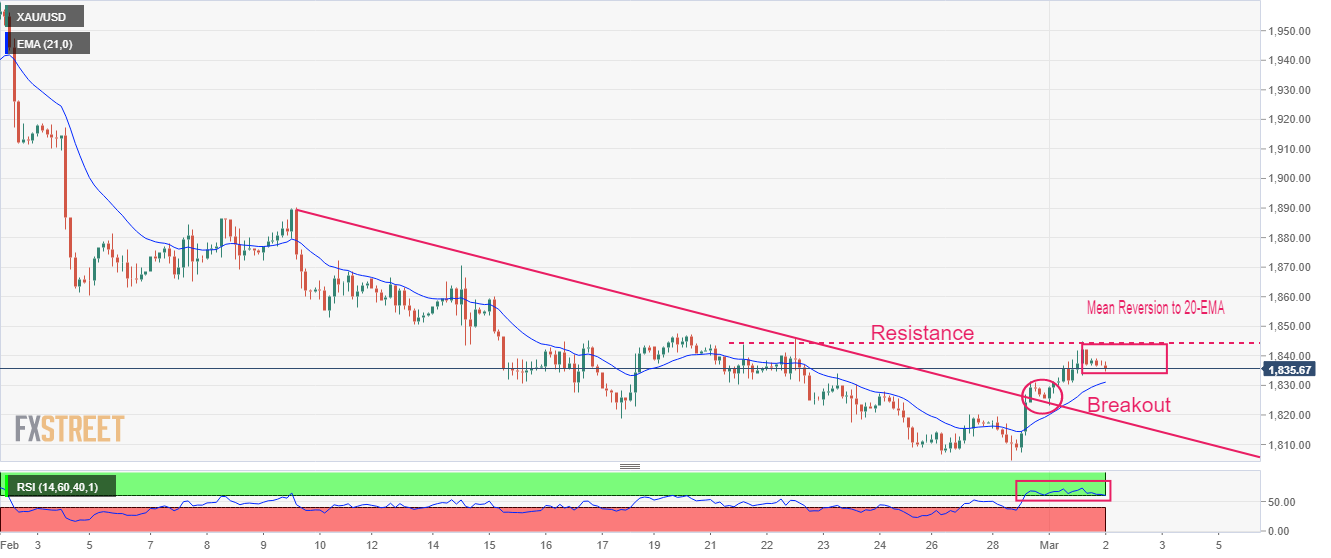
- NZD/USD bulls tiring as bears move in at the highs.
- Kiwi is under pressure despite the flows from overnight and positive news from China for commodities.
NZD/USD is down by some 0.27% and has fallen from a high of 0.6257 to a low of 0.6238, giving back some of the gains made midweek following the data that showed a revival in Chinese demand that bolstered commodity prices.
This followed a poor result in the Australian data whereby 4 Gross Domestic Product growth slowed to 0.5% QoQ in Australia, versus 0.7% previously, and consensus expectations of a 0.8% lift. The data raised the risk of an earlier pause in hikes from the Reserve Bank of Australia which initially weighed o both currencies.
However, the kiwi then benefited from a bout of speculative buying after the China Non-manufacturing activity grew at a faster pace in February, while the Caixin/S&P Global manufacturing PMI reading for last month likewise surpassed. The offshore yuan jumped 1.3% to 6.8683 per dollar, set for its largest one-day gain since late November.
The Kiwi also outperformed most peers and had done well on crosses, most notably NZD/AUD, analysts at ANZ Bank noted. ''EUR was a strong performer after the strong German CPI print, and the Kiwi went with it, potentially exacerbated by NZD/AUD stop-loss buying, as there wasn’t a clear NZD catalyst. That may see price action tame in the coming days.
The USD vibe is also changing. Strong data last week saw the DXY rally hard as bond yields there rose, but last night’s run of solid data has weighed on the dollar in a “good news is bad news” sort of way, likely on fears the Fed will engineer a recession. Is NZD's strength belated recognition of economic resilience and cyclone rebuilding? Has done well.''
- AUD/USD bulls are aiming for a test of key daily resistance.
- Bears eye a move below monthly support for a longer-term downtrend to develop.
AUD/USD is up high in the broadening range on the monthly chart which leaves the bias to the downside, longer term. However, in the meanwhile, there are prospects of a move lower as the following analysis will show.
AUD/USD monthly chart
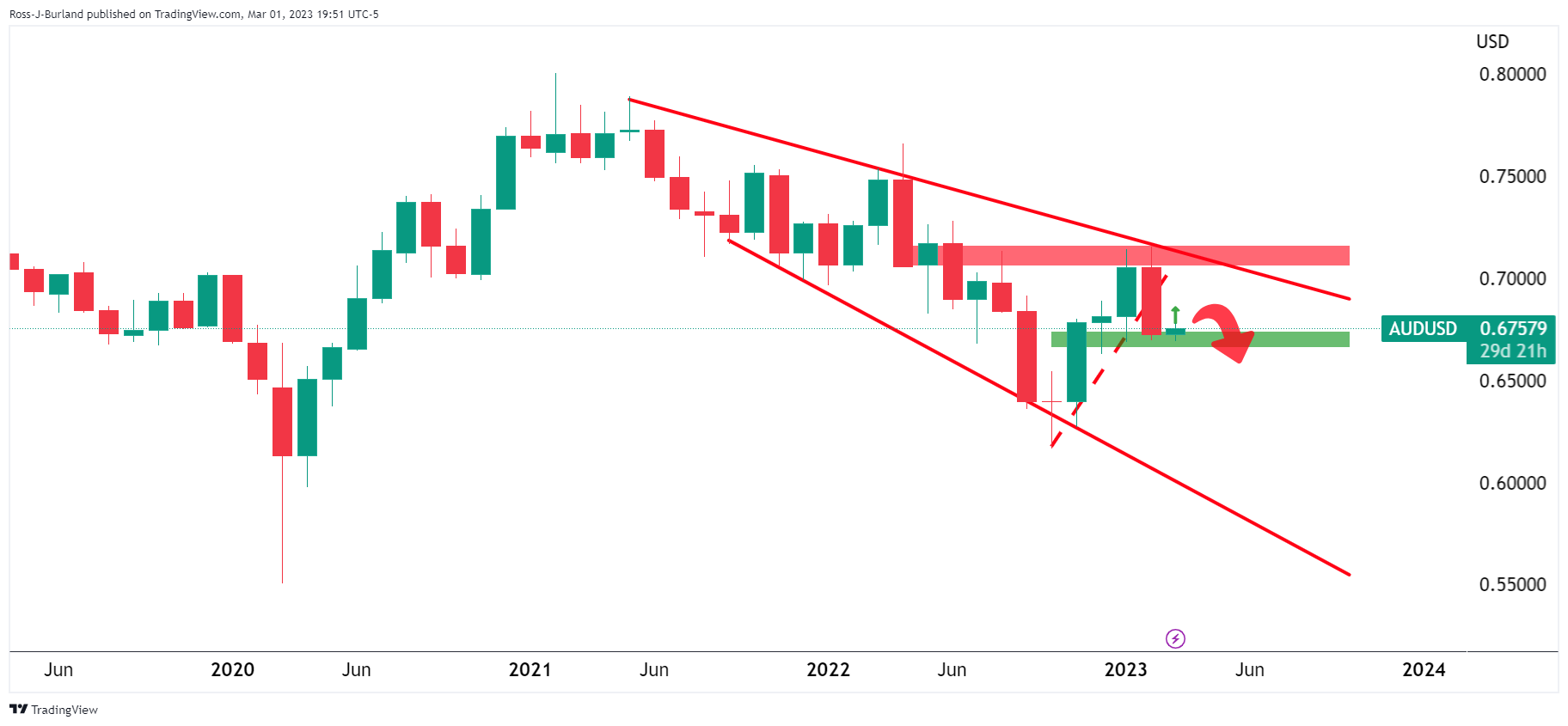
Bears need to get below the monthly support and until they do, the upside is favourable.
AUD/USD hourly chart
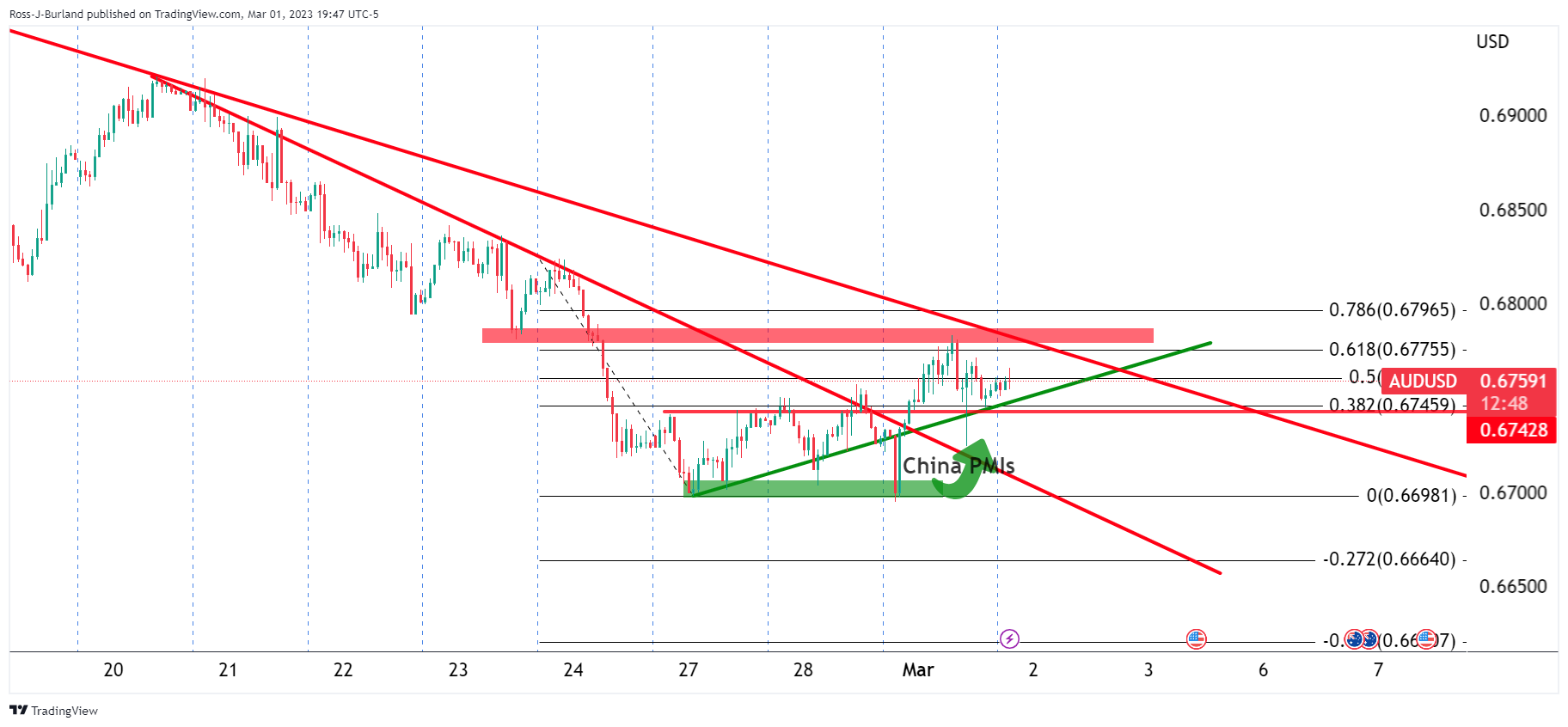
China's PMIs came in for the rescue following some very disappointing in local data just beforehand that sent the pair rolling towards the abyss and out of control of the bulls.
AUD/USD daily chart
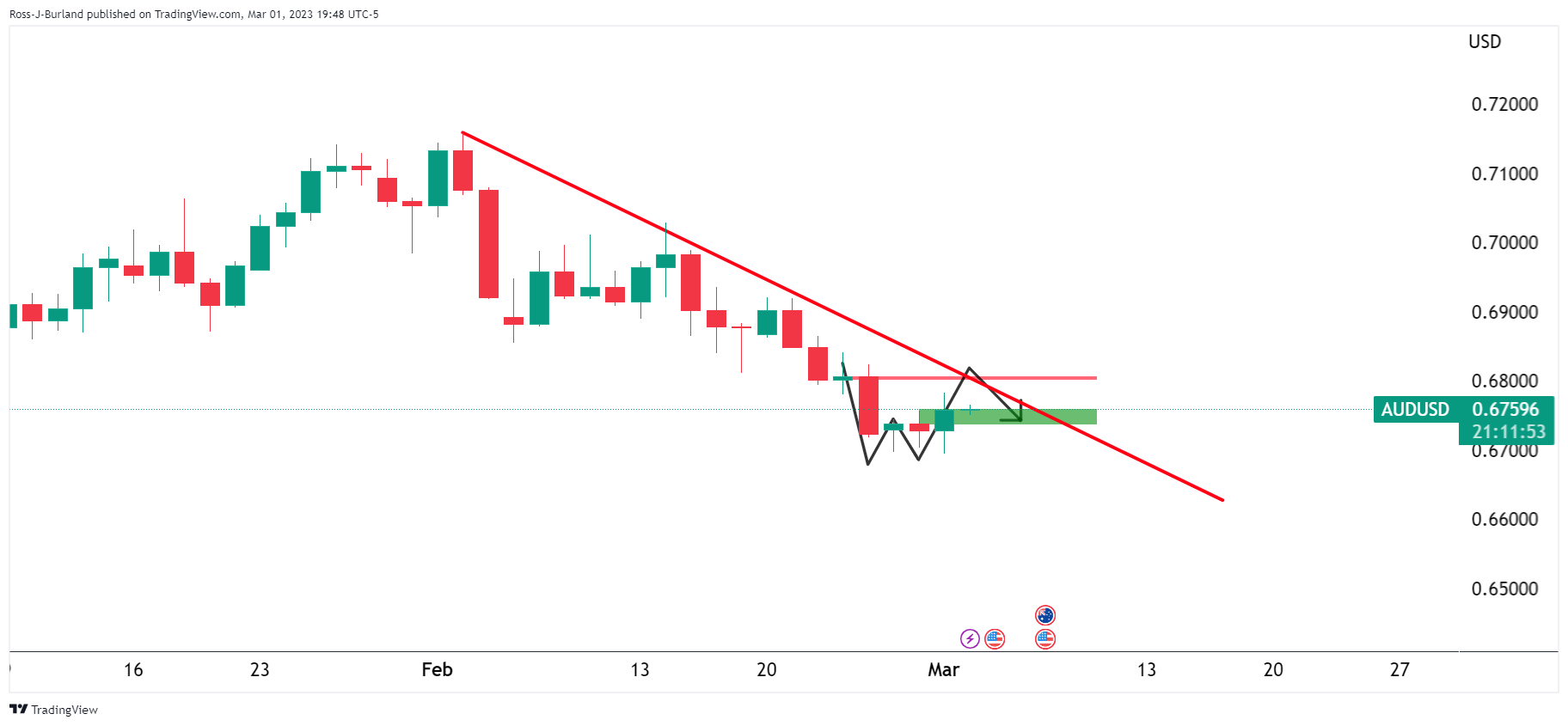
While the price moved higher, however, there is little room until the next major hurdle as being the daily trendline resistance as illustrated in the above chart. The W-formation is a reversion pattern that could also hamstring the price if it tries to go much further from the origin of the neckline in the pattern. A test and rejection at resistance will leave the downside bias in play thereafter and on a break of the neckline.
- EUR/USD remains sidelined around the key moving average after rising the most in one month.
- Successful bounce off 200-EMA, looming bull cross on MACD keep buyers hopeful.
- Six-week-old horizontal resistance, January’s top challenge Euro buyers.
EUR/USD treads water around 1.0660-70 during Thursday’s sluggish Asian session, after posting the biggest daily jump in a month. In doing so, the major currency pair seesaws around the 50-Exponential Moving Average (EMA).
That said, an impending bull cross on the MACD joins the Euro pair’s successful rebound from the convergence of a 200-EMA and 38.2% Fibonacci retracement of the quote’s run-up from November 2022 to February 2023 keeps the EUR/USD buyers hopeful.
It’s worth noting that a sustained break of the 50-EMA level surrounding 1.0665 could trigger the pair’s jump towards a 1.5-month-old horizontal resistance area near 1.0810.
Following that, the January 2023 peak of around 1.0930 could act as an extra filter towards the north before directing the EUR/USD bulls to the previous monthly top of 1.1033.
On the flip side, a daily closing beneath the 1.0535-30 support confluence, including the 200-EMA and aforementioned Fibonacci retracement level, appears a tough nut to crack for the EUR/USD bears.
Even if the EUR/USD price breaks the 1.0530 support, lows marked during January 2023 and the 50% Fibonacci retracement level, respectively around 1.0480 and 1.0380, could try defending the pair buyers before welcoming the bears.
Overall, EUR/USD remains on the bull’s radar despite the latest inaction. However, the upside room appears limited.
EUR/USD: Daily chart

Trend: Limited upside expected
- WTI bulls are in control but a sea of change could be occurring.
- A move into longs could be the game play for the remainder of the week.
WTI bulls are in the market amid signs of stronger demand in Asia and Europe. Fundamentally, US commercial crude oil inventories gained less than expected last week, rising only 1,166kbbl. However, US exports of crude hit a record high of 5,629kbbl last week (+22.4% w/w). However, technically, we are running into potentially overbought territory as the following will illustrate:
WTI H1 chart
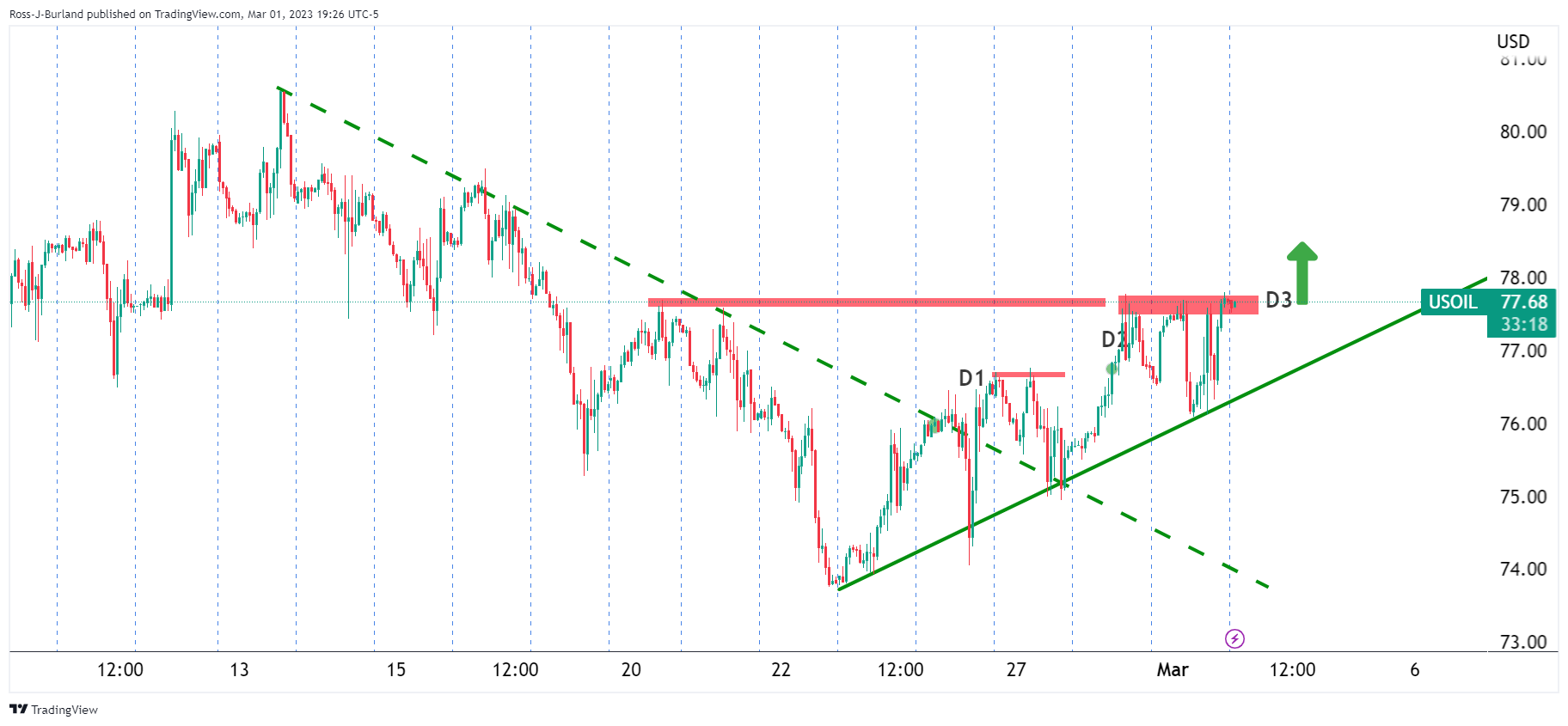
Looking at the weekly template, we can see that we are entering the third day of being up high in the bull trend and a fresh his could constitute for a sell-high opportunity for the sessions ahead. The bulls will need to drive through the resistance, trapping longs into the market only to get reversed into by a falling market which is where the opportunity could lie for the bears. $77.70 is key as potential resistance whereby a pull might occur should bulls not manage to significantly break the level.
WTI daily chart
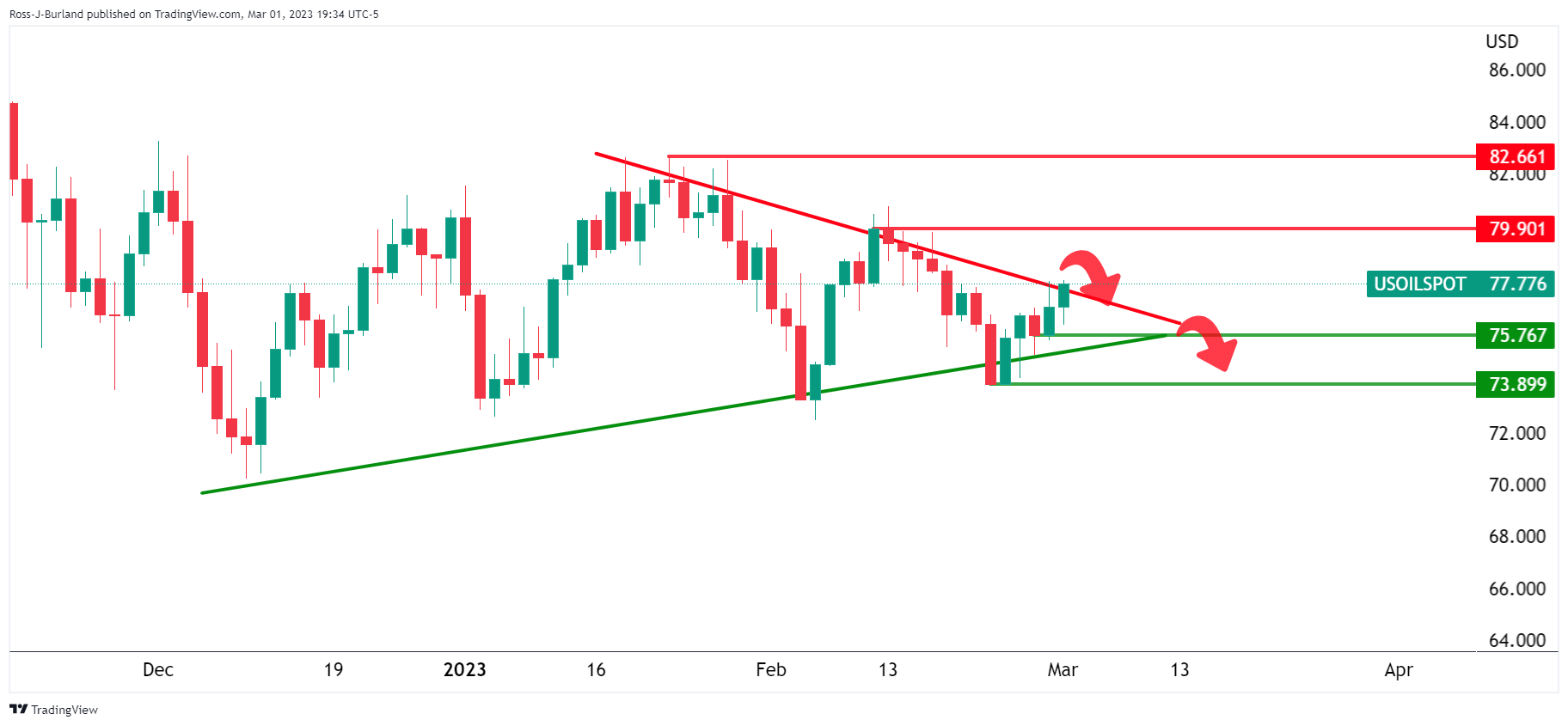
On the downside, a break of $75.76 opens the risk of a move to test $73.90 and below there is space for a significant bear trend top test $70.00.
| Index | Change, points | Closed | Change, % |
|---|---|---|---|
| NIKKEI 225 | 70.97 | 27516.53 | 0.26 |
| Hang Seng | 833.77 | 20619.71 | 4.21 |
| ASX 200 | -6.8 | 7251.6 | -0.09 |
| FTSE 100 | 38.63 | 7914.93 | 0.49 |
| DAX | -60.12 | 15305.02 | -0.39 |
| CAC 40 | -33.68 | 7234.25 | -0.46 |
| Dow Jones | 5.14 | 32661.84 | 0.02 |
| S&P 500 | -18.76 | 3951.39 | -0.47 |
| NASDAQ Composite | -76.06 | 11379.48 | -0.66 |
- USD/JPY is making efforts in breaking above 136.20 amid solid US Treasury yields.
- S&P500 futures have added marginal gains, portraying a minor recovery in investors’ risk appetite.
- US New Orders Index PMI and Manufacturers' Prices Paid convey that the inflation situation is getting complex.
The USD/JPY pair is struggling to extend its auction above 136.40 while the downside looks supported around 136.00 in the Asian session. The asset is expected to continue its upside journey and deliver a break above the 136.40 resistance as investors are eyeing more rates from the Federal Reserve (Fed) to strengthen its defense in the battle against persistent inflation.
S&P500 futures have added marginal gains in the Asian session after a negative Wednesday, portraying a minor recovery in investors’ risk appetite, however, the overall market mood is quite risk-averse. The range of the US Dollar Index (DXY) looks capped after wild movements, is expected to display a contraction ahead.
It seems that the hawkish stance of Federal Reserve (Fed) policymakers has infused fresh blood into the US Treasury yields. The alpha delivered on 10-year US government bonds has scaled to 4%.
Considering the stubborn nature of the United States Consumer Price Index (CPI), Atlanta Fed President Raphael Bostic expected the central bank to push the terminal rate to the 5.00%-5.25% range. Apart from that, the Fed policymaker expects the central bank to keep the terminal rate elevated beyond 2023. Also, Fed chair Jerome Powell has been reiterating that a consideration of a premature rate cut could have a devastating impact on the inflation situation.
The release of the US ISM Manufacturing PMI on Wednesday has cleared that the price index is expected to deliver a rebound ahead. Feb PMI numbers failed to impress the street, however, New Orders Index and Manufacturers Prices Paid managed to convey that the inflation situation is getting complex. The order book looks solid as figures jumped to 47.0 from the expectations of 43.7 and the former release of 42.5. And, the Manufacturing Price Paid climbed to 51.3 vs. the consensus of 45.0 and the former release of 44.5, which indicates that Producer Price Index (PPI) might deliver a surprise upside ahead.
On the Tokyo front, back-to-back dovish commentaries from Bank of Japan (BoJ) policymakers are impacting the Japanese Yen. After dovish commentaries from BoJ Governor Nominee Kazuo Ueda and BoJ Deputy Governor Ryozo Himino, the current monetary policy has also been considered as appropriate by board member Junko Nakagawa. He cited “An expansionary policy is highly essential for supporting the economy and fueling wages.”
- USD/CAD defends the previous day’s bearish bias amid sluggish session.
- US Dollar traces yields to probe bears after US data, Fed talks renew inflation woes.
- Oil price fades China-inspired optimism after higher-than-expected inventories.
USD/CAD holds lower grounds near 1.3600 following its biggest daily slump in three weeks as the Loonie pair traders struggle to analyze mixed catalysts during Thursday’s sluggish Asian session.
The quote’s heavy fall on Wednesday could be linked to the market’s upbeat sentiment, as well as welcome prints of Canada activity data. Adding strength to the downside bias was the firmer Oil price, Canada’s main export item.
Market sentiment improved after Tuesday‘s softer US data contrasted with Wednesday’s strong China PMIs for February. On the same line were comments from China Finance Minister Liu He as he showed readiness to bolster the nation’s fiscal spending while also mentioning that the foundation of China's economic recovery is still not stable.
It’s worth noting that Oil price rose in the last two consecutive days to print the highest level since February 17, making rounds to $77.80 at the latest. In doing so, the black gold struggles to justify the previously upbeat sentiment as US Oil inventories grew more than expected, per the weekly data from the US Energy Information Administration (EIA).
Elsewhere, Canada’s S&P Global Manufacturing PMI for February improved to 52.4 versus 50.1 expected and 51.0 prior, which in turn challenged the USD/CAD buyers even as the US data renewed inflation fears. That said, the US ISM Manufacturing PMI details renew inflation fears as the headline gauge rose to 47.7 in February from 47.4 prior, versus the 48.0 expected. However, the PMI details suggest that the Prices Paid and New Orders marked the highest figures in five and four months respectively.
It should be observed, however, that the hawkish Fed bets and firmer US Treasury bond yields, coupled with the higher Oil inventories appear to challenge the USD/CAD bears afterward.
On Wednesday, Minneapolis Federal Reserve (Fed) President Neel Kashkari said, "Wage growth is now too high to be consistent with 2% inflation." The policymaker also added and noted that it is concerning that the Federal Reserve's rate hikes so far have not brought down service inflation.
Additionally, the US 10-year Treasury bond yields rose to the highest levels since early November 2022 by poking the 4.0% mark whereas the two-year counterpart rallied to the June 2007 levels by piercing the 4.90% mark. The jump in the US Treasury bond yields suggests the market’s fears of inflation and recession, which in turn probed bulls on Wall Street and weigh on S&P 500 Futures of late, signaling a rebound on the US Dollar.
Amid these plays, the USD/CAD bears kept the reins but are likely to struggle as a light calendar and a shift in sentiment looms.
Technical analysis
A clear downside break of the two-week-old ascending support line, now resistance around 1.3630, directs USD/CAD towards a late January swing high near 1.350.
| Pare | Closed | Change, % |
|---|---|---|
| AUDUSD | 0.67587 | 0.47 |
| EURJPY | 145.339 | 0.93 |
| EURUSD | 1.06693 | 0.89 |
| GBPJPY | 163.815 | 0.18 |
| GBPUSD | 1.20257 | 0.09 |
| NZDUSD | 0.62559 | 1.18 |
| USDCAD | 1.35907 | -0.36 |
| USDCHF | 0.93962 | -0.25 |
| USDJPY | 136.222 | 0.08 |
- US Dollar Index remains depressed after downbeat start of the month.
- Economic recovery hopes from China join the absence of major geopolitical negatives to favor DXY bears.
- Mixed US data, upbeat yields join hawkish Fed talks to tease US Dollar buyers.
- Second-tier US data, risk catalysts are crucial for fresh impulse.
US Dollar Index (DXY) struggles to regain upside momentum during early Thursday, following a downbeat performance the previous day. That said, a light calendar and a lack of moves elsewhere allow the greenback to extend the consolidation of the biggest monthly gain in five.
The greenback’s gauge versus the six major currencies dropped the previous day, following the strongest monthly run-up since September 2022, as China-inspired risk-on mood joined recently easy US data. However, the details of the US statistics join comments from the Federal Reserve (Fed) officials to highlight the inflation fears and keep the hawkish Fed bets on the table, which in turn challenge the DXY bears.
On Wednesday, the US ISM Manufacturing PMI details renew inflation fears as the headline gauge rose to 47.7 in February from 47.4 prior, versus the 48.0 expected. However, the PMI details suggest that the Prices Paid and New Orders marked the highest figures in five and four months respectively.
Elsewhere, Minneapolis Federal Reserve (Fed) President Neel Kashkari said, "Wage growth is now too high to be consistent with 2% inflation." The policymaker also added and noted that it is concerning that the Federal Reserve's rate hikes so far have not brought down service inflation.
It should be noted that strong prints of China’s Caixin and NBS Manufacturing PMIs for February join the Non-Manufacturing PMI for the said month to trigger the market’s optimism on Tuesday, which in turn weighed on the US Dollar’s haven demand. Following the data, China Finance Minister Liu He showed readiness to bolster the nation’s fiscal spending while also mentioning that the foundation of China's economic recovery is still not stable.
Against this backdrop, the US 10-year Treasury bond yields rose to the highest levels since early November 2022 by poking the 4.0% mark whereas the two-year counterpart rallied to the June 2007 levels by piercing the 4.90% mark. The jump in the US Treasury bond yields suggests the market’s fears of inflation and recession, which in turn probed bulls on Wall Street and weigh on S&P 500 Futures of late, signaling a rebound on the US Dollar.
Moving ahead, a lack of major data/events may restrict DXY moves ahead of Friday’s US ISM Services PMI, which becomes the key amid fears of strong services inflation.
Technical analysis
A clear downside break of the 104.85-90 support-turned-resistance comprising the one-month-old ascending trend line and the 200-day EMA keeps the US Dollar Index bears hopeful.
© 2000-2024. All rights reserved.
This site is managed by Teletrade D.J. LLC 2351 LLC 2022 (Euro House, Richmond Hill Road, Kingstown, VC0100, St. Vincent and the Grenadines).
The information on this website is for informational purposes only and does not constitute any investment advice.
The company does not serve or provide services to customers who are residents of the US, Canada, Iran, The Democratic People's Republic of Korea, Yemen and FATF blacklisted countries.
Making transactions on financial markets with marginal financial instruments opens up wide possibilities and allows investors who are willing to take risks to earn high profits, carrying a potentially high risk of losses at the same time. Therefore you should responsibly approach the issue of choosing the appropriate investment strategy, taking the available resources into account, before starting trading.
Use of the information: full or partial use of materials from this website must always be referenced to TeleTrade as the source of information. Use of the materials on the Internet must be accompanied by a hyperlink to teletrade.org. Automatic import of materials and information from this website is prohibited.
Please contact our PR department if you have any questions or need assistance at pr@teletrade.global.
